A brief history of motoring clubs of Malaysia and Singapore…and the region
Updated 15 November 2023
By Eli Solomon
“To write a chronological account of it all would result in something impossibly complicated, cross-referential, and decidedly heavy going,” wrote the late highly respected motor historian, Leonard Setright, about the social history of the automobile1.
So, too, would a full account of the clubs and motoring associations in South East Asia. Such a job would be better suited to the local experts and students of local history. But since this is uncharted territory in Asian motoring history, I shall attempt to fill this void in the history of the car clubs (and the Automobile Associations) as an amateur motoring enthusiast residing in Asia.
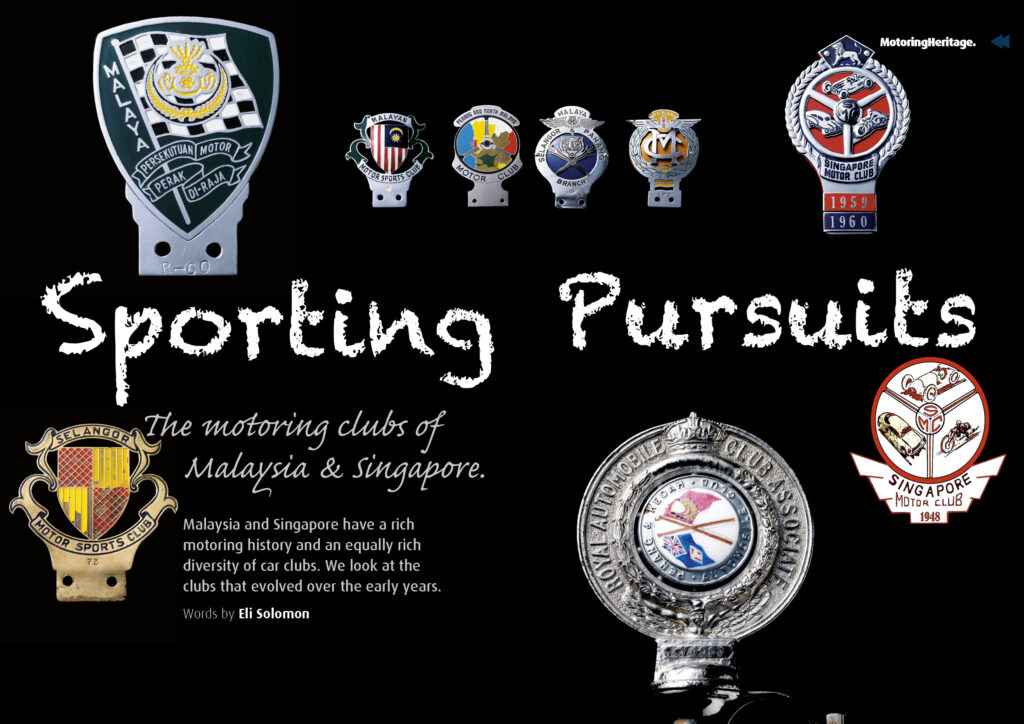
CLUB ETCH PRIMER
Admittedly this article on the more active clubs in Malaysian and Singapore (with a bit on the Philippines, Hong Kong and Indonesia) barely scratches the surface of the period following the formation of the first automobile club in the Federated Malay State of Selangor in 19032 until the early 1970s.
At the turn of the 20th Century, the automobile was already well on its way to transforming not only the way businesses operated in the region but the social life of its inhabitants.
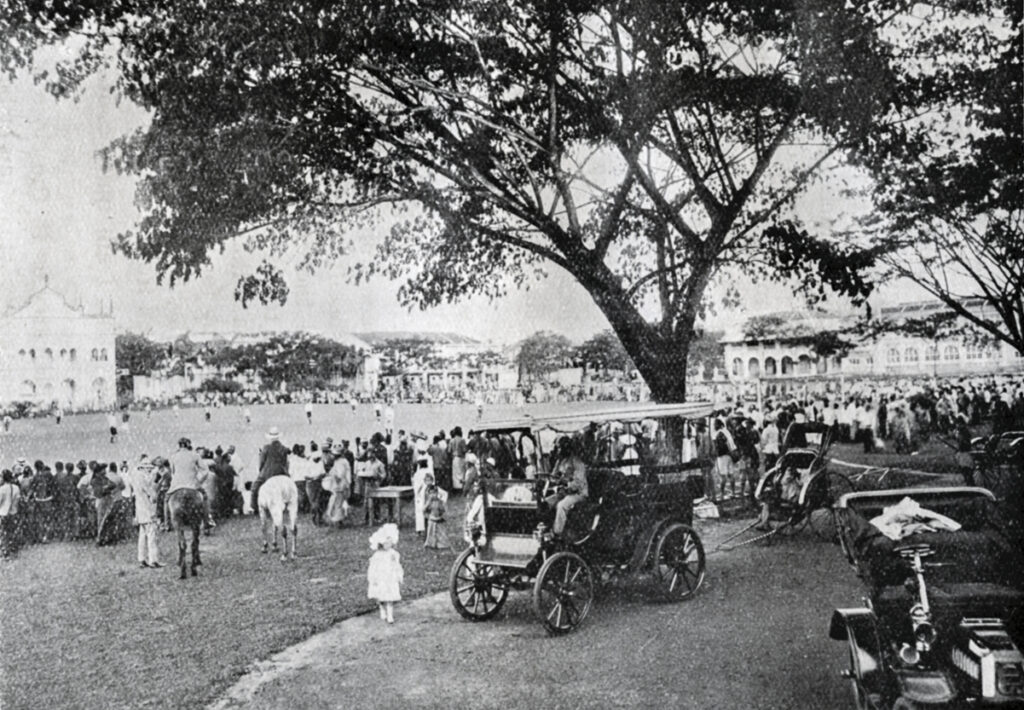
A G.R. Lambert & Co. photo of a soccer match in Kuala Lumpur at present day Dataran Merdeka (then known as the Selangor Club Padang) in 1903. Notice the motorcars and Gharries in the foreground. Source: Frank Swettenham’s British Malaya.
The days of sedate travel by bullock and cart were fast eroding and it was becoming common sight to see, as one local journalist reported, “gharries and rikshas make haste to allow passage way for the cyclonic monster that pursues its flight through the bewildering maze of street life with never a mishap.” 3
To maintain a level of propriety on the roads, rules were drawn up and licenses issued to owners of motorised vehicles. A Light Locomotives Ordinance was published in 1905 for this purpose. It stipulated that motorised vehicles could not be wider than 6½ feet (nearly 2m) at their widest, had to have at least two wheels with brakes, and could travel at a maximum speed of 10 miles per hour, a speed that took into account the conditions of the road network, and heavy dependence on the more conventional modes of transport during that time.
In 1910, petrol was still only obtainable in eight towns – Penang, Taiping, Ipoh, Kuala Lumpur, Klang, Seremban and Singapore, the latter already establishing itself as a distribution hub for such products. Obtaining this elixir necessitated the dispatch of a letter by the motorist travelling from the north to one of the Kuala Lumpur firms distributing the substance and instructing them to send a supply to the Railway Station Master at Kuala Kubu in good time.4
A year later, petrol could be purchased for 1s. 9d. to 2s. 4.d5 a gallon from Penang, Taiping, Ipoh, Kuala Lumpur, Klang, Seremban, Malacca, and Singapore. More important was the ability to converse in Malay, or at least know a few words of the local tongue. Many of the Europeans had a Malay driver, primarily to assist with tyre changes.
CHARTING A COURSE
The motoring world was undergoing a period of embryonic and erratic growth and there was no single governing body to oversee the clubs that were sprouting up. The formation of the Automobile Club of Great Britain (and, later, Ireland) in August 1897 had little bearing on the clubs in the Commonwealth until 1907 when, by Royal Charter, it became the Royal Automobile Club (RAC). The RAC exercised a great deal of influence as the governing body for motor sport in Britain and her colonies. It was quick to expand beyond Britain and soon represented motor clubs throughout the British Empire. These clubs were recognised as Royal Automobile Club Associate Clubs and had their own badges for their members.
Formed in 1905, the Automobile Association of Great Britain (AA) served a different and more practical function. The AA’s original function was to monitor the police and warn its members of any hidden police speed traps. The AA metal badge prominently displayed on the dash or the radiator of cars indicated membership of the Association, and AA monitors on the road gave advance warning to these drivers of any police activity ahead. The badge soon became known as “the badge of a law breaker” and AA gained the reputation of being the “number one enemy” of the traffic police.
While the RAC oversaw motor sport activities organised by associate clubs for their members, the AA represented the everyday motorists with its growing network of services. Being a member of the AA carried a measure of prestige while an RAC member was seen as a motoring enthusiast, inclined towards more sporting pursuits.
Prior to the establishment of a unified automobile association in Malaysia and Singapore in the early 1930s, the larger motoring clubs here were affiliated with the RAC. This would change once the Automobile Association of Malaya (AAM) was established in 1932.
The rapid extension of the road system across Malaya gave impetus to the formation of an “all-Malayan” organisation that was led by the Penang and Kedah Automobile Association.
Much of this has been documented extensively by local experts in newspapers, magazines, books and social media. However, a collective piece on the clubs and motoring in region has yet to be seen by this writer, hence this article that briefly touches on the history of the clubs.
EARLY YEARS OF THE CLUBS
Federated Malaya States Automobile Club (Selangor) – 1903-1905
The Federated Malaya States Automobile Club was established in 1903 to represent the owners of a new mode of transport called the automobile. It was the first such club to be formed for motorists in South East Asia and predated the formation of Britain’s Automobile Association by two years.
In May 1903, residents in Kuala Lumpur were treated to the country’s first ever motorcar show – a 15-car parade! By September that year, the Club boasted 18 members. At the end of 1904, Selangor had over 36 motorcars registered. The Club ceased to exist on 21st November 1905 as a consequence of dwindling interest and a general lack of events offered. An attempt was made to resurrect the Club in January 1909 but nothing came of it.
Ipoh Automobile Club/Perak Motor Union – 1907-1931
Initially referred to as the Ipoh Automobile Club, it was officially renamed the Perak Motor Union in July 19076. Ipoh, a bustling city of tin miners, was also known as the “hub of Malaya”.
The renamed Club’s first event was a motor gymkhana in August 1907. It was the first regional motor union to seek affiliation with the Motor Union of Great Britain and Ireland (until February 1908, a part of the Automobile Club of Great Britain, forerunner of the RAC); other Colonial clubs with this affiliation were the Automobile Association of Bengal, the Automobile Club of Ceylon and the Motor Union of West India. The Motor Union of Great Britain and Ireland later merged with the AA of Great Britain in 1910 and ceased to exist under its original name thereafter.
The Perak Motor Union was eventually integrated into the AAM in 1932 – as the Automobile Association of Malaya (Perak Branch). At the time of the merger, the Perak Motor Union had over 300 members and Ipoh, the peninsula’s third largest town, had a population of over 53,000.
Penang Automobile Club – 1907-1931
The Penang Automobile Club had already been in existence as early as April 1907 as suggested by correspondence between the Club and the Singapore Automobile Club. Its founding members consisted of a cross-section of Europeans from varied backgrounds made up of Club Chairman Robert Young, a consulting engineer; William H. Rose, previously of the Public Works Department in Singapore; Otto Schule, a manager with merchants Katz Brothers; Alfred Zeitlin, a merchant; Hermann Jessen, an assistant with Behn, Meyer & Company; Alexander Bowers Smith, a broker; Charles Gall May, previously superintendent of Works and Surveys, Public Works Department Singapore; and David Alexander Murray Brown, General Manager of the Pinang Gazette Press.
The Club continued to function until circa 1909. A short period of hibernation ensued until its activities resumed on 17th January 1911. Like the Perak Motor Union, the Penang Automobile Club was integrated into the Automobile Association of Malaya in 1932.
Straits Automobile Club/Singapore Automobile Club – 1907-1931
The Straits Automobile Club7 was formed in March 1907 with Sir John Anderson8, K.C.M.G., Governor of the Straits Settlements, as its first President. It held its first official motoring event in June 1907, by which time the Club was referred to as the Singapore Automobile Club (SAC).9
The SAC’s founding members were made up of high-ranking Colonial officials. Sir William Taylor, the Club’s first Vice President, was Colonial Secretary of the Straits Settlements from 1902-1904 and Resident General of the Federated Malay States 1905-1910. The committee consisted of luminaries such as Sir Walter John Napier, a Freemason, joint founder of law firm Drew & Napier and Attorney-General of Singapore from 1907-1909; Edward George Broadrick, British Resident of Selangor from 1913-1919; William Andrew Cuscaden, Inspector-General of Police of the Straits Settlements from 1906-1914; Dr David James Galloway, first President of the Straits Medical Association; and K.A. Stevens, long-serving manager of wine and spirit merchants Caldbeck, MacGregor and Co. When the first annual report was issued, membership stood at a respectable 56.
By the mid-1920s, the Club had started to organise motorcycle reliability trials on the island and even had its own competitions committee. The first Motorcycle Reliability Trial took place on 9 August 1925, a 75 mile run that commenced at the Borneo Motors office on Orchard Road and took entrants along Orchard Road, Tanglin Road, Alexander Road, Pasir Panjang Road, Buona Vista Road, Ayer Rajah Road, Reformatory Road, Bukit Timah Road, Jurong Road, Chua Chu Kang Road, Bukit Panjang Road, Punggol Road, Tampenis Road10 and back via Tanah Merah Road and Katong Road.
By September 1930, there were 374 members, although this figure would fall as a consequence of the economic depression. Like the other clubs in Malaya, the SAC represented both the interests of the regular motorist as well as those keen on the sporting aspects of motoring.
The SAC officially became a branch of the AAM in 1932. Accordingly, the old name was dropped in favour of Automobile Association of Malaya (Singapore and Johore Branch).
Selangor Automobile Association – 1921-1931
The first reference to the formation of a motor union in Selangor came at a meeting held at the Selangor Club on Saturday 5th November 1921 where it was unanimously decided that the State needed a motor union. It would take a further two years before the Selangor Automobile Association (SAA), with J.H.M. Robson as Chairman12. With the formation of the SAA came the prospect of motoring events like the ones that were taking place in Singapore. The first motor speed trial was held in Selangor on 5th August 1928. This annual hill climb took place on the old Ulu Klang Road and was run over a distance of half a mile.
As with the other clubs in Malaya, the SAA was integrated into the Automobile Association of Malaya in 1932.
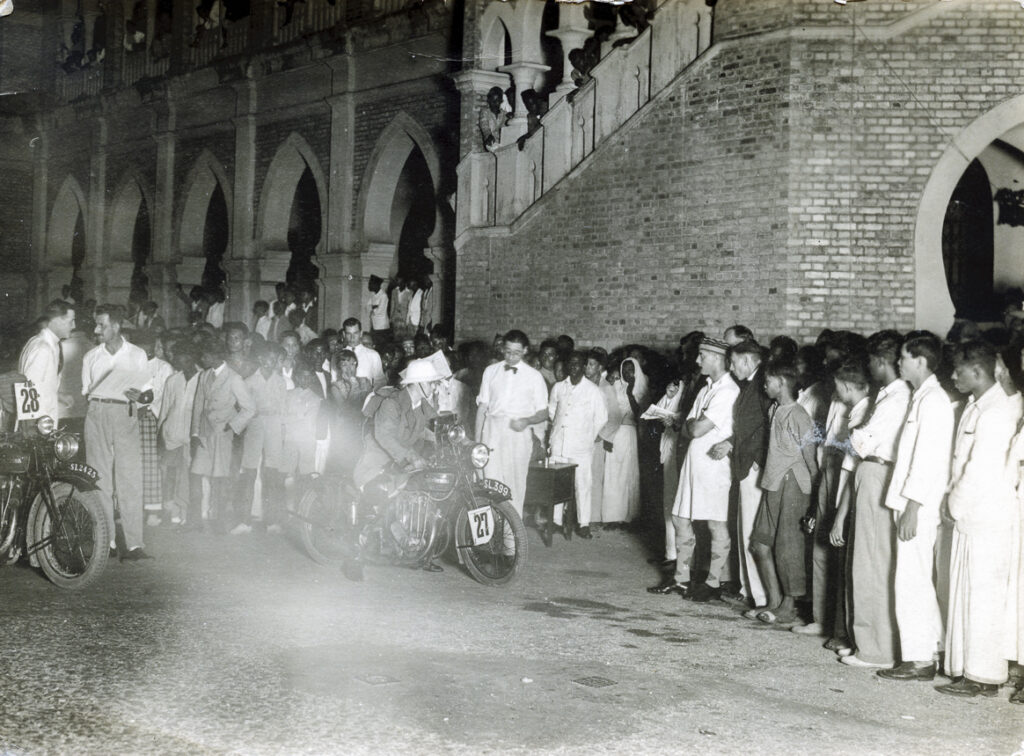
Start of 12.27am Selangor Automobile Association’s 19 May 1929 341 mile (25mph) Reliability Trial with Rex Duncan in the #27 bike.
Negri Sembilan Motor Association – 1924-1931
The Negri Sembilan Motor Association was formed in November 1924. It represented locally based European interests but in May 1927, the Association embarked on a campaign to attract more local members.
The Association, aside from organising competitive events, submitted views from members on road infrastructure to the Public Works Department and dealt with insurance matters for its members. It even handled the odd case such as one “involving noise and drunkenness on the part of Tamil coolies who [were] in the habit of frequenting the Rahang Road toddy shop”.
In December 1927, an ambitious hill climb was organised by the Association that included 16 different classes for motorcycles and cars. The Association, like the others, was eventually merged into the Automobile Association of Malaya in 1932.
THE UNIFYING FACTOR
Malayan Automobile Club/Automobile Association of Malaya – 1932-present
The idea of forming a single body for the motoring clubs in Malaya surfaced as far back as the mid-1920s when several of the existing clubs and associations gathered to discuss an amalgamation proposal for the creation of a single unifying entity to represent the needs of motorists throughout Malaya (which included Singapore).
The rapid extension of the road system across Malaya gave impetus to the formation of an “all-Malayan” organisation. Led by the Penang and Kedah associations, a meeting was held in Sungei Patani in early February 1929 to discuss the formation of a “Malayan Automobile Association”.13 The delegates were: James Chalmers (Negri Sembilan Motor Association); Douglas S. Ainger (Selangor Automobile Association); 41-year-old Sir John Bagnall (Singapore Automobile Club) – He was Chairman of Straits Trading (1888-1954), escaped on the SS Kuala, reached Sumatra, then South Africa; William Jack (Penang and Kedah Automobile Club) – William Jack [d. May 1935] retired to Otford, Kent, in 1930, from the management of Lubok Segintah Estate, Kuala Ketil. He arrived in Malaya in 1902 to join the Caledonia division of the Penang Sugar Estates as an Assistant. He later joined Golden Hope and Ebor in Selangor, Tanjong Pau in Kedah and Sungei Sayong in Johore; F.N. Pearse (Perak Motor Union) – F.N. Pearse arrived in Malaya in February 1918. With Hitam Tin in September 1920. Ipoh-based, served in WWI, rank Lieutenant; Arnold Savage-Bailey; C.C.J. Briscoe, who had participated in an Austin Seven in the Selangor Automobile Association Hill Climb in June and the Seremban Hill Climb in December 1927, and later in Riley at the well-attended (73 entries!) May 1931 Selangor Automobile Association Hill Climb – C.C.J. Briscoe was a Kuala Lumpur lawyer for Messrs Pooley and Co.; Rex Duncan14 and Borneo Motors’ Archie Wigginton (Selangor Automobile Association) – John Edward Archibald ‘Archie and the Wig-Wogs’ Wigginton was also on the committee of the Selangor Automobile Association in 1929. He had left Malaya in the early 1930s, where he had been a manager of several branches of Borneo Motors; William Hay Pratt of W.H. Pratt Ltd in Seremban, MacLeod and Ross (Negri Sembilan Motor Association) – William Hay Pratt [b. 1891] was Vice-Chairman of the Negri Sembilan Branch of the AAM after its formation in 1932. He was on the committee in 1935. Pratt left for Switzerland to recuperate from a lung ailment in late 1936.
F.N. Pearse was elected Chairman. Draft rules were to be set up by a sub-committee of Federal Council member and well-known Kuala Lumpur lawyer, Arnold Savage-Bailey C.B.E.15, and Douglas Ainger. The functions of the Association included legislative issues, uniformity of road signs, improvement of main communications, traffic matters, and sporting events.
Representatives from the Perak Motor Union, the Singapore Automobile Club, the Selangor Automobile Association, the Negri Sembilan Motor Association and the Penang and Kedah Automobile Club laid out the objectives of the new Association. Rex Duncan’s proposal was that each of the associated bodies in Malaya should appoint two representatives to a central body to be called “The Malayan Motor Union”, to which all Clubs would affiliate. The MMU would then affiliate with the R.A.C. and this would allow the R.A.C. to take over control of motor sport in Malaya.
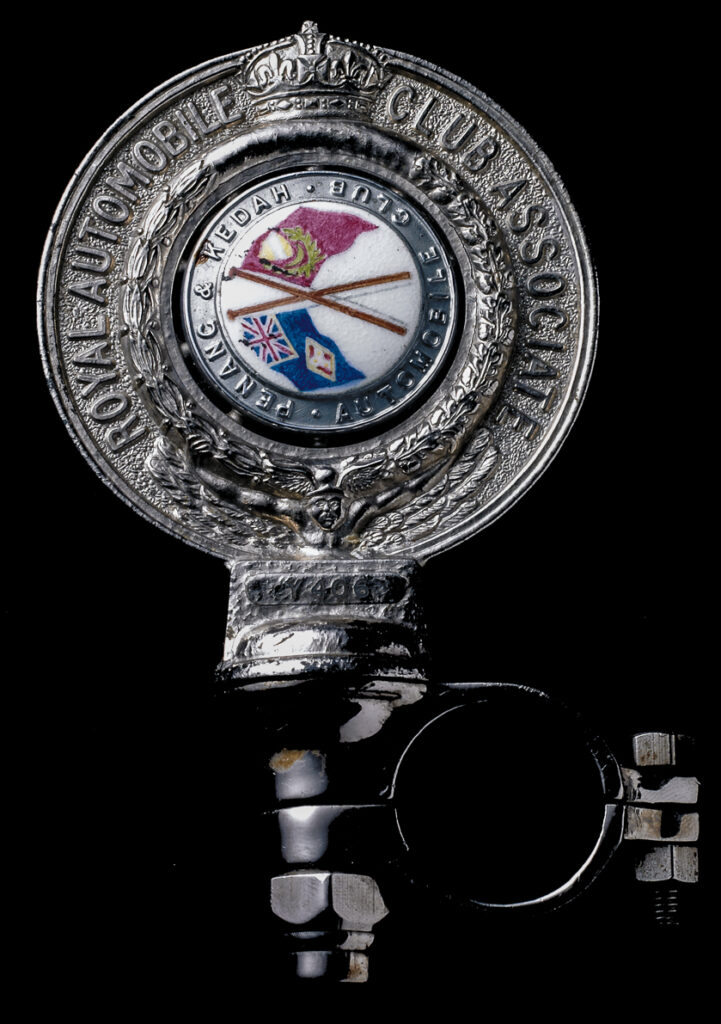
A rare Pre-1932 Penang & Kedah Automobile Club grille badge. The Singapore Automobile Club had a similar badge but instead of twin flags, a lion was depicted on a red enamel background.
It was not until mid-1931 that these clubs could agree to a unified set of objectives. A central organisation was created and was unofficially referred to as the Malayan Automobile Club. Rex Duncan16, rubber planter, keen motor cycle competitor, President of the Selangor Motor Cycling Club, and participant at the 1931 Isle of Man Lightweight TT Race, was its first fulltime Secretary, later on its General Secretary Duncan was later on the committee of the AAM for 1935 when James Arthur McEvoy17 was Chairman and Paul J. Dinsmore Regester18 was Vice-Chairman.
The Malayan Automobile Club was formally established on 1st January 1932 with its headquarters in Kuala Lumpur. The Club adopted Britain’s RAC badge with a tiger’s head in the centre on a yellow background.
The state of Selangor had the largest number of private registered cars (4,098) and paid-up members (567). This represented 12% of total membership in the new Club. Kuala Lumpur, the Federal Capital in Selangor, had a population of over 110,000. In comparison, Singapore had a population of over 550,000 and around 30% of the total motor vehicle population of Malaya. The various state clubs changed their names to reflect the unification. The Selangor Automobile Club, for example, now became known as the Malayan Automobile Club (Selangor Branch).
By February 1932, a decision was taken to amend the name of Malayan Automobile Club to Automobile Association of Malaya (AAM). The rationale was that the AA of Great Britain exercised a great deal of influence internationally. The “AA” letters carried a certain level of credibility and its members were assured of service in the event of breakdowns and accidents.
TIGER CUBS
The AAM was but an association without any teeth, let alone a voice that could sway legislation. It described itself as “…a body representing the majority of articulate private motorists in Malaya.”19 At the end of 1932, total membership was 1,924.20: 603 came from Selangor, 398 from Penang and Kedah, 375 from Perak, 163 from Negri Sembilan and 385 from Singapore. But things were happening, if not at the legislative level, certainly within the various Branches.
A new magazine was being contemplated and reciprocal agreements were endorsed between the AAM and various Associations in Britain’s colonies. The Association had provided legal, technical and general motoring advice, touring assistance, road information and other such services that included maps and itinerary suggestions, as well as appointing workshops and hotels for members.
RUDE REAWAKENING
Let’s skip a few less exciting years21 (in local motor sports history) and look at 1938, the start of an exciting three years for motoring enthusiasts in the region.
In early April 1938, it was revealed that a hill climb for cars and motorcycles was going to take place on Sunday 17 April 1938, organised by the Perak Branch of the AAM at a half-mile course in Gopeng. There would be an event for vintage cars (1928 and older) and a class for women. The hill climb was not open to the public and only AAM members could participate, the rules and regulations following the International Sporting Code and general competition rules of the RAC and the Auto Cycle Union of Great Britain.
The Negri Sembilan and Malacca folks upped their game and on 11 September 1938, a Speed Trial was held, the first time such an event had been held since one was held a decade earlier at Sikamat Road (now Jalan Sikamat). The September 1938 sprint took place at 1st Mile, Tampin Road (now Jalan Tampin). There were entrants from afar as Penang and Singapore – Kyle, Palmer’s (Norton agents in Malaya) director James L. Ross on his Norton, and Lim Peng Han, being two well-known motoring figures present. New records were established, Lim setting a new Malayan Half-Mile Sprint time of 29 seconds, beating Lawrence Van der Straaten’s22 1938 time of 32.8 seconds. Entrants included many who would play a major part in motor racing in the Far East after the war.
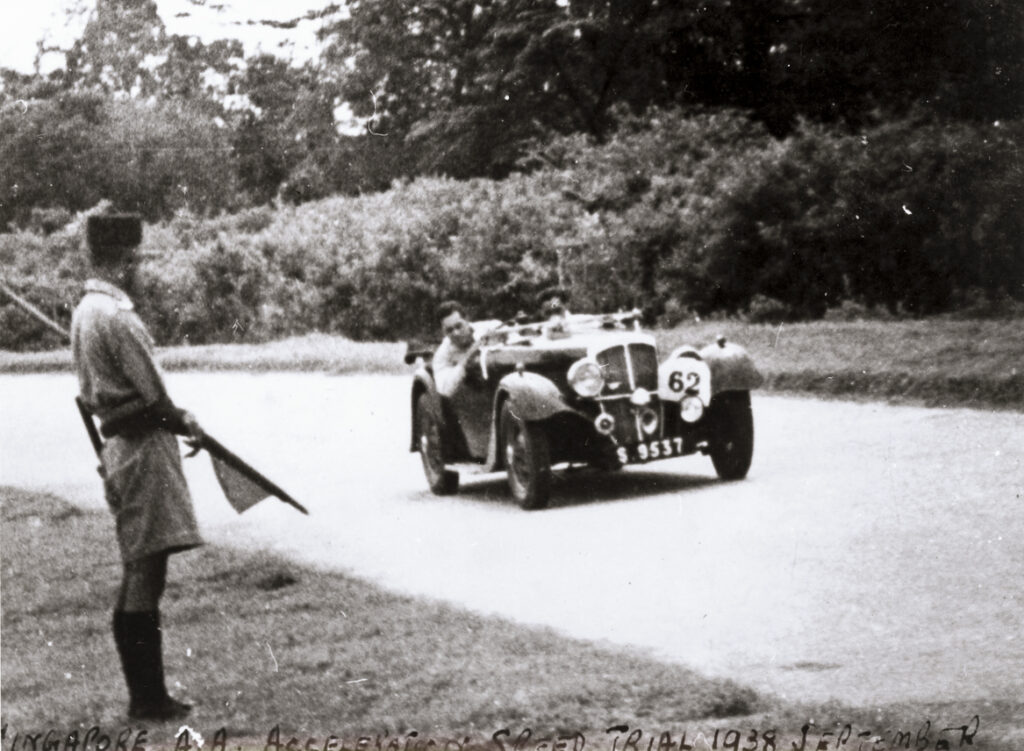
Cycle & Carriage’s Chua Boon Unn in his front-wheel-drive BSA Scout at the Singapore Automobile Association Acceleration & Speed Trial of 1938.
It was time from Singapore, with the biggest AAM membership in the region, to step up to the plate and on Sunday 25 September 1938, an acceleration test was held at Farrer Road.23, the first speed event since 1929! This epic event was a half-mile sprint. There was an attempt to turn this into an annual event but authority approval was not forthcoming when a request was submitted the following year.
In March 1939 the AAM’s Central committee consisted of ‘Tiger’ Coltart as President and Conrad Oldham as Vice-President. The committee consisted of army officer Lieut. Peter K. Braid, Straits Trading Co,’s 42-year-old Ewen M.F. Fergusson24, Capt. N.M. Hashim, Lieut. B.C. Jordan, Lim Peng Han, Ron W. McCreath, Percival Walter Frederick Mills.25, Cecil Prosper Liston26 (who was chief starter at the June 1939 Gap Hill Climb), John Samuel Radford27, Arthur Henry Stoneham28, 34-year-old then Headmaster of Outram School Ronald William Watson-Hyatt29 and Eric L. Williams. Those re-elected were Oldham, Fergusson, Hashim, Mills and Williams.
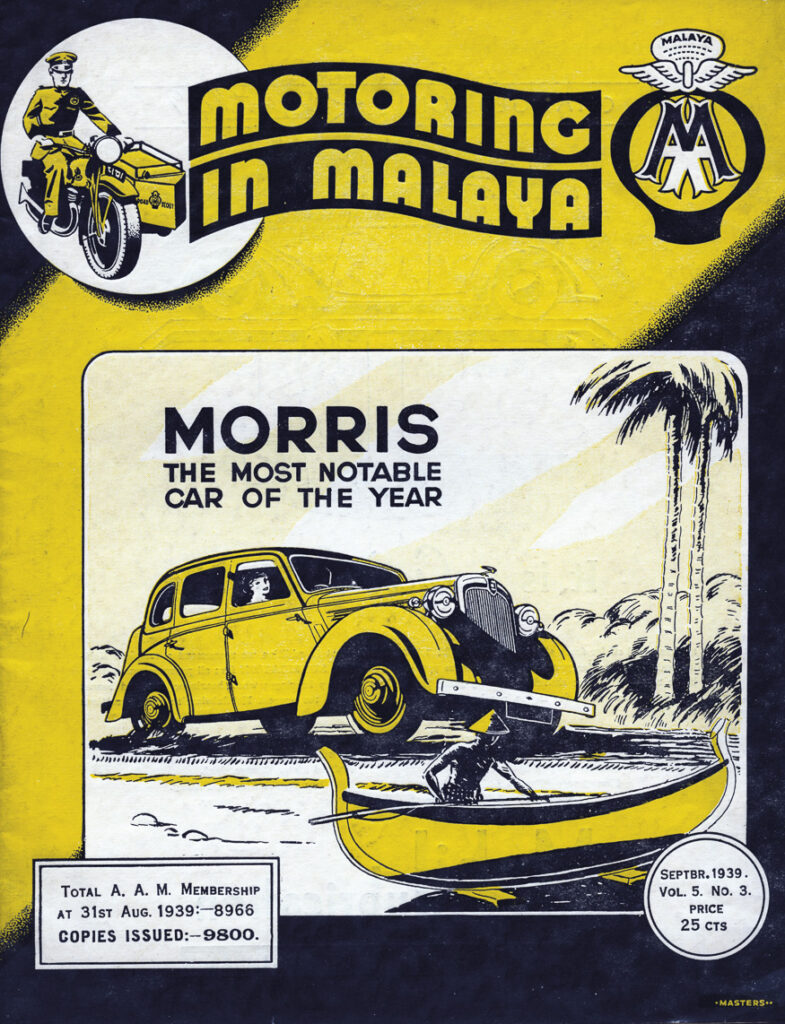
September 1939’s (Volume 5, No.3 issue) of Motoring In Malaya. The first issue of Motoring in Malaya appeared on 15 July 1935.
By mid-1939, the AAM had 8,748 members and its quarterly magazine, Motoring In Malaya, had a circulation of 9,600. President of the Central Office of the AAM was Paul J. Dinsmore, Registrar from Penang; Vice-President was Gilbert McCallum; ‘Tiger’ Coltart30 from Singapore. Selangor’s Branch was Chaired by Douglas Ainger; Perak by 37-year-old Bryan Noel Bintley31; Penang and Kedah’s by Penang’s Registrar of Vehicles, James Arthur McEvoy32; and Negri Sembilan by 43-year-old John Wishart33.
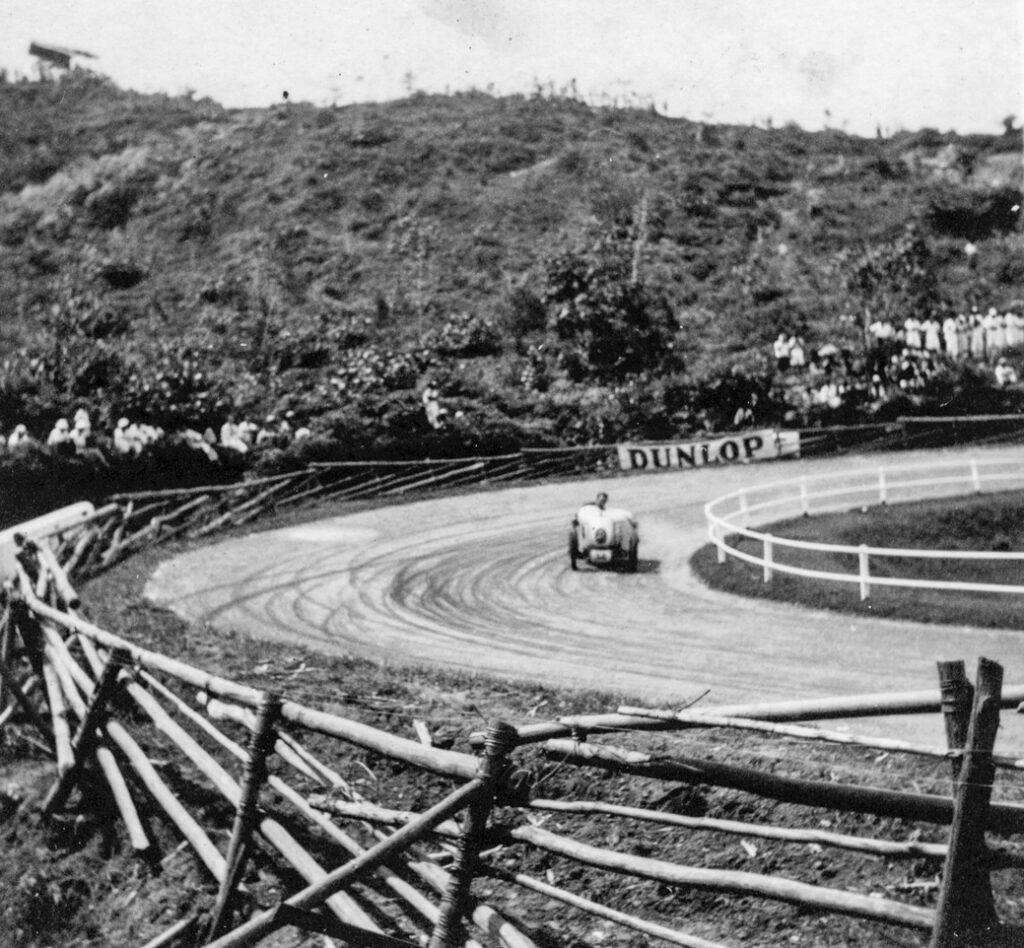
Roy Newman in his rebodied Austin 7 Special at the AAM’s Gap Hill Climb on 11 June 1939.
The new general committee of the AAM as of the AGM held in Kuala Lumpur on 20 August 1939 (for the year 1939-1940) consisted of ‘Tiger’ Coltart (Singapore) as President and Bryan Bintley (Ipoh) as Vice-President. As a result of Coltart’s position as President, Judge Conrad Oldham was elected Chairman of the Singapore and Johore Branch (Vice-Chairman was Lt. Peter K. Braid, R.A.); John Wishart was Chairman of the Negri Sembilan Branch; Douglas Ainger was Chairman of the Selangor and Pahang Branch; James McEvoy was Chairman of the Penang, Kedah, Province Wellesley and Perlis Branch and General Electric Co. Ltd’s John G. Clemetson34 was Chairman of the Perak and Dindings Branch. Membership consisted of 3,210 from Singapore, 1,687 from Selangor and Pahang, 1,550 from Perak, 1,446 from Penang and Kedah and 1,073 from Negri Sembilan and Malacca, for a total AAM membership of 8,966. The rapid rise in numbers had been helped by the influx of military forces from Britain and by the successful events held up and down the peninsula.
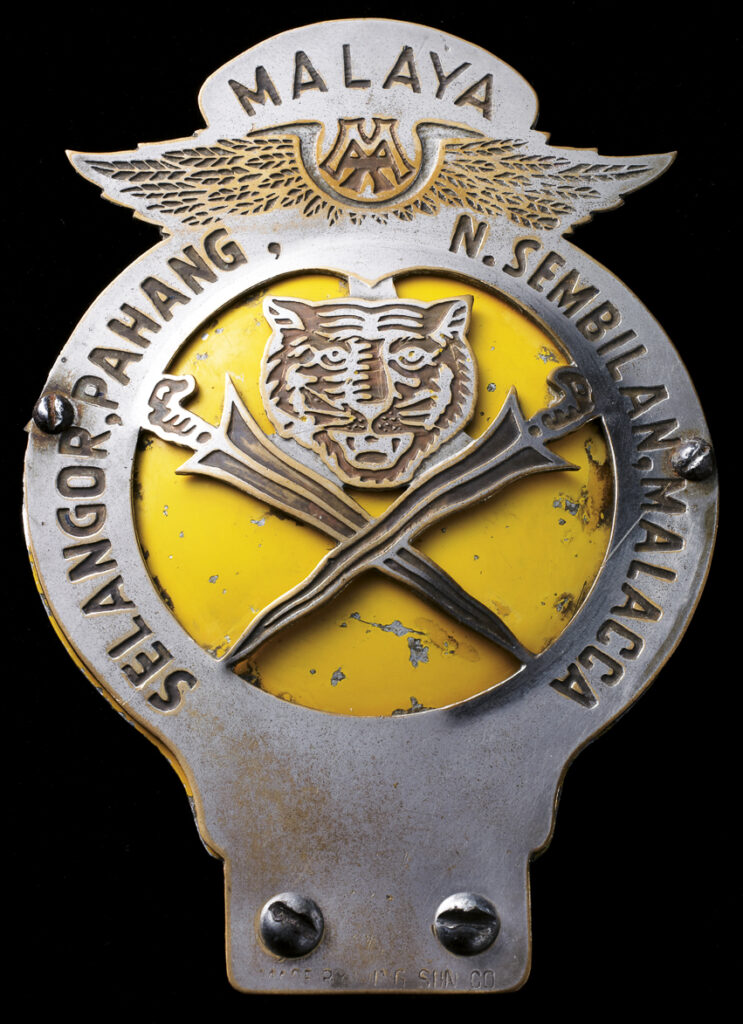
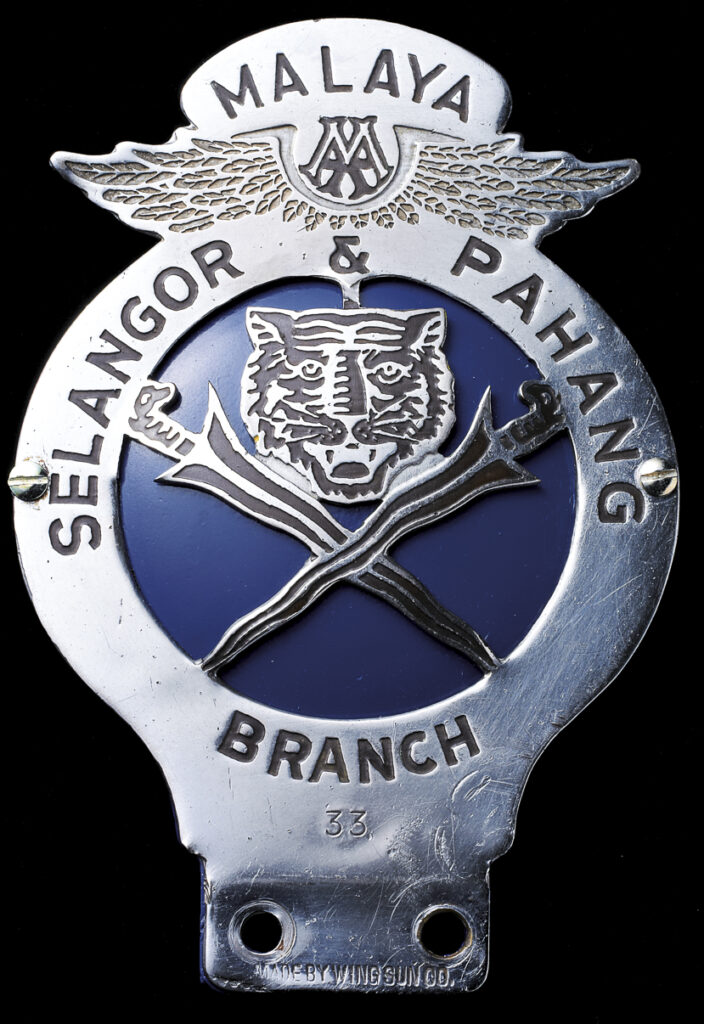
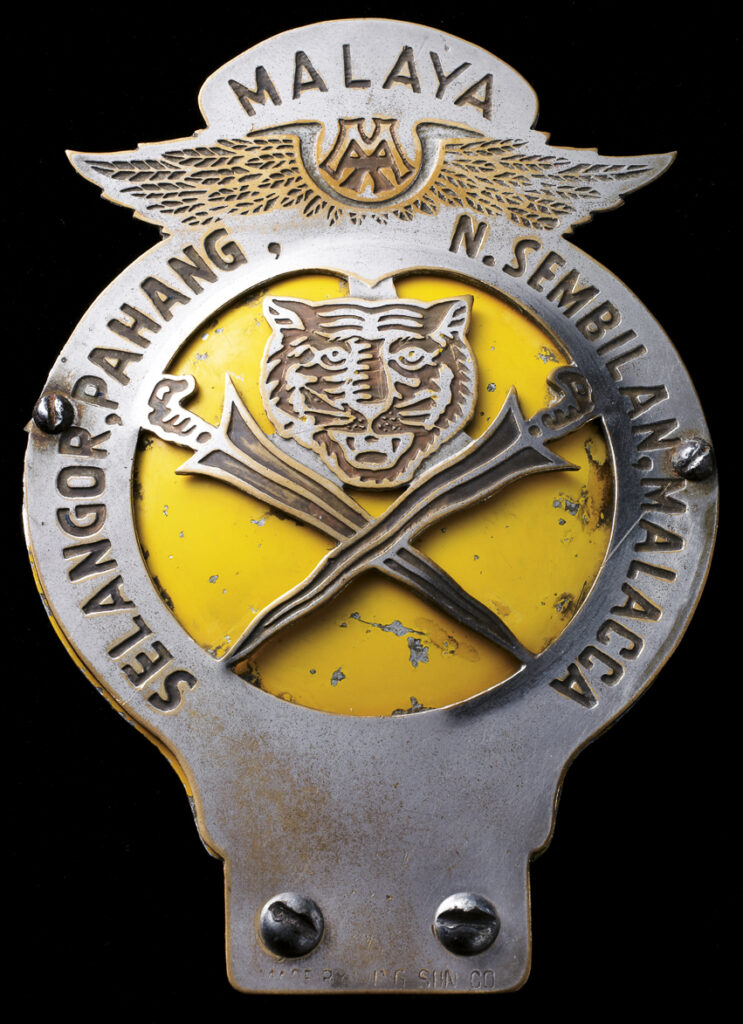
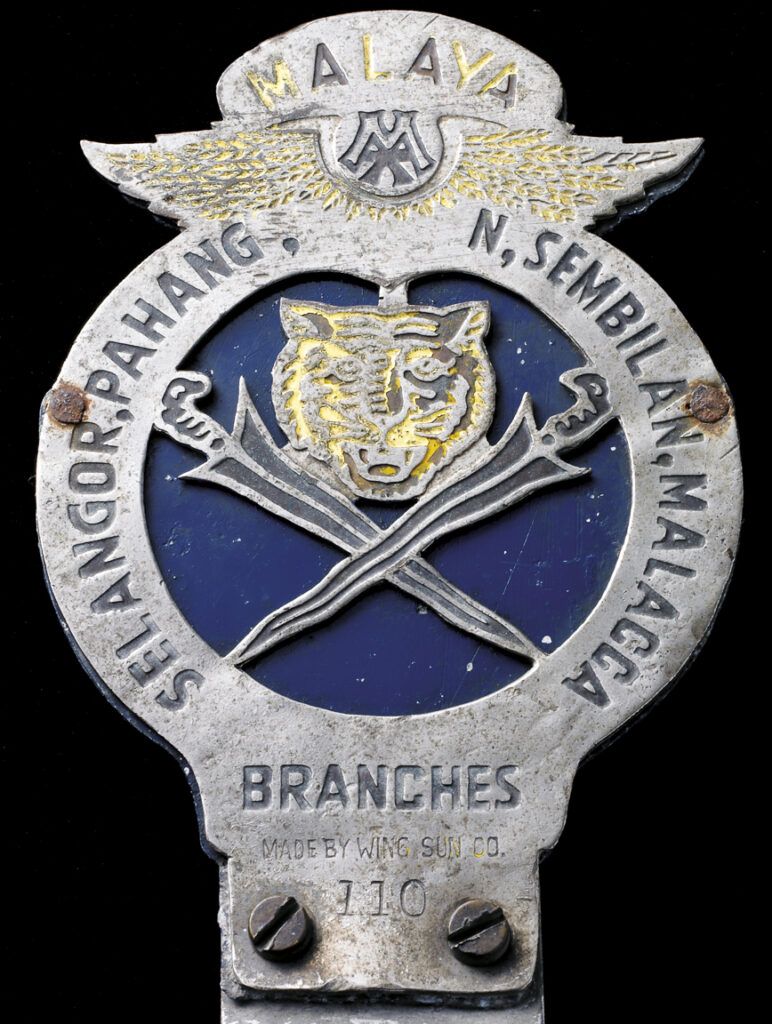
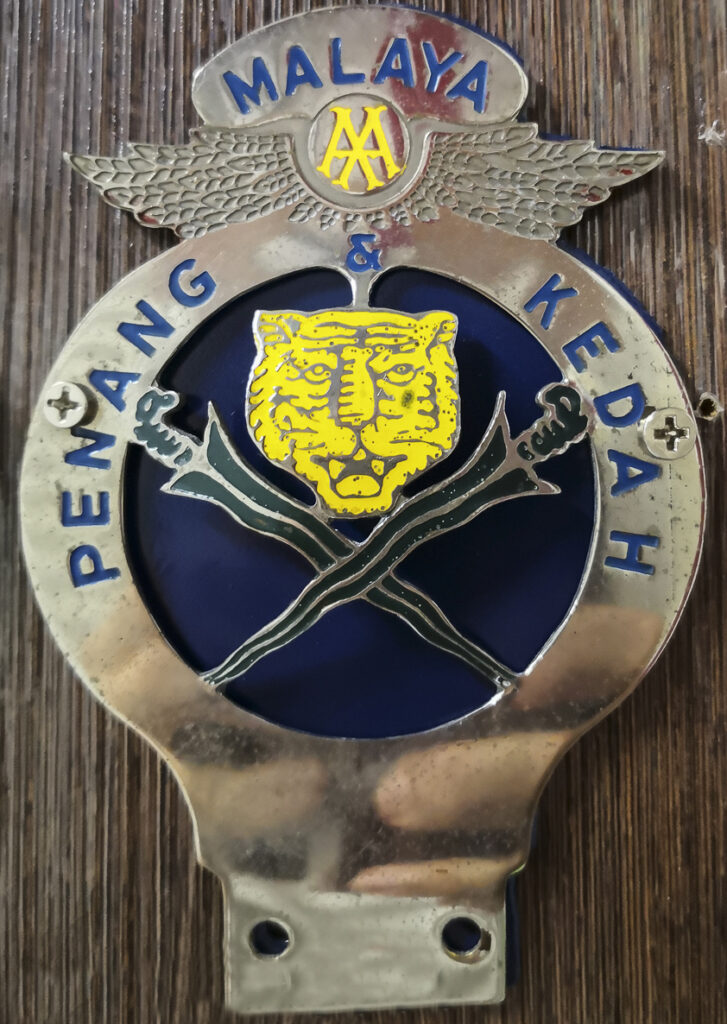
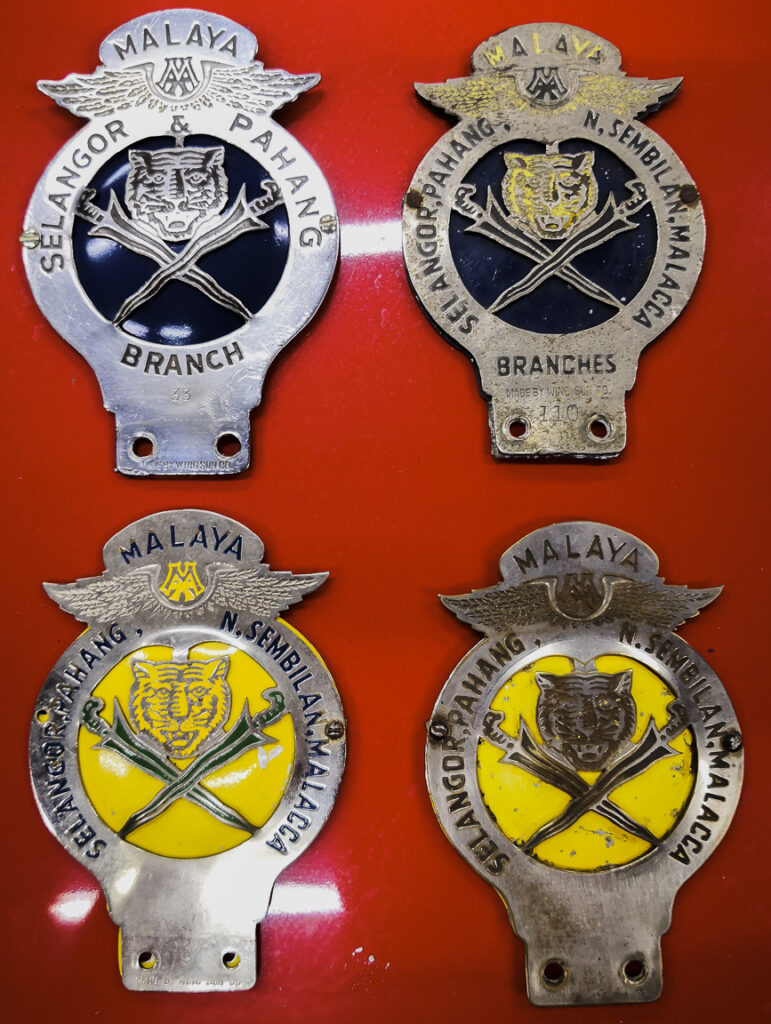
Domed or flat, yellow or blue…Branches or no branches, pre-war or post-war…the study of the AAM’s various grille badges35 after 1932 is a subject onto itself and best left to local historians in Singapore and Malaysia to cross swords over.
LAST HURRAHS
Here the writer introduces another character in the history of the AAM – Walter Chivers. Chivers was soon to be a key figure in the AAM. Based in Jakarta (then known as Batavia) during the late 1920s and 1930s, he travelling regularly to Singapore for Chartered Accountants Rennie, Lowick, and Co.
On Saturday 1 July 1939 the AAM officially opened its new offices in Singapore – at Nos. 21 and 22 Medeiros Building, Cecil Street. The press were told that this was due to the rapid growth in membership, thought ultimately it was Rennie, Lowick, and Co., AAM’s Company Secretary and Treasurer (who continued to handle AAM’s Central Office), who forced the AAM’s hand when the firm excused itself.
Walter Chivers had been handling all AAM matters for the previous two years and moved over as its Singapore Branch Secretary, a full time role he was to retain till his retirement in 1951. After the war he was instrumental in trying to get the AAM back on its feet, going as far as appealing for anyone who may have knowledge of the whereabouts of books, files and records of the Association in July 1946.
By mid-1939, the AAM had 8,748 members and a magazine circulation of 9,600.
On 19-20 February 1939, the AAM held its biggest event to-date, a two-day show that included a motor rally and ended with a Concours d’Elegance at the Sea View Hotel (1906-1964), followed by dinner and dance at the Adelphi Hotel (circa. 1850-June 1973). Sunday saw a gymkhana and treasure hunt.
Conrad Oldham was one of the Judges of the concours, together with Lady McElwaine36, a keen motorist herself, and fellow yachtsman, solicitor, and then Chairman of the Singapore Branch of the AAM, Mr G.M. Coltart37.
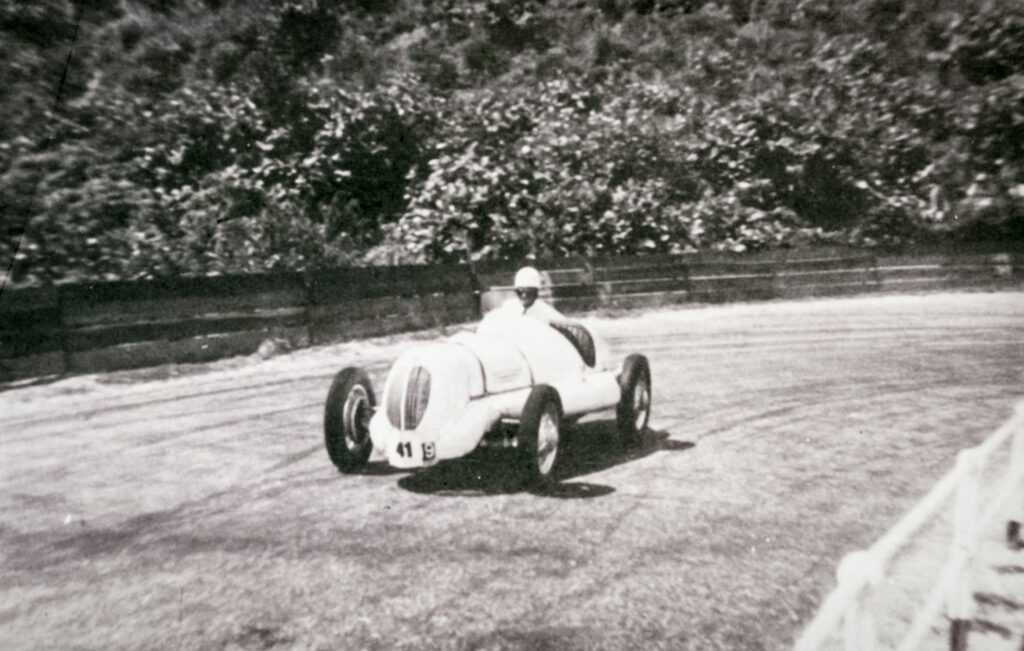
Conrad Oldham’s L.A. Ghost at the Singapore Gap Hill Climb in 1940.
In 1940, the committee of the Singapore and Johore Brach of the AAM consisted of a number of motor sports enthusiasts, led by Conrad Oldham. His Vice President was army man Lt. Peter K. Braid and his committee consisted of 35-year-old Australian lawyer and Volunteer Aide-de-camp to the Governor Sir Shenton Thomas, Charles Patrick Towers Burke38, 39-year-old veteran motorcycle racer Ron W. McCreath, 28-year-old Lim Peng Han39, 57-year-old lawyer Howell Dawson Mundell40, Neville George Reddish, W.L. Burton, J. Wilson, 59-year-old Legislative Council member Capt. Noor Mohamed Hashim41, Lieut. Peter Jermyn R.A., and 38-year-old Arthur Elsworth42.
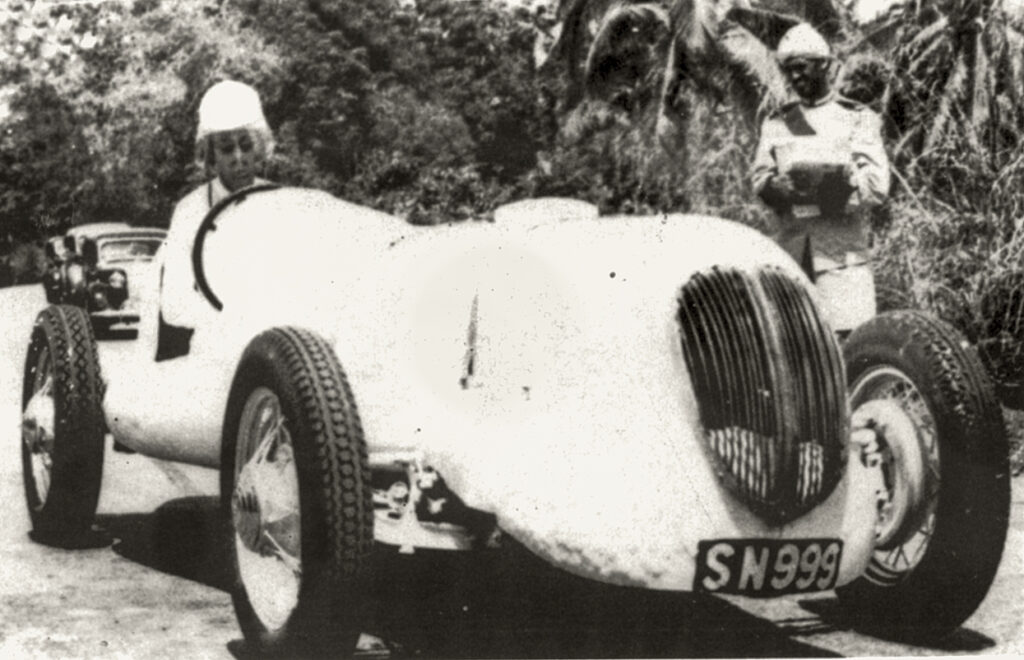
Conrad Oldham was Chairman of the Singapore and Johore Branch of the AAM from 1940 until the outbreak of war in February 1942.
Said Oldham at the AGM in April 1940… “The war had taught them that motor sport was not a thing which should be neglected, as they had seen one country build up foreign prestige and establish more firmly its foreign exchange by means of motor racing and its resultant export trade…we must fact the facts that although the Automobile Association of Malaya is the recognised body controlling motor sport in Malaya – recognized by the Royal Automobile Club and other governing bodies controlling motor sport in all other countries – motor sport here is still in quite an early stage of its development in sort of our organising speed trials, hill climbs, gymkhanas and driving tests…When times are more favourable we must anticipate considerable development so that the motor sport in this corner of Asia for which we are responsible takes its place with the motor sports of other nations until we see staged in Malaya events which can rightly bear comparison with theirs.”43
The war had taught them that motor sport was not a thing which should be neglected, as they had seen one country build up foreign prestige and establish more firmly its foreign exchange by means of motor racing and its resultant export trade…
The AAM’s biggest endeavour before things came to a crashing halt on 15 February 1942 was the Johore War Effort Grand Prix in November 1940. Not only was this the first ever such event in Malaya (and Singapore), it was the first ever Grand Prix hosted in Asia. The story of that event is documented in GENESIS & THE WINDS OF WAR.
The last Singapore and Johore branch committee prior to the Japanese invasion in February 1942 consisted of Oldham as Chairman and Theodore H. Stone as Vice-Chairman. Committee members were Major Peter Braid, Major Leofric Thorpe44, Capt. Noor Mohamed Hashim, Walter Burton45, Arthur Elsworth, William Jenkins46, Capt. Peter Jermyn R.A., Dr. Kwa Siew Tee47 and lawyer Sandy G. Pillay.
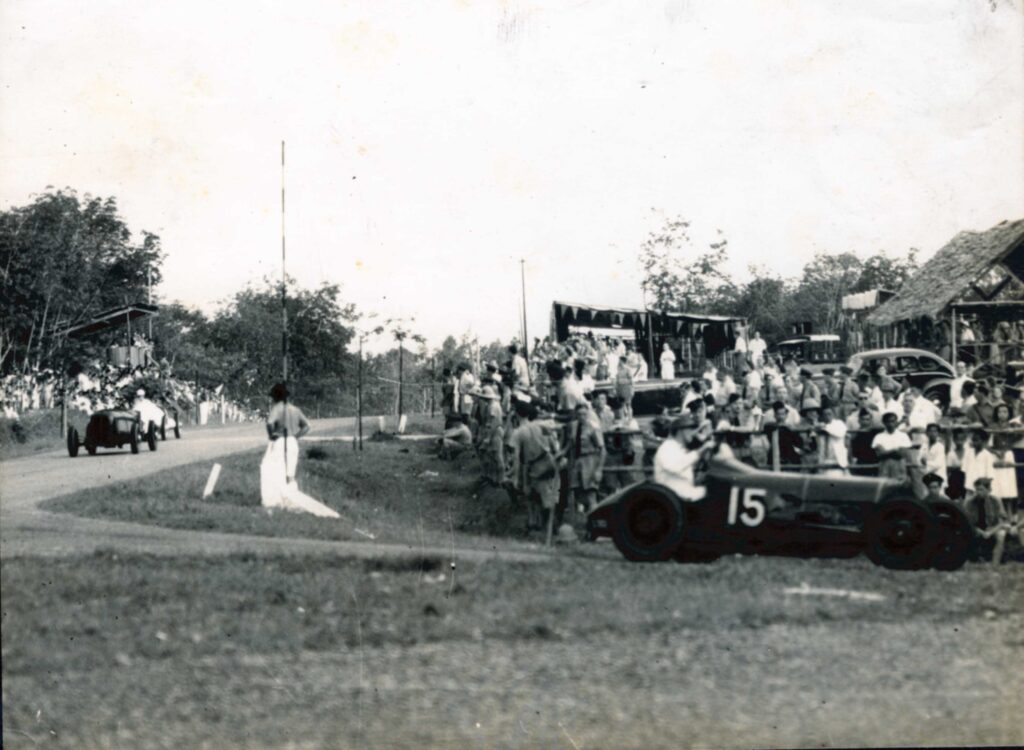
Racing on the streets of Johore for the 1940 AAM Johore War Effort Grand Prix in November 1940.
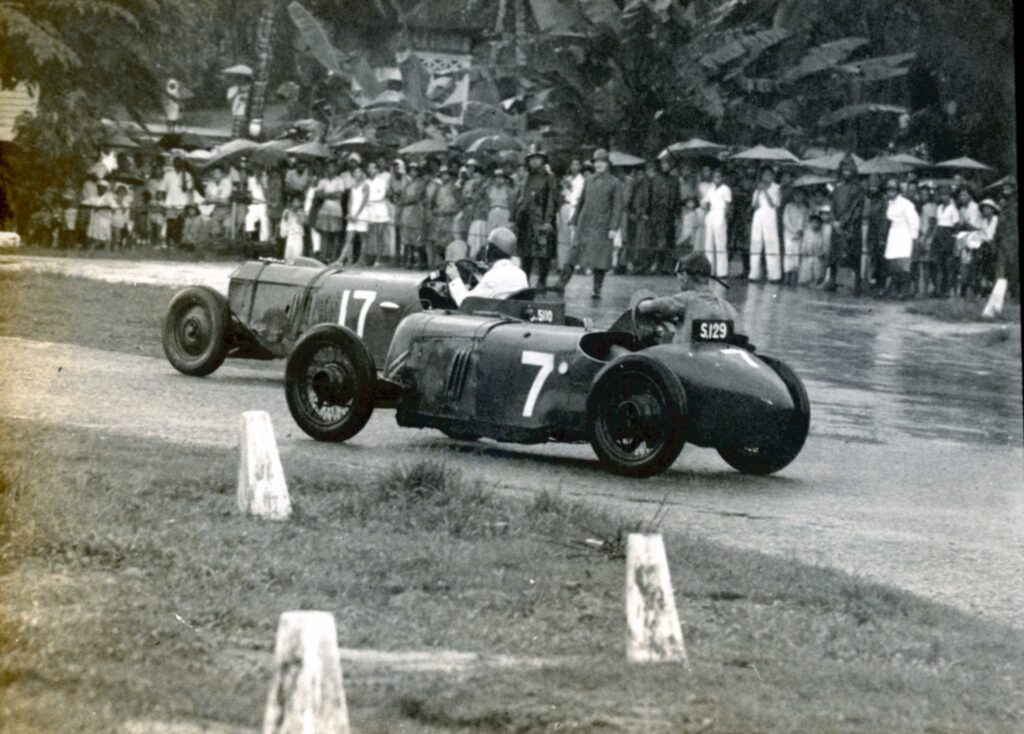
Racing in the rain…the 1940 Johore Grand Prix with two locally made Specials.
INTERLUDE
A reorganisation of the Association after the Japanese occupation was necessary as there were no remaining records, no office to speak of, and very few members who remained in Malaya. A committee was re-established in July 1946 and in November that year, a membership program began in earnest.
REBOOT
In July 1946 Chivers sent out an appeal – for the whereabouts of books, files and records of the Association. The first post-war meeting of the AAM was held on Wednesday 2 October 1946 at 5.15pm at the Adelphi Hotel. The accounts for the year 1941 and period 1 January 1942-31 December 1945 were ratified.
One of the last acts of the AAM’s Central Office was a donation to The War Fund. It came on the 11 February 1942 and amounted to a sum of $759.96, being “the balance in hand of the Malayan Motorists’ Fighter Fund.” Malayan Motorists’ Fighter Fund badges (in two different sizes) were issued, a well-designed and very rare item today, made even rarer by the secondary issue of another version with a “V” at the top. The proceeds were used to purchase a fighter plane48 which was presented to the Home Government. [see GERDA EXPOSÉ]
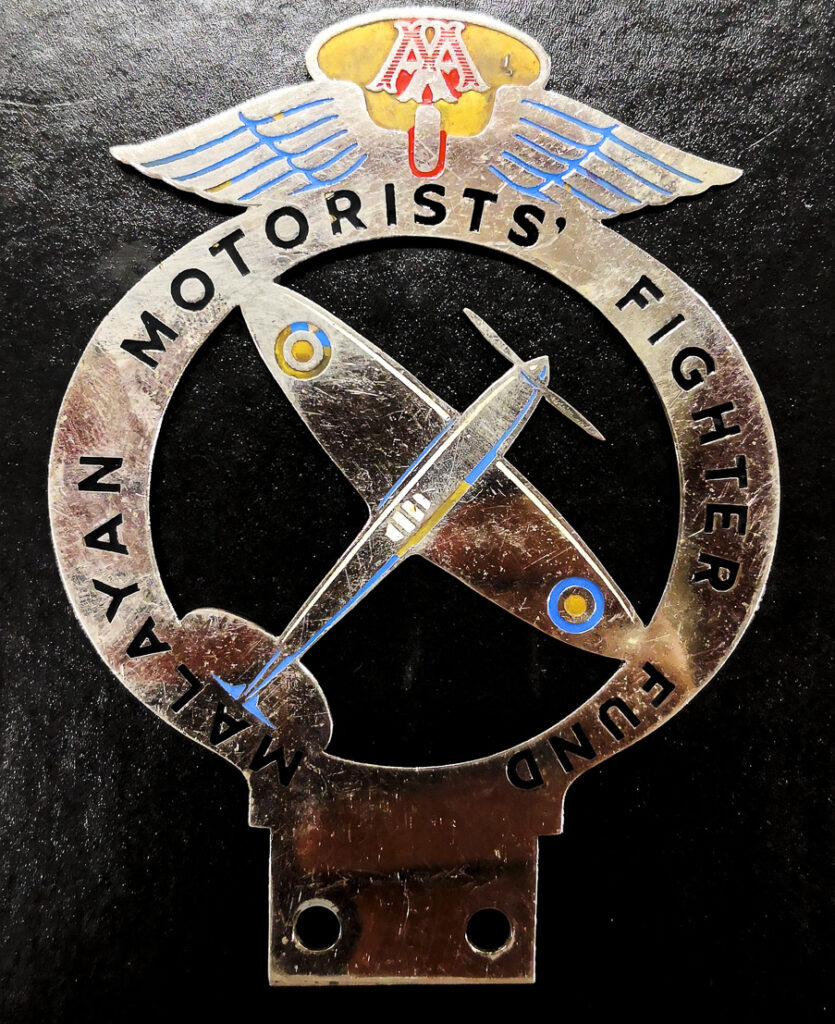
The funds generated from the sale of this grille badge by the AAM went towards a Supermarine Spitfire fighter plane by the name of Gerda (B.L.444 of the Royal Eagle Squadron). See GERDA EXPOSÉ for the story behind the badge.
Of course a new committee had to be elected in October 1946. The British Military Administration (BMA) was the interim administrator of British Malaya from August 1945 until the establishment of the Malayan Union in April 1946. Belief in the Colonial overlord had been severely shaken but the general population realised that a revived Malayan Civil Service was very necessary. Some of the old guard returned to their positions and could be counted upon to “assure order, justice and prosperity”49. Walter Chivers, now 66, had spent the war interned at Changi and Sime Road. When the Japanese invaded he was in the Volunteer Corps, as a Malayan Administrative Service (MAS) District Supervisor. He returned to the AAM as its General Secretary at the AGM.
As the dust began to settle, the AAM committee felt that a new badge was necessary. There were about 10,000 badges in circulation before the outbreak of war in Malaya and as a result of the Japanese occupation, many had been destroyed or “fell into the hands of various people, including taxi drivers and trisha riders.”50 A new badge was issued in 1947 with the first batch amounting to 2,000 pieces. The Singapore badge differed slightly from the pre-war issue in that the letters “AAM” were now concave with a yellow backing of non-ferrous metal.
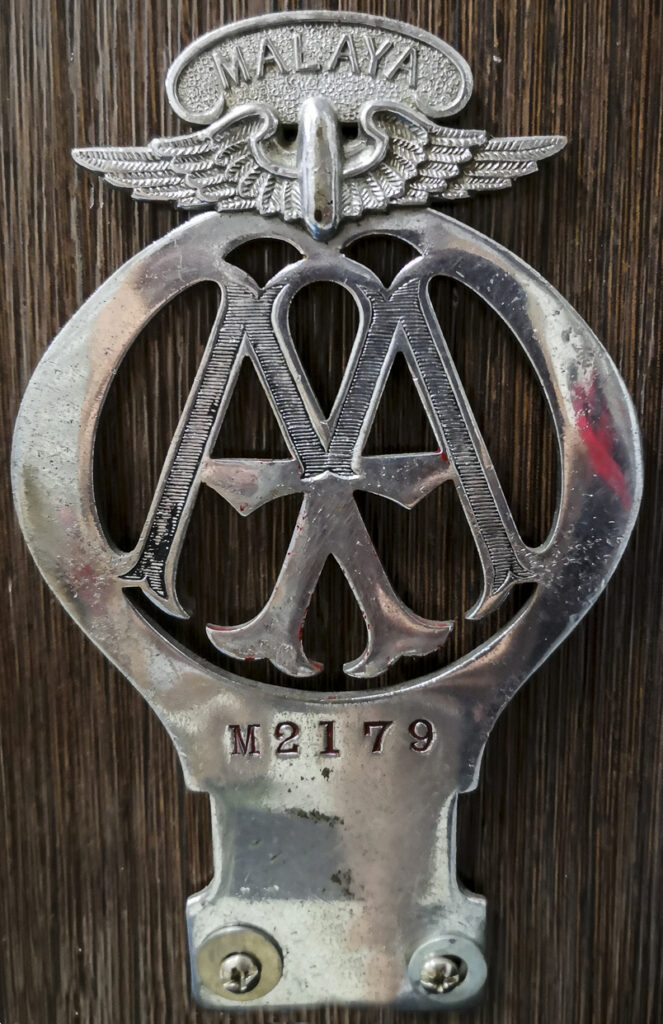
Pre-war AAM Badge.
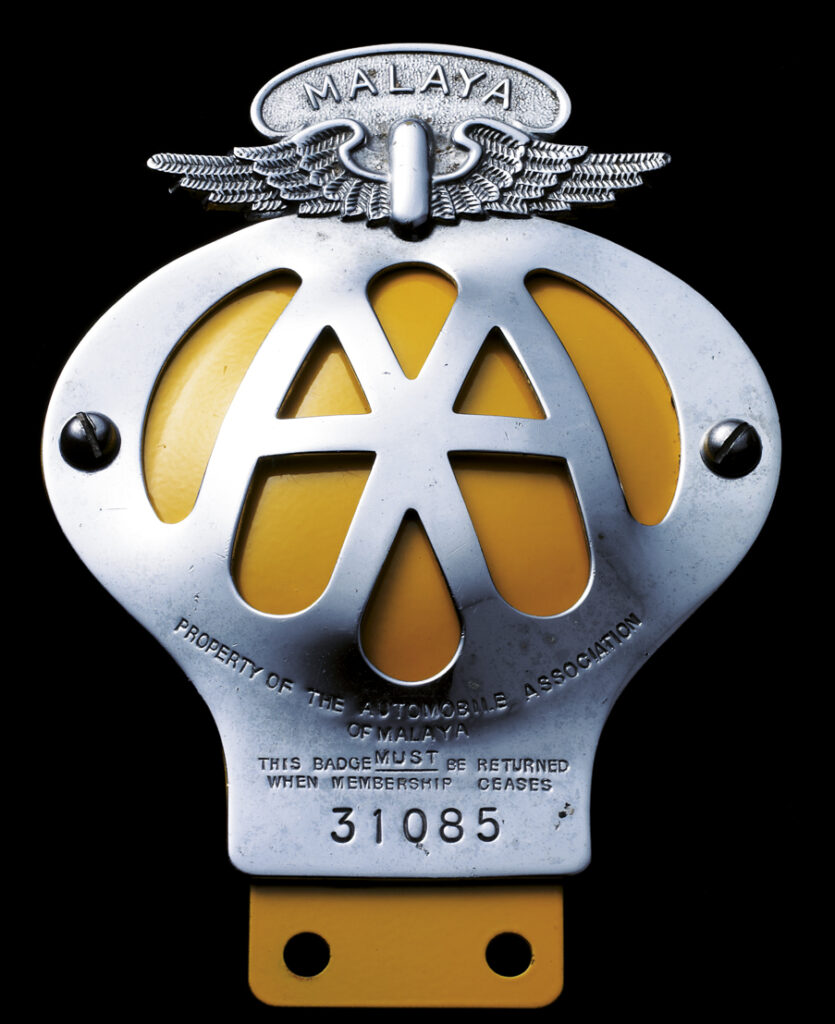
Post-war concave AAM Badge with, yellow backing.
On Wednesday 2nd October 1946 Chivers, already assisted by his wife Denise, revealed at the Association’s General Meeting at the Adelphi Hotel that the AAM had sufficient funds in investments and in the Post Office Savings Bank to resume its activities. There was a hint that subscription rates might have to be raised. We don’t know how long the meeting lasted. Exactly a week later, the Negri Sembilan and Malacca Branch held their Special Meeting at the N.S. Club in Seremban 9th October 1946). Acting Hon. Secretary, James Ralph Windsor Collett, was Commandant, North Area, during the Japanese occupation of Malaya and had lost his wife Marguerite (age 43) on the SS Tanjong Pinang when it was sunk by the Japanese in February 1942. 50-year-old John Wishart51was elected Branch Chairman with members of his committee consisting of Stevenson, John Frederick Brislin52, 43-year-old Raja Zailan Azman Shah bin Raja Sir Chulan53, Chin See Yin54and A.S. Emmanuel.
Perak held its EGM at the Ipoh Club earlier on Friday 4 October 1946, which John Gouldin Clemetson chaired. Clemetson had been Captain FMSVF HQ Company then attached to Royal Army Ordnance Corps (RAOC) when Malaya fell. He was interned at Changi and is best known for his remarkable efforts in the prison with Borneo Motors’ Captain Oliver Bellingham-Smith, mass-producing rubber shoes and dentures in Changi. He returned to Malaya post repatriation, working for GEC subsidiary Kinta Electrical Distribution Ltd. In Singapore Clemetson had already been elected Vice-President of the Central organisation on 2 October. The Penang and Kedah Branch of the AAM followed up with their resuscitation in December 1946, looking to enlist both old and new members.
The office bearers of the Central organisation of the AAM were: John Gouldin Clemetson55 of Ipoh as President; Theodore H. Stone from Singapore and Douglas S. Ainger from Selangor were elected Vice-Presidents. Secretary and Treasurer was Walter Chivers. The AAM’s office was then based at 11 Battery Road, above chemists Maynard’s premises.
SINGAPORE GRIP
The formation of the Singapore Motor Club in late February 1948 changed the landscape of things dramatically. Affiliated to the AAM, the SMC was now entrusted with running the sport for enthusiasts. Its first President was workshop owner and leading motor sports enthusiast, Charles Frederick Pope, and his committee consisted of club secretary Lim Peng Han, V.F. ‘Roy’ Kendall, Joseph Neil Kingsmill Moncrieff56 and K.E. Hopkins, all three Qantas engineers, Harry Marriot, L.E.G. ‘Legs’ Seagroatt[/efn_note]Lawrence Edmund George Seagroatt (b. 3 September 1910 in Sialkot, Punjab – d. 24 October 1968 in Kuala Lumpur, aged 58) relinquished his military commission (Captain) on 18 Aug 1947, and was granted the hon. rank of Major. He came to Singapore in 1946 and for a while was a War Crimes prosecutor. He later joined Firestone and Wearne Brothers in Kuala Lumpur as a manager. He returned to Singapore to join stockbroker Sassoon and Co. He contracted polio in Singapore. In 1959 he was made a partner in stockbroking firm Hallam and Co. before setting up the broking firm Seagroatt and Campbell in Malaysia in January 1961. [/efn_note], Eric L. Williams, and J.W. Jones.
Shortly after, the Singapore Motor Cycle Club was formed, organised by Cycle & Carriage’s Chua Boon Unn [See FROM A FEDERAL STORE – the history of Cycle & Carriage] on 9 June 1948. Interestingly Chua, later to become Managing Director of the company, ruled that only owners of BSA motorcycles would have voting and office rights! What became of this club is not within the scope of this book. In September the SMC held an Extraordinary General Meeting at the Raffles Hotel to elect a new committee. Pope retained the role of Chairman but new Secretary was P.D.O. Liddell, in place of Lim Peng Han. The new committee now consisted of Patrick James O’Neil ‘Paddy’ Darnell57, Paul J. Gibbs Pancheri, Eric L. Williams, Firestone’d 44-year-old Dennys Grantham Jackson58, F.J. Williams, Martin Ogle59, J.N.K. ‘Neil’ Moncrieff, 27-year-old private pilot and motor cycle enthusiast George Desmond Anthony ‘Tony’ Rignall, K.E. Hopkins and Harry Marriott, an entirely European-centric committee.
The 1948 Singapore AAM committee consisted of Cuthbert Alexander Bernard Starling as Chairman60. Theodore H. Stone61had retired as Chairman and moved to Melbourne, Australia in late 1948. Stone, a Municipal Commissioner, had been Vice-Chairman to Conrad Oldham on the Singapore and Johore Branch of the AAM committee before the Japanese invasion of Singapore in February 1942. Oldham had not returned to Malaya, nor had another pre-war Vice-President, Major Peter K. Braid RA.
GROWING PAINS
On 25 April 1948, the SMC held its first event, a hill climb at Bukit Batok, the 8th mile Bukit Timah Road at what included the property of Hume Pipe (Far East), Ltd. Stewards consisted of C.L. Williams, D.G. Jackson, L.E.G. ‘Legs’ Seagroatt, K.E. Hopkins and Peter Liddell. The race program was a simple 16 page affair and the author’s copy contains the individual times recorded by then SMC Secretary Lim Peng Han, who himself had entered a Fiat, MG, Fraser Nash-BMW and one of his L.A. Specials salvaged from the war.
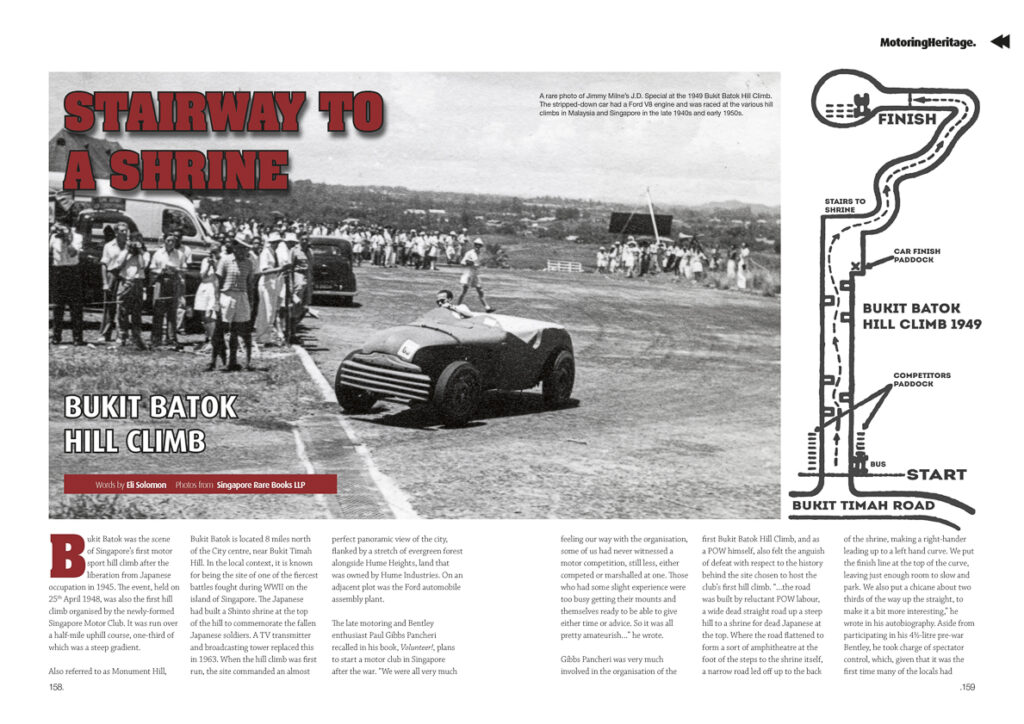
The history of the Bukit Batok Hill Climb was featured in Rewind Magazine Issue 019, July 2014. The car featured on this double page spread is Jimmy Milne’s Ford Mercury J.D. Special racing up Bukit Batok in 1949. Milne often referred to his car as the Junk & Dump Special.
By 1949, the AAM consisted of five branches: Singapore and Johore; Negri Sembilan and Malacca; Selangor and Pahang; Perak; Penang and Kedah. The Association also had an AAM Telephone Box erected at Clifford Pier Car Park in Singapore with a valet service that could be used by members who could call to have their cars delivered from the car park to their offices. There were more pressing issues than car parts and car park attendants.
Severe petrol rationing prevented, or at least discouraged, the motor sports community from organising events until 1949 when some relaxation of petrol rationing was expected. Malayan states had already faced years of rationing, most having instituted this from February 1941!
The Singapore Motor Club had already held three hill climbs and a sprint during the course of April 1948 and May 1949, independent of the AAM. The Perak Motorcycle Club, with the backing of the Perak Branch of the AAM, held a 350 yard speed trial at Gopeng on 4 July 1948 but that was the extent of events up country.
Over in Seremban, the Negri Sembilan and Malacca Branch of the AAM, under John Wishart62, felt it was time to organise something sorting, notwithstanding that “Motorists are rather ‘bandit-conscious’ these day.” A Half-Mile Standing Start Speed Trial on Rahang Road in Seremban was proposed for Sunday 5th June 1949. 50 percent of proceeds from the sale of the programs would be donated to the N.S.T.B. Fund63. Tong Kee Motors64of Seremban donated a rather impressive-looking Mercury Trophy. Even the program issued was impressive, containing past records and splashed with numerous advertisements from businesses in Seremban.
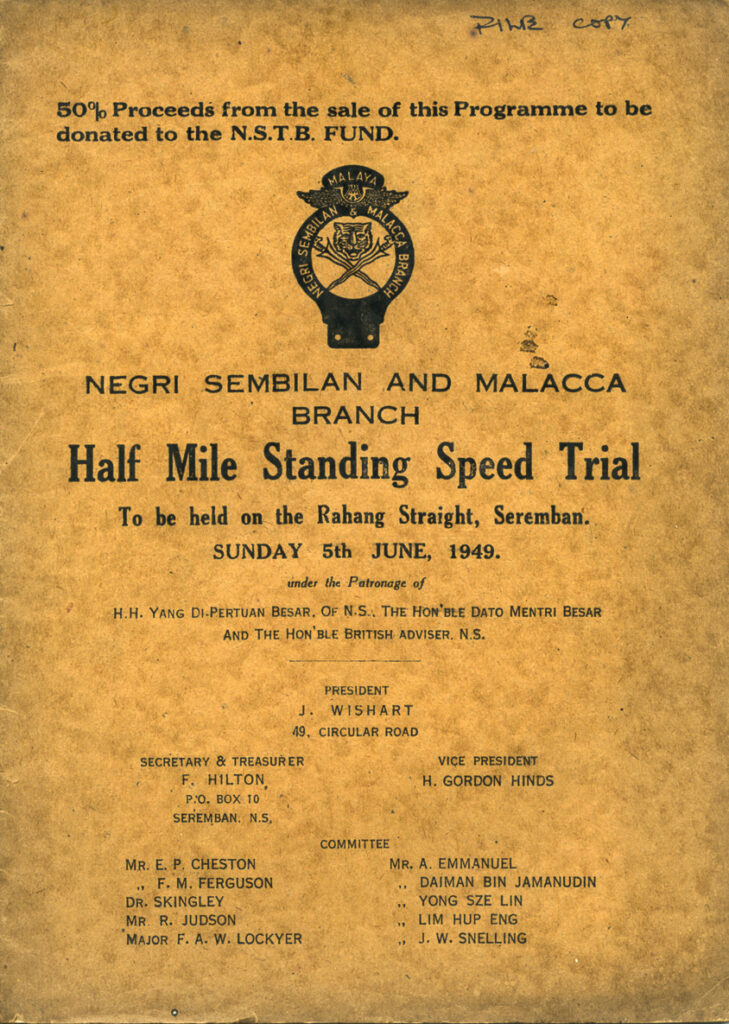
The Negri Sembilan and Malacca Branch of the AAM held a Half Mile Standing Speed Trial on Rahang Road in Seremban on 5 June 1949. Note the AAM branch badge on the program.
Even the program issued was impressive, containing past records and splashed with numerous advertisements from businesses in Seremban.
By 1949, the AAM consisted of five branches: Singapore and Johor; Negri Sembilan and Malacca; Selangor and Pahang; Perak; and Penang and Kedah. In Singapore, the Association had an AAM Telephone Box erected at Clifford Pier Car Park with a valet service that could be used by members who could call to have their cars delivered from the car park to their offices.
Automobile Association of Singapore – 1952-present
The Singapore and Johore branch of the Automobile Association of Malaya separated from the AAM in February 1952 as Singapore had opted to go its own way and form its own Automobile Association (AAS).
There was much consternation among some committee members over the separation; one committee member described the AAS as “a head without a body”. Regardless, the first Concours d’Elegance organised by the Association was held at Empress Place on 26th August 1951. The turnout wasn’t spectacular but that was soon to change. The story of that first Concours d’Elegance can be found here: THE ONLY REAL CAR BETWEEN RAFFLES AND THE OBELISK
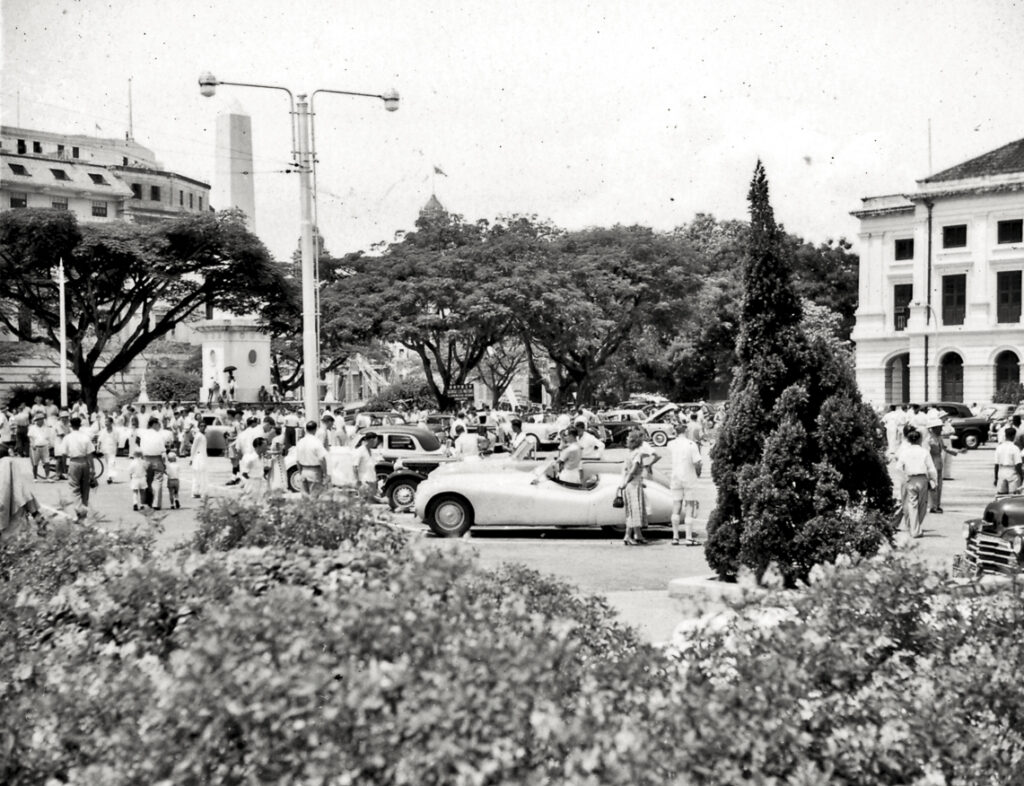
One of the first events organised by the Automobile Association of Singapore was a Concours d’Elegance at Empress Place on 26 August 1951.
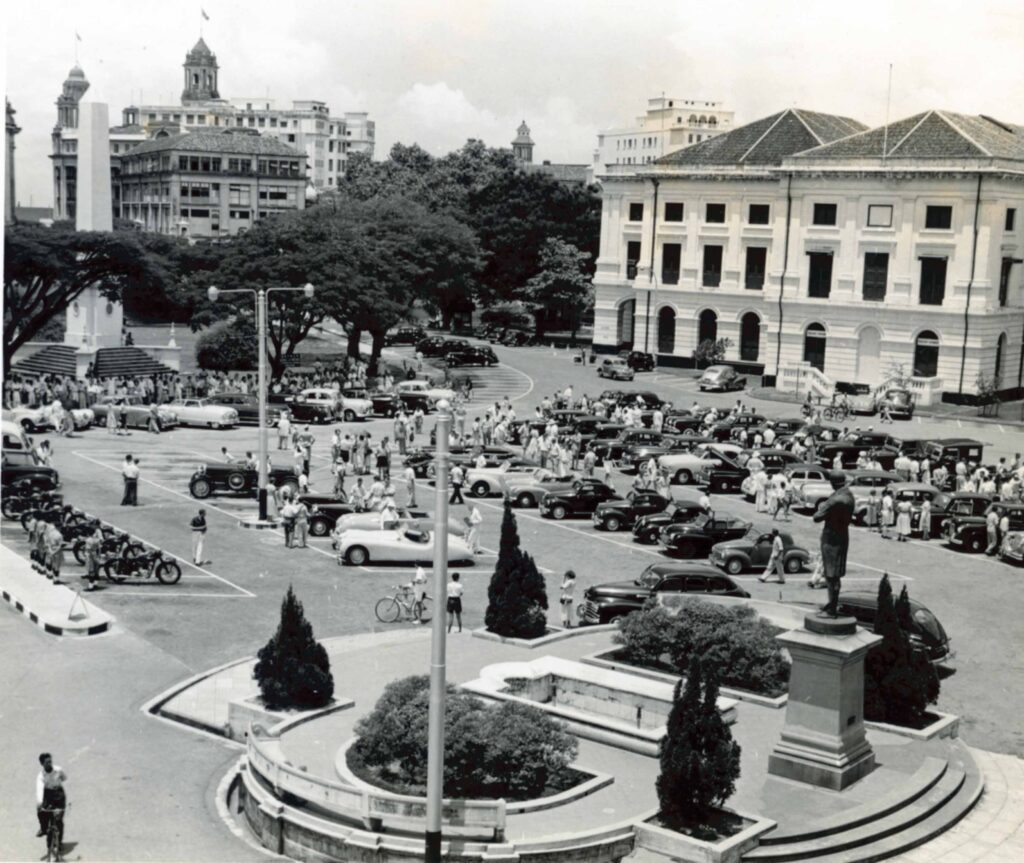
The caption read: “Raffles looks down on it all.” Paul Gibbs-Pancheri also recorded that his Bentley (pictured) was “The only real car stands between him [Raffles] and the Dalhousie Obelisk.” See: THE ONLY REAL CAR BETWEEN RAFFLES AND THE OBELISK
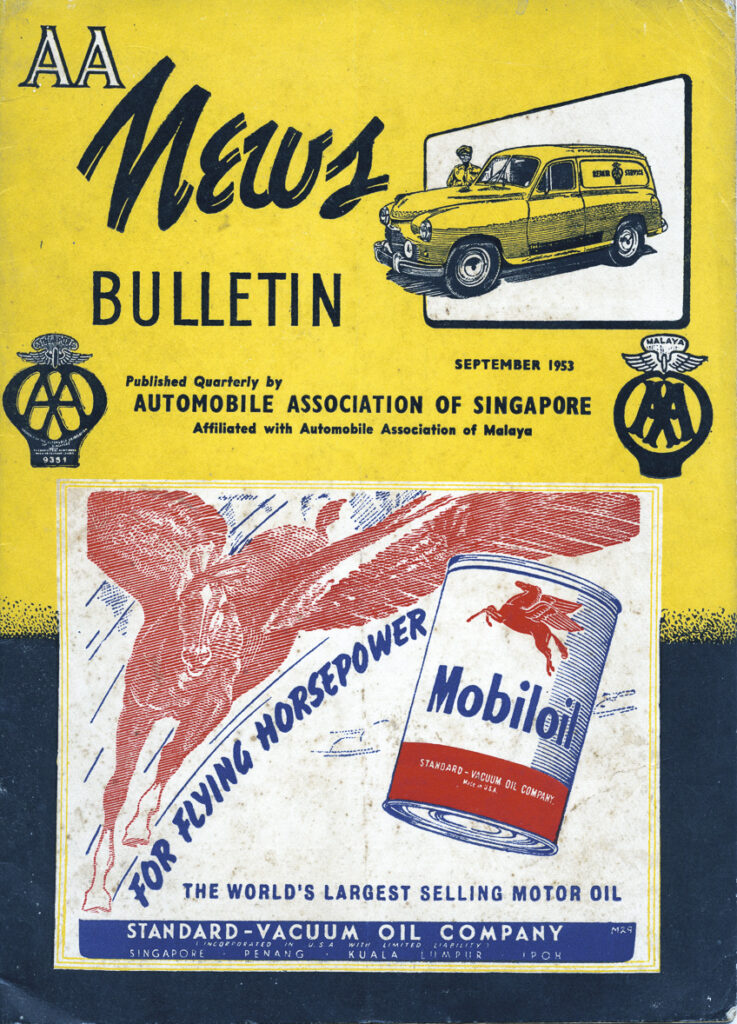
Precursor to the AAS The Highway Magazine was this quarterly News Bulletin. The first post-war issue of the Association’s printed AAM Bulletin appeared in November 1949.
A quarterly bulletin called The Highway commenced publication in 1954 to cater to the growing members’ interest in motoring matters on the island. By 1956, Singapore’s population had exceeded 1 million and the AAS had a membership of over 7,400.
After many years at 11 Battery Road, the Association moved to a new, modern office at Manasseh Building on 90 Orchard Road, next to Lyons Motors, in October 1958. By 1966, membership had topped 12,000. The AAS moved to a two-storey bungalow at River Valley Road for its headquarters. Membership would treble over the next decade.
In December 1970, the Automobile Association of Singapore assumed the responsibilities as the sole non-government representative for all motoring matters in Singapore, including the promotion of motor sport on the island, following its appointment as affiliate to the Federation International de l’Automobile (FIA). The AAS’ membership in 1969 stood at over 16,000 with its The Highway magazine having a circulation of 17,500, significantly larger in every respect to the amalgamated SMC-FDC.
The official history of the AAS is well documented in this book: https://www.aas.com.sg/publications/182-the-motoring-50.html
GROWTH OF THE CLUBS
Once the role of the Automobile Association of Malaya had been formulated, the responsibility of organising and funding motor sports activities quickly devolved upon the clubs that had sprung up to cater for the increasing demand for various sporting pursuits. These clubs were usually affiliated with the AAM and Britain’s RAC. The largest of these clubs between the late 1940s and 1960s was the Singapore Motor Club.
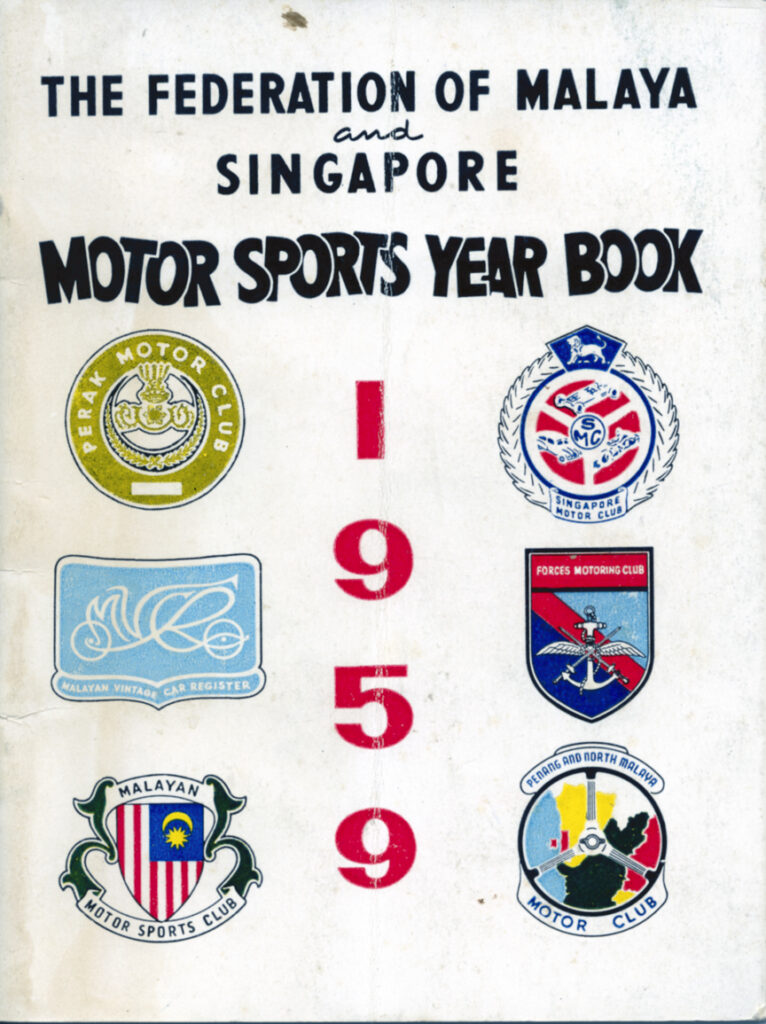
Singapore Motor Club – 1948-1969
Formed on 25th February 1948 at a meeting at the Adelphi Hotel in Singapore, the Singapore Motor Club (SMC) was the first motor sports club independent of the Automobile Association of Malaya to be formed. Its first committee consisted of active names in motor sports throughout Malaysia and Singapore. Charles (or was it Claude?) Frederick ‘Freddie’ Pope was the Club’s first President but relinquished his position soon after, following the debacle of the Pender Road Hill Climb. He had just set up his motor retail and repair business as well, following a stint with local car distributor Cycle & Carriage.
Initial membership of the SMC consisted of 10 very enthusiastic individuals but the idea of such a club dates back to 1947 when enthusiasts such as Lim Peng Han scoured the region to seek out his racing friends and see they would be keen to participate in this new and very exciting project.
Lim reached out to Paul Gibbs Pancheri, whom he knew well from before the war. Pancheri was back in Malaya with Harper Gilfillan and now working out of Bangsa (or as it was then known, Bungsar) on the outskirts of Kuala Lumpur. Pancheri was transferred to Singapore in early 1948 with his family (his son Michael was born in Kuala Lumpur in June 1947), so the timing was more than ideal.
It seems that there had been a parallel attempt to set up a motor club in 1947 but nothing came of it. The Freddie Pope-led initiative held a meeting at the offices of Cycle & Carriage Co., (1926) Ltd. at 43 Orchard Road in late 1947, Pope being on the C&C payroll as their Workshop Manager at the time. The company had yet to bag the Jaguar and Mercedes-Benz agencies [see FROM A FEDERAL STORE – the story of Cycle & Carriage] but Pope was on a different course and would soon have his own workshop operating on Anson Road.
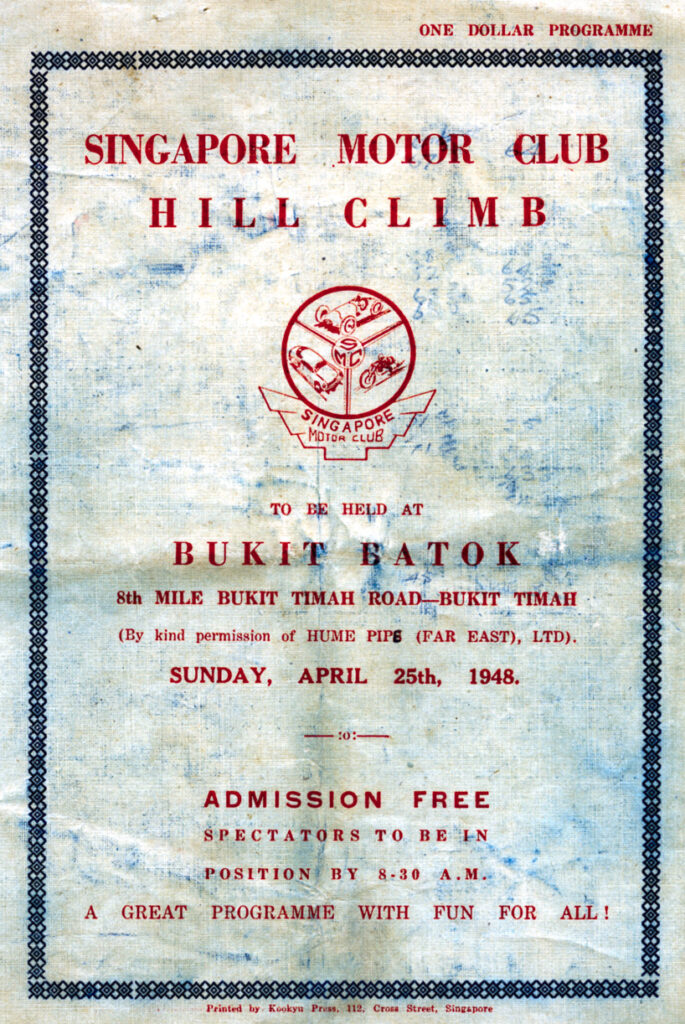
The inaugural Bukit Batok Hill Climb, recognised by this writer as the first sporting event held by the newly-formed Singapore Motor Club.
Pancheri’s memoirs are an integral part of local motoring history. He recalled that “We were all very much ‘feeling our way’ with the organisation, some of us had never witnessed a motor competition, still less, either competed or marshaled at one. Those who had some slight experience were too busy getting their mounts and themselves ready to be able to give either time or advice. So it was pretty amateurish, but despite this – and the inevitable extra burden lack of knowledge put upon us – the meeting went off quite well, though crown control, which fell to my lot on this occasion, involved the use of tremendous activity and boundless tack as well as my best Malay…And we got by without any untoward incident.” Pancheri was probably referring to the Singapore Motor Club’s first sporting event, a hill climb held at Bukit Batok on 25 April 1948, exactly two months following the formation of the SMC.
The objective of the Club was “for sponsoring events to interest owners of all types of motor vehicles.” SMC was affiliated with the Automobile Association of Malaya (Singapore Branch) which operated under the rules and regulations of Britain’s RAC. The Club’s first event, a ‘touring rally’, was held on 21st March 1948.
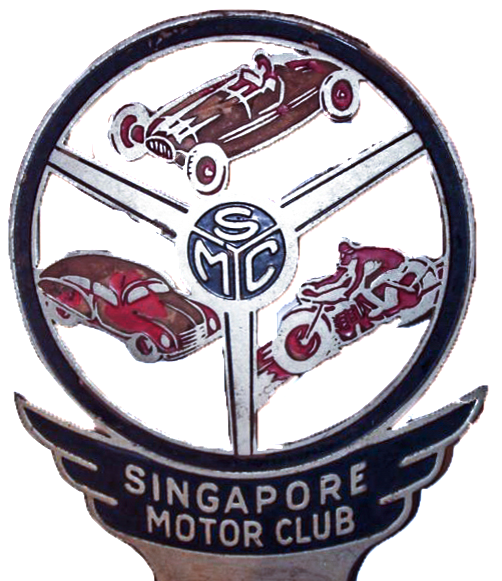
The original Joy Moncrieff-designed badge of the Singapore Motor Club in February 1948. See JOY BY DESIGN
A club badge was needed and in stepped Joy Moncrieff, wife of motor racing enthusiast and aircraft instrument engineer Neil Moncrieff. Having studied at the South Australian School of Arts and Crafts (simply called the Adelaide Art School), Joy came up with a very smart design for the club. That story is featured in JOY BY DESIGN.
The ebullient Freddie Pope, an engineer by training, had remained in Singapore after the Japanese surrender. His strong personality and passion for all things motoring was the driving force behind the Club and the success it achieved throughout the 1950s and early 1960s.
He was also a regular competitor at these events and his very well known ‘Flying Taxicab’ Special and Jaguar XKs were a common sight up and down the peninsula. His short tenure as founding President had little impact on the newly formed Club as he was still very much the strongman behind the scenes in motor sports in Singapore. Pope returned to lead the club through its most active period and was president between 1959 and 1961, when the inaugural Singapore Grand Prix was held [see SIXTY YEARS AGO – THE ORIENT YEAR GRAND PRIX].
His successor during the turbulent year of its formation was Senior Police Officer Patrick J. ‘Paddy’ Darnell65.
Darnell came with considerable motor sport experience having competed in the Rob Roy Hill Climb and Cowes Island Races in Australia as well as races on Pendine Sands in England and at Phoenix Park in Dublin. Darnell was President of the SMC in 1949 and 1950.
In April 1951, he was elected Chairman of the AAM and in November 1951, he became the first Chairman of the Automobile Association of Singapore, an office he held until March 1954 when he retired and returned to the UK. Paul Gibbs Pancheri took over as President of the SMC in 1951 and held the post for two years before he was posted to Selangor by his employers.
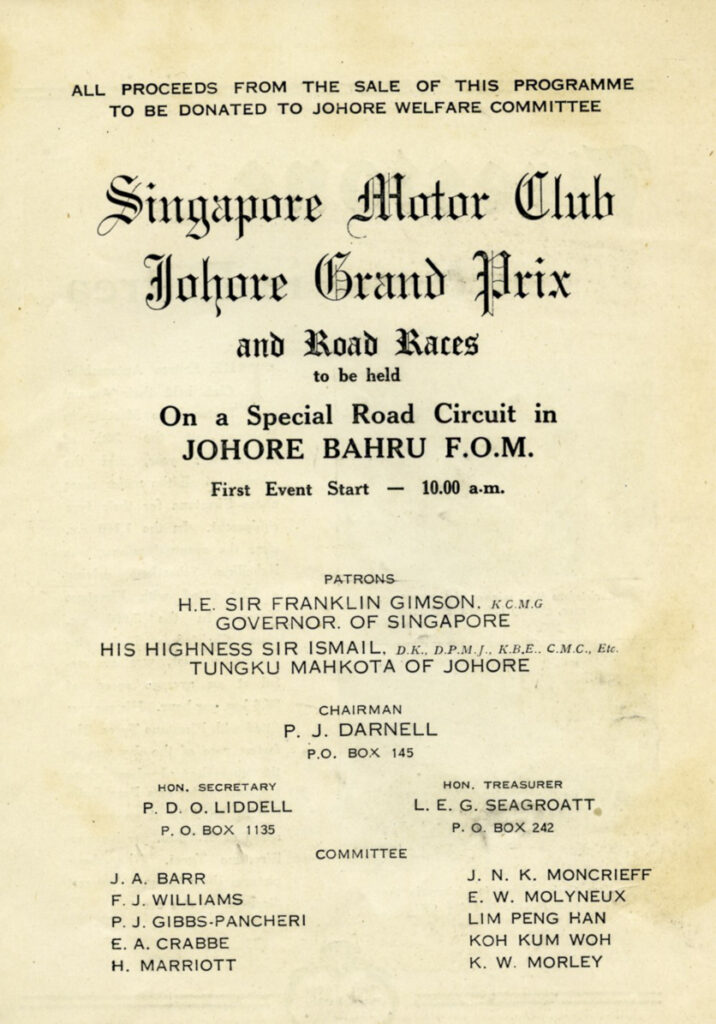
A leaf from the 1949 Johore Grand Prix, an event organised by the Singapore Motor Club.
Those formative years were exciting. There was a war (they called it an “Emergency” for insurance purposes) on communist insurgents but these were brave people who had endured years of internment and hardship during the Japanese Occupation of Malaya. In 1949, the club organised the first post-war Johore Grand Prix. This was followed up by Grand Prix and Road Races in 1950, 1951, 1952 and 1953! [see the latest feature on the Johore Grand Prix – Part 1: 1949-1953]
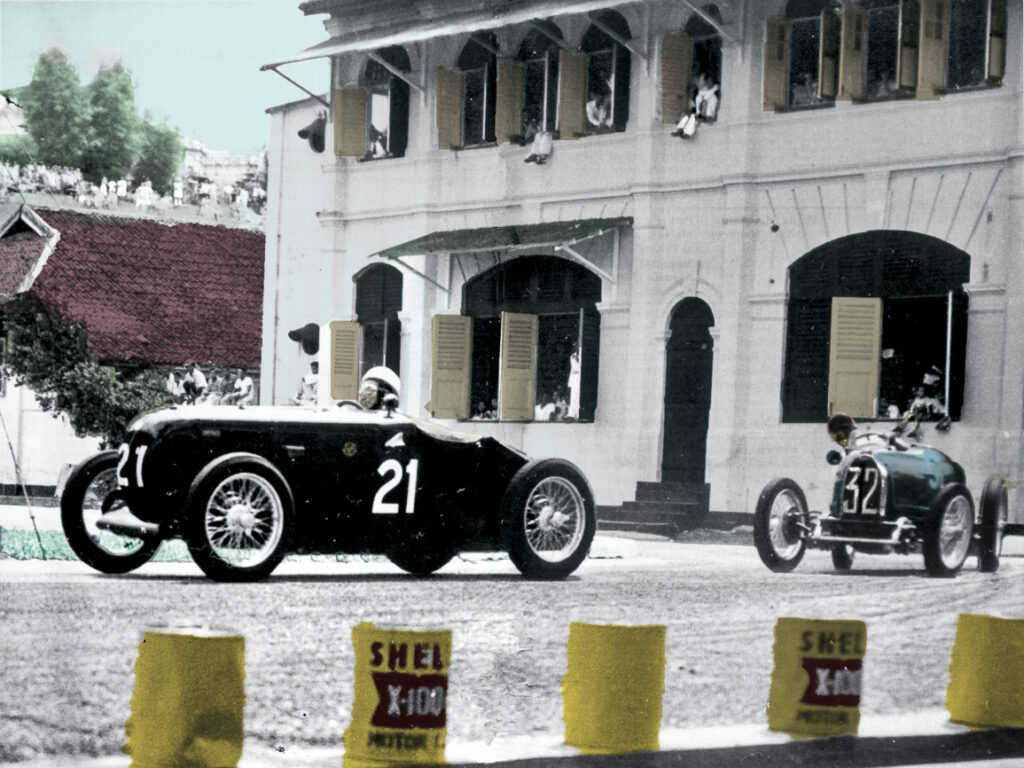
MGs to the fore – Mick Jennings and his Mk1 Black Draught TC leads Lim Peng Han and his Bugatti-MG (or MG-Bugatti) in Johore. The story of the MG-Bugatti can be found here: Automotive Archaeology & the Bugatti-MG Special
By 1956, the SMC had a membership of 396. It was also the first year the club chose to elect a Club Captain. The role was fulfilled by the very capable Shell man and keen vintagent P.R.W. ‘Bill’ Jupe66.
The Club had a very active calendar of sprints and hill climbs throughout the 1950s and a core team from within had been on the lookout for a proper race circuit on the island. The Club’s officials had sufficient experience to undertake major events such as the Changi Circuit Race [see LANDING AT CHANGI].
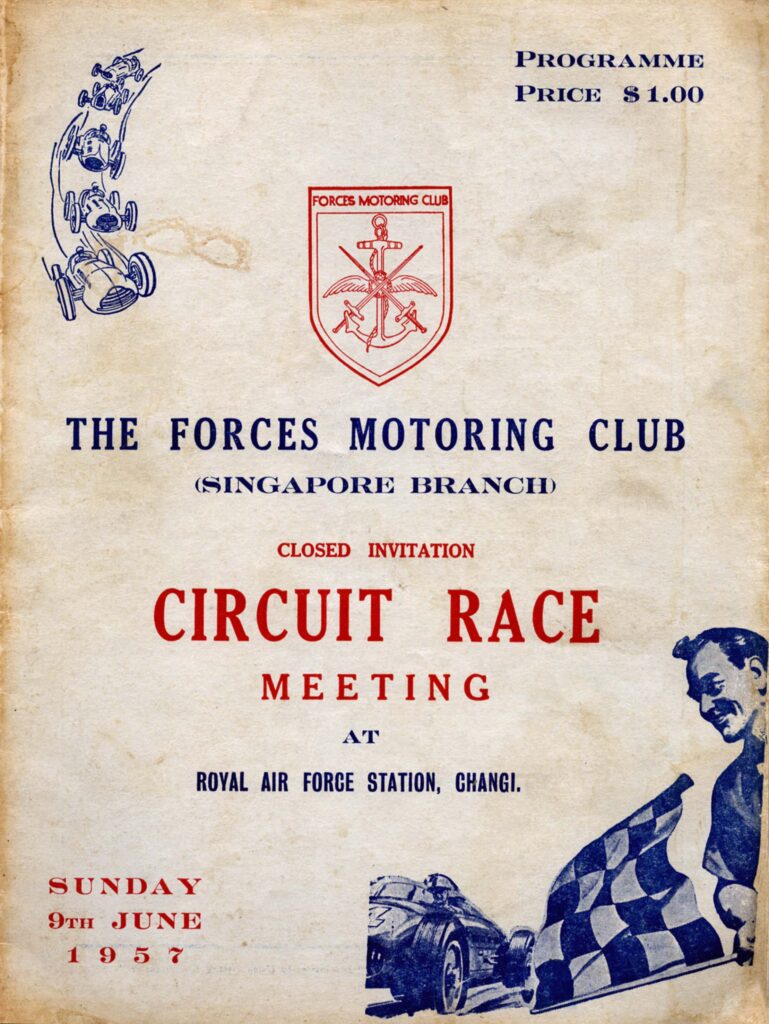
The Forces Motoring Club was assisted by the Singapore Motor Club for this monumental undertaking at RAF Changi in June 1957. See LANDING AT CHANGI IN 1957.
Between 1957 and 1959, Danny Needham67 was the SMC Club Captain. Bill Wyllie was elected Club Captain in 1960. Once Singapore began to host an annual Grand Prix, it became necessary to have a Club Captain for the club.
Major Mike Tice, who was stationed in Singapore when the Changi Circuit Race was held recalled: “The Singapore Motor Club as I saw them were a funny bunch. Individually they were most pleasant and terribly hospitable to a new boy, but collectively they seemed to be divided into clans and cliques, one always at loggerheads with another. I think that the weather had much to do with this as the incessant humidity of around 90 percent tended to make one very short tempered.”68
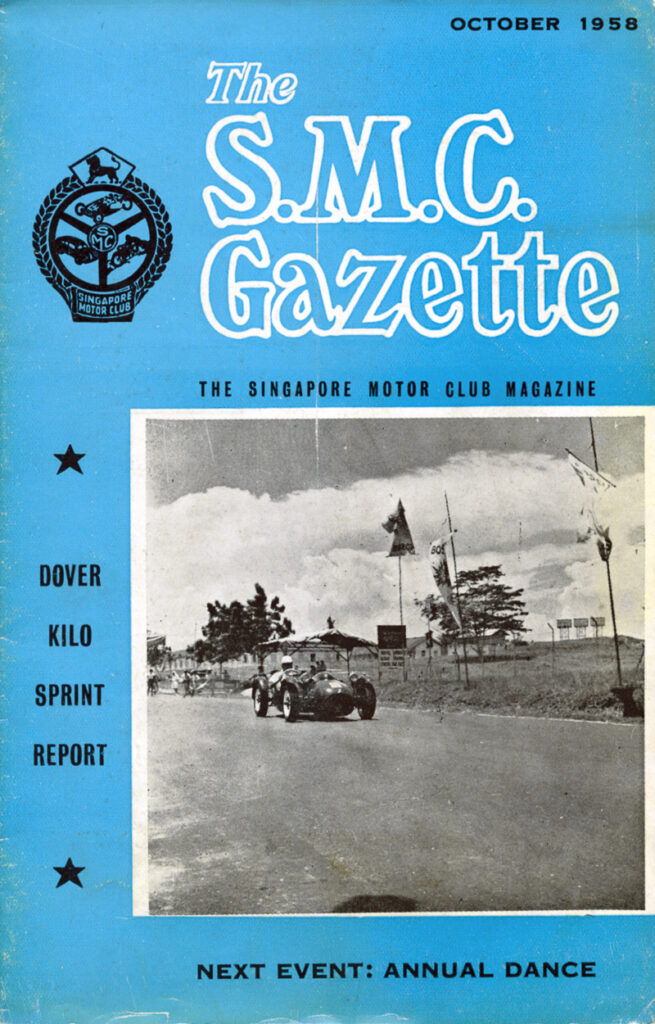
The first edition of the Singapore Motor Club’s Gazette (Vol.1, No.1) was issued in October 1958. Editor was school teacher Loris Goring. The Club’s President was Alan Gilbert69.
In October 1958 the SMC issued its first edition of the SMC Gazette, Vol.1 No.1. The magazine continued until 1961 before a lapse of four years without a regular publication. The Gazette resumed with issue No.1 in 1964, possibly during the month of August and covered the Third Tunku Abdul Rahman Circuit Races held in July. That issue also announced the cancellation of the much expected Johore Grand Prix for 1964.
The Singapore Motor Club’s greatest local achievement came in 1961 after years of lobbying by Freddie Pope and his committee of enthusiasts. The inaugural Singapore Grand Prix was a smashing success and the first of 13 annual races held until 1973.
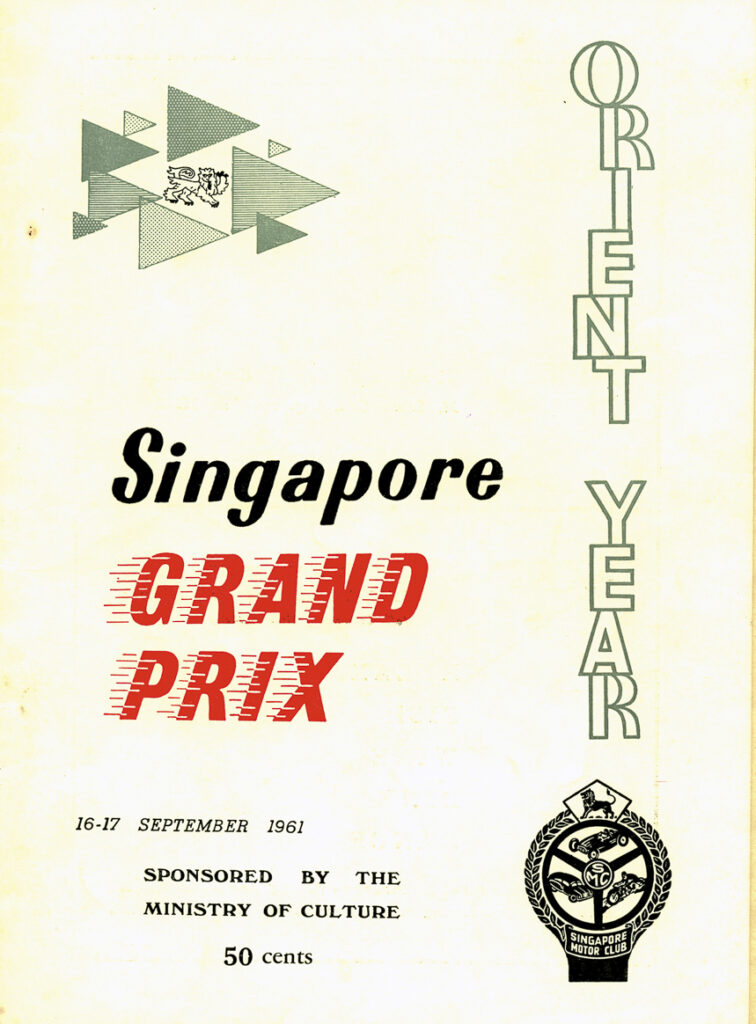
Program cover of the inaugural Singapore Grand Prix – 1961.. Story of the first Grand Prix can be found here: 60 YEARS AGO: THE ORIENT YEAR GRAND PRIX
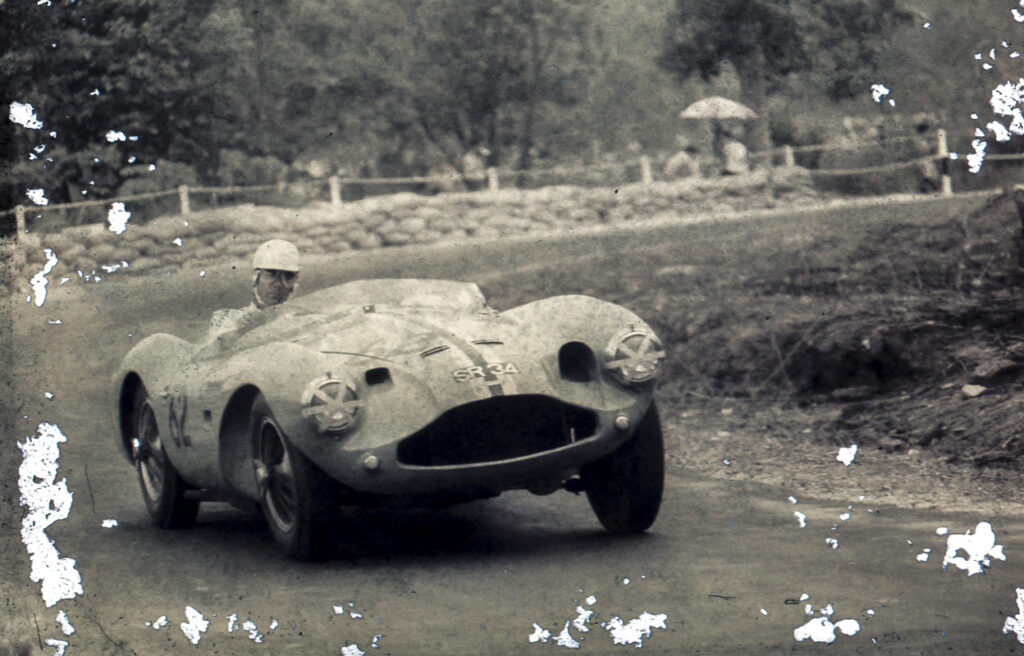
The inaugural Singapore Grand Prix was sponsored by Singapore’s Ministry of Culture but organised by the Singapore Motor Club under the leadership of its President Freddie Pope. The Grand Prix for cars was won by Ian M. Barnwell in his Aston Martin DB3S [see FOR THE PRICE OF A HOUSE].
Singapore Motor Sports Club – 1969-1994
The Singapore Motor Club eventually merged with the Forces Driving Club (FDC) in July 196970, creating the Singapore Motor Sports Club (SMSC). While the SMC was better known for organising the larger events such as the Singapore Grand Prix (1961-1973), the Gap Hill Climb (1927-1973), the Old Upper Thomson Road Sprint (1960-1973) and various other sprints on the island, the FDC had a different mandate and organised grassroots events for its members who were more likely to use their everyday cars to compete.
The merger between the SMC and FDC resulted in a stronger and more balanced club with a wider mix of enthusiasts. It was in the interests of both clubs especially when the numbers in the Commonwealth Forces in Singapore had diminished considerably.
The British military pull out in the early 1970s removed one of the pillars of the local motor sports clubs.
Eventually, the role of SMSC diminished too when motor sports activity in Singapore was severely curtailed (to put it mildly) by an undeclared ban on the sport after the Gap Hill Climb in September 1973. Its official history has already been well documented by Singaporean experts but it is perhaps worthwhile to note that the SMSC was just a small club and that the Singapore Government really called the shots on use of land on the island for any sort of motoring events.
Forces Motoring Club/Forces Driving Club (Singapore Branch) – 1956-1969
With over 4,500 members from the various branches of the British Forces around the world, the Forces Motoring Club (FMC) of UK played a pivotal role in establishing a proper motor sports framework for volunteers and officials in its colonies, including Singapore and Malaysia.
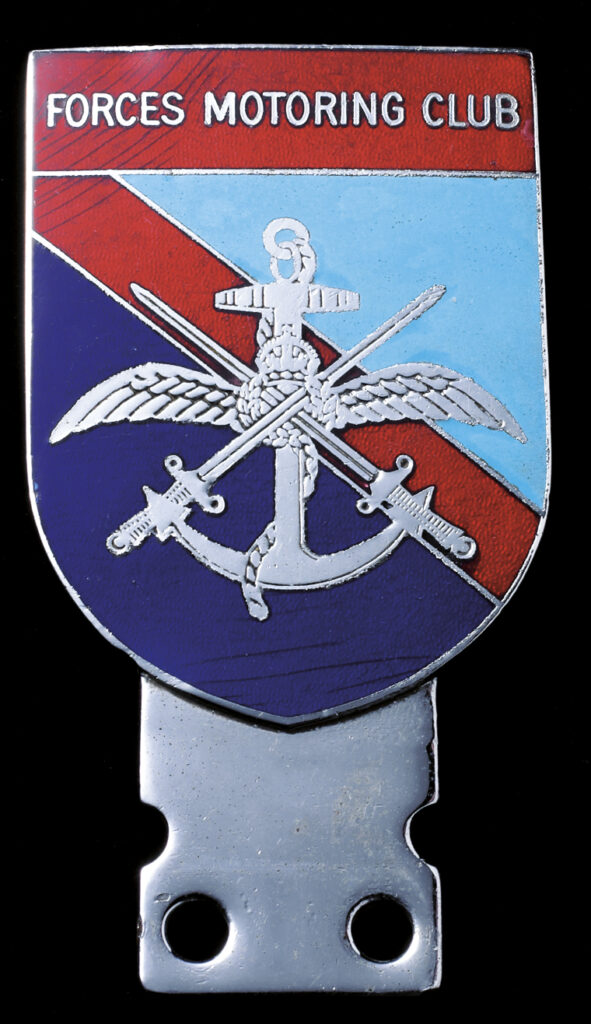
The Forces Motoring Club grille badge.
The Singapore branch was formed on 23 August 1956, and within three years, had 108 members. The inaugural meeting took place at the Raffles Hotel with Air Officer Commanding, Air Commodore Caril-Worsley appointed as branch President; pre-war Le Mans participant, multi-time Monte Carlo Rally entrant, 50-year-old Colonel Lord de Clifford71 as Vice-President. The committee consisted of R.A.F. Wing Commander Robert John Sage, Major Coote, Major Corley and Freddie Pope, with Major Mike A. Tice, who was a close friend of Pope and his wife Joan, its competition secretary.
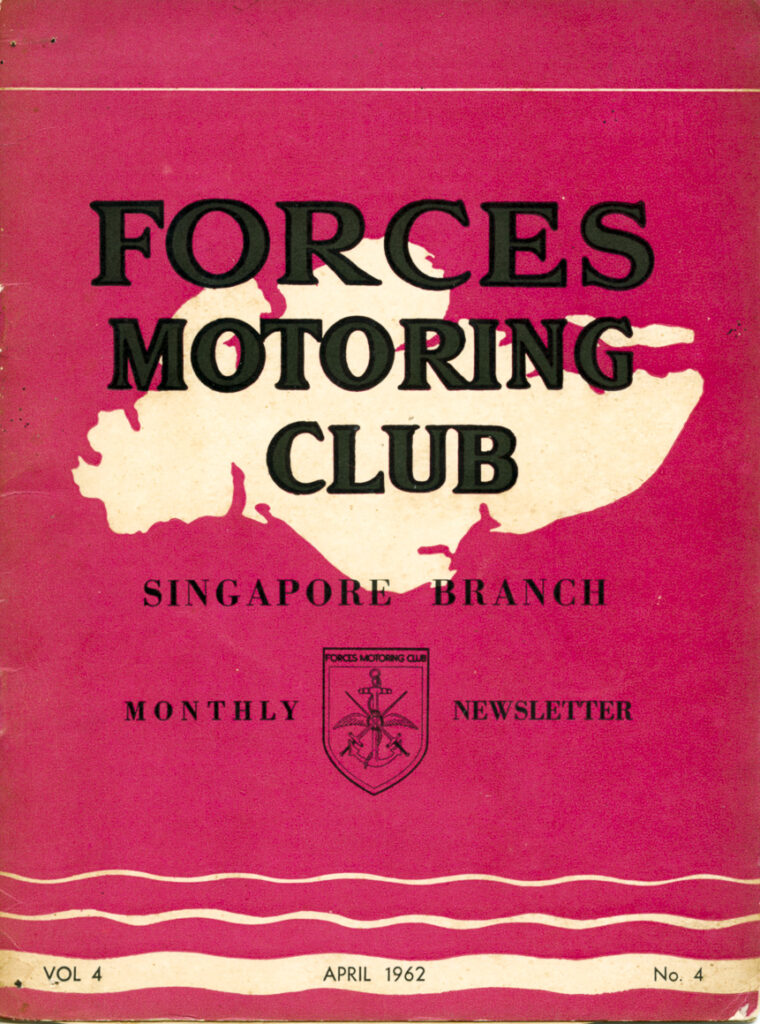
Forces Motoring Club (Singapore Branch) newsletter from April 1962.
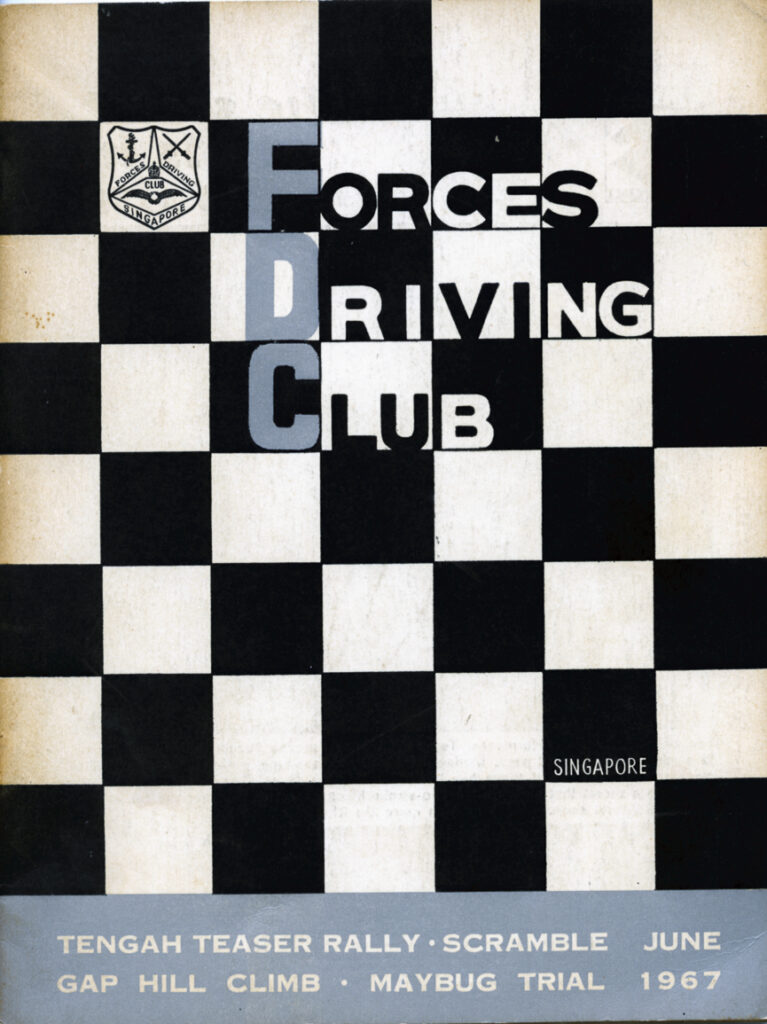
Forces Driving Club (Singapore) magazine from June 1967
Tice’s autobiography reveals that it was he who “decided to form a Singapore branch,” and that the first even he organised was a hill climb off Bukit Timah Road (at Bukit Batok). Following the success of that hill climb, Tice found that the REME depot nearby Nepal Park (off North Bouna Vista Road in Singapore) was suitable for a driving test.
In the first year of its formation, the Club held a circuit race on the RAF airfield at Changi with the cooperation of the Singapore Motor Club (see LANDING AT CHANGI). This collaboration continued with various other events, held on military bases, such as the short-lived Dover Road Kilo Sprint, the Sembawang RASC Nursery Circuit races, the Seletar Quarter Mile Sprint (organised with the cooperation of the RAF Seletar Motor Club and the Civil Service Motoring Association) and the one-off Tengah Sprint (with the assistance of the RAF Seletar Motor Club)72.
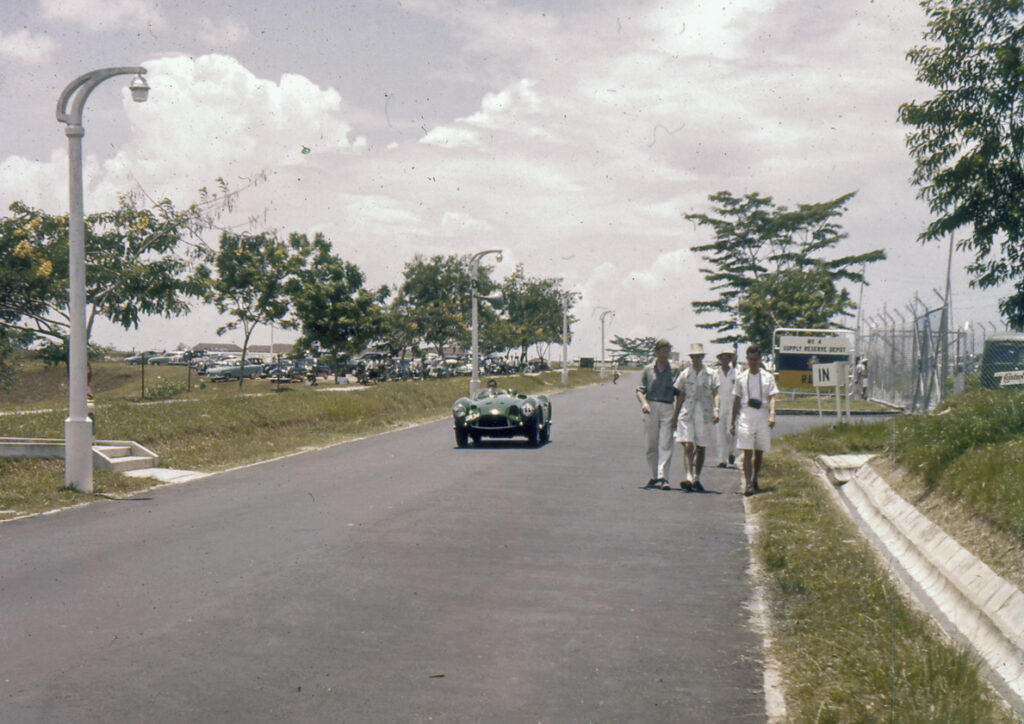
Number 4 Supply Depot was based at Dover Road, the site of the Dover Road Kilo Sprint in the late 1950s. The event was organised by the Forces Motoring Club, Singapore Branch.
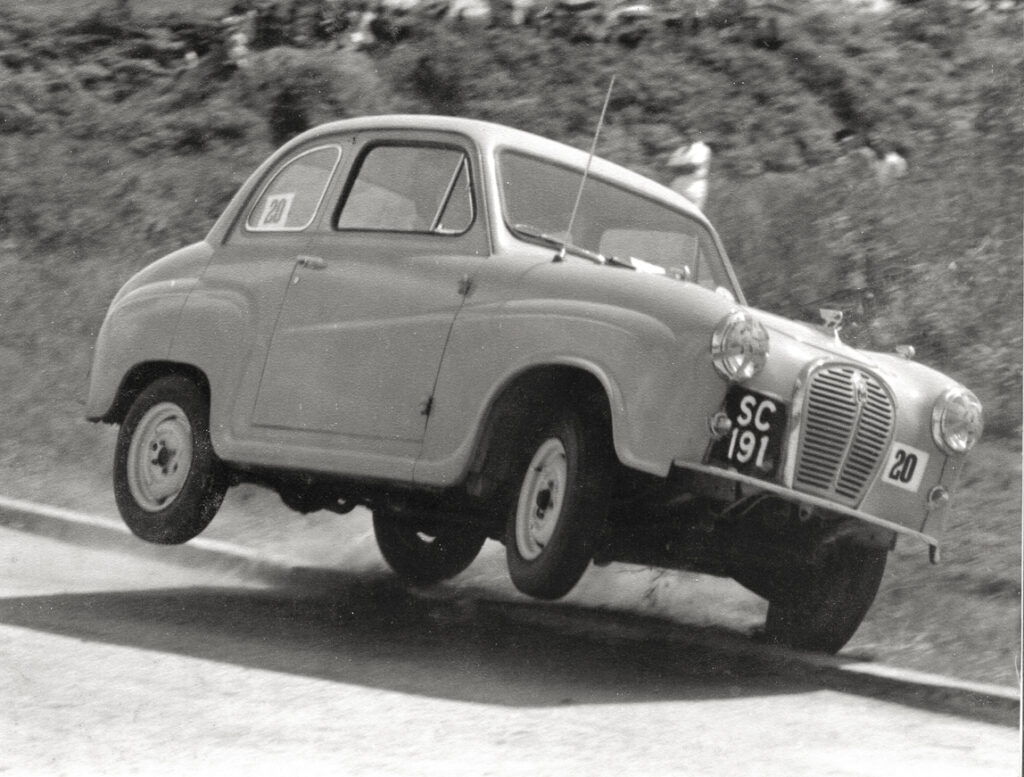
Racing on the treacherous Sembawang RASC Nursery Circuit.
Membership was intended for those who had served in the Armed Forces of the British Commonwealth but there was provision for the Club to extend membership to those outside as well. In the early 1960s, the Club held fortnightly social evenings at the Welfare Centre at Fort Canning.
Things came to a head at 8pm on Tuesday 6 August 1963 when an EGM to discuss future of the Singapore Branch of the Forces Motoring Club took place. There were just 25 attendees and 23 voted to “cut the long lines of communication between here and London.”
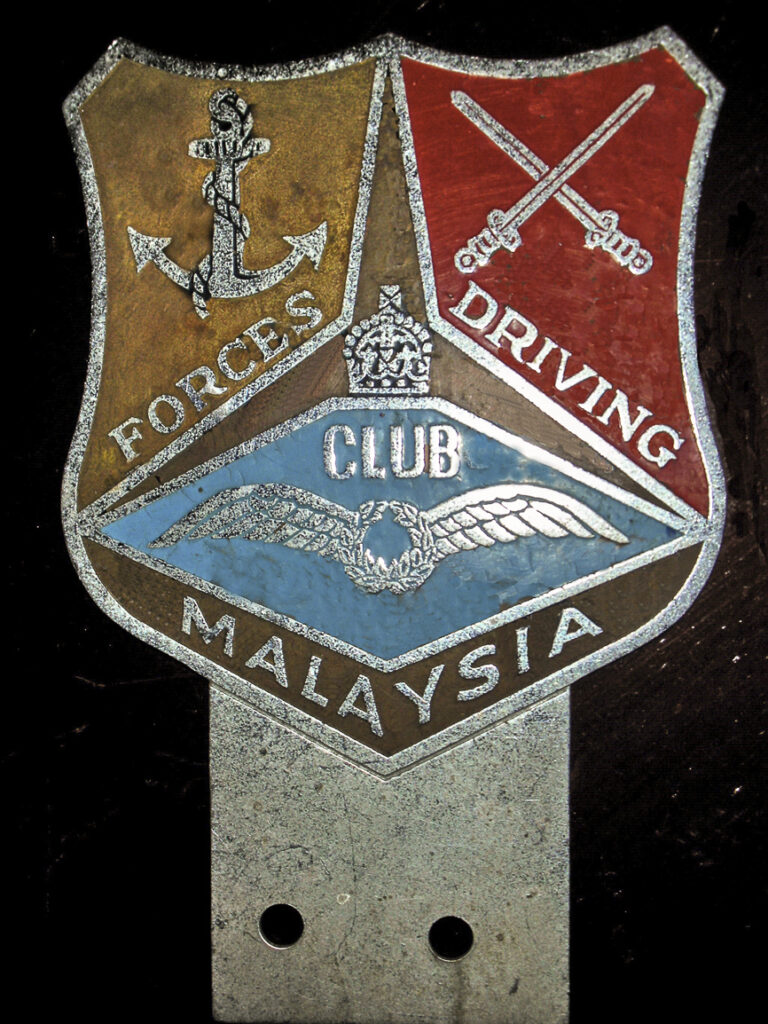
In May 1964, the Singapore and Malaysian branches were revamped as a result of the dissolution of the FMC in the UK73 and the Forces Driving Club was established to resume the activities of members of the forces.
The Malaysian Branch of the Forces Driving Club (it seems the Singapore branch was amalgamated into this new entity) was registered as a society in early May 1964 and appears to have taken over as the representative body for the Commonwealth Forces in Singapore and Malaysia. The Forces Motoring Club’s dissolution meant that the FDC now assumed the activities of members of the forces in the region. The FDC’s then President (and founder member) was Lt.-Colonel Herbert Rheims Aisne ‘Mike’ Hunt of the Royal Artillery in Singapore.
When the proposed merger of the Singapore Motor Club and Forces Driving Club (Singapore) was announced in January 1969, membership of the FDC stood at just 267. But as of July 1969, there were just 116 left – with 94 full members, two honorary members, 10 family members and 10 associate members. It appears that the last issue of the monthly Forces Driving Club magazine was the July 1969 edition (featuring the Dunlop Gap Hill Climb).
The last edition of the Forces Driving Club’s monthly magazine before the newly formed Singapore Motor Sports Club took over the publication with the September 1969 issue (Vol 1, No.1). At the time of the merger the FDC’s committee consisted of Rae Littlejohn (President), M.C. Dolittle (Vice President), D.M. Farmer (Hon. Secretary), Alan J. Davis (Treasurer), Jock Minto (Club Captain), Chan Chee Wai (P.R.O.), F.M.R. ‘Mike’ Davis (Editor), Liz Bunting (Social Secretary), J.J.N.A. ‘Rusty’ Ironside (Competition Secretary Cars) – Peter Tett has stepped down, and Charles Cooper (Competition Secretary Motorcycles).
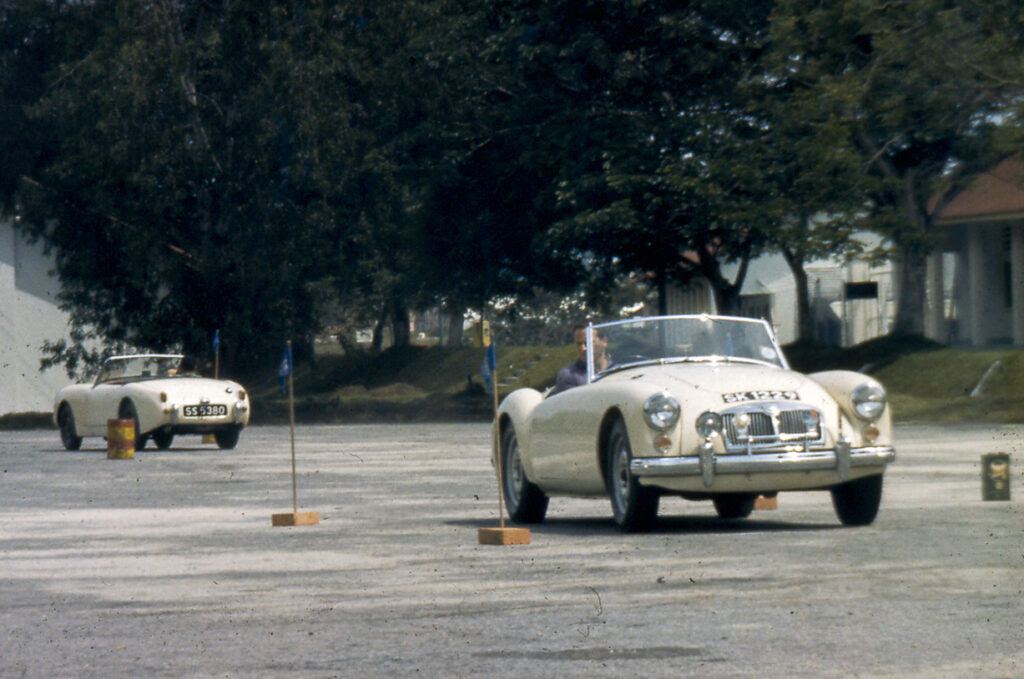
A typical Forces Driving Club event at one of the many military camps on the island in the 1960s.
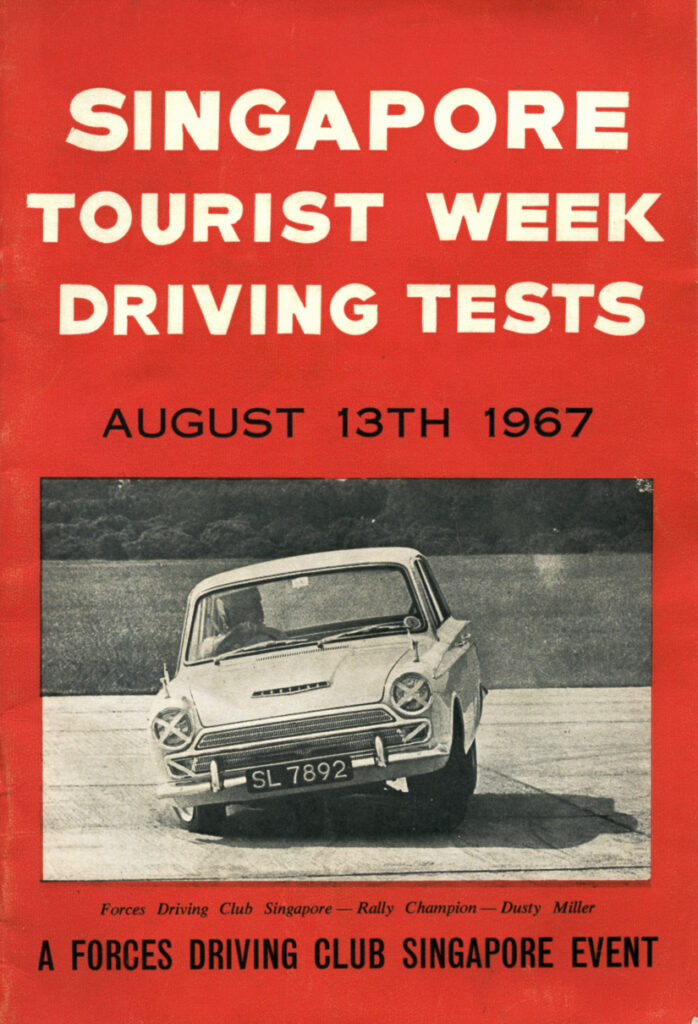
Another typical Forces Driving Club event – driving test at Empress Place in Singapore.
Selangor Motor Sports Club – 1950-1953
Jennings had been an active member of the motor racing community before the Japanese invasion of Malaya having participated in the 1940 War Effort Grand Prix held around the streets of Johor Bahru in his very famous MG K3 Magnette [see THE REAL CAPTAIN MG as well as GENESIS & THE WINDS OF WAR].
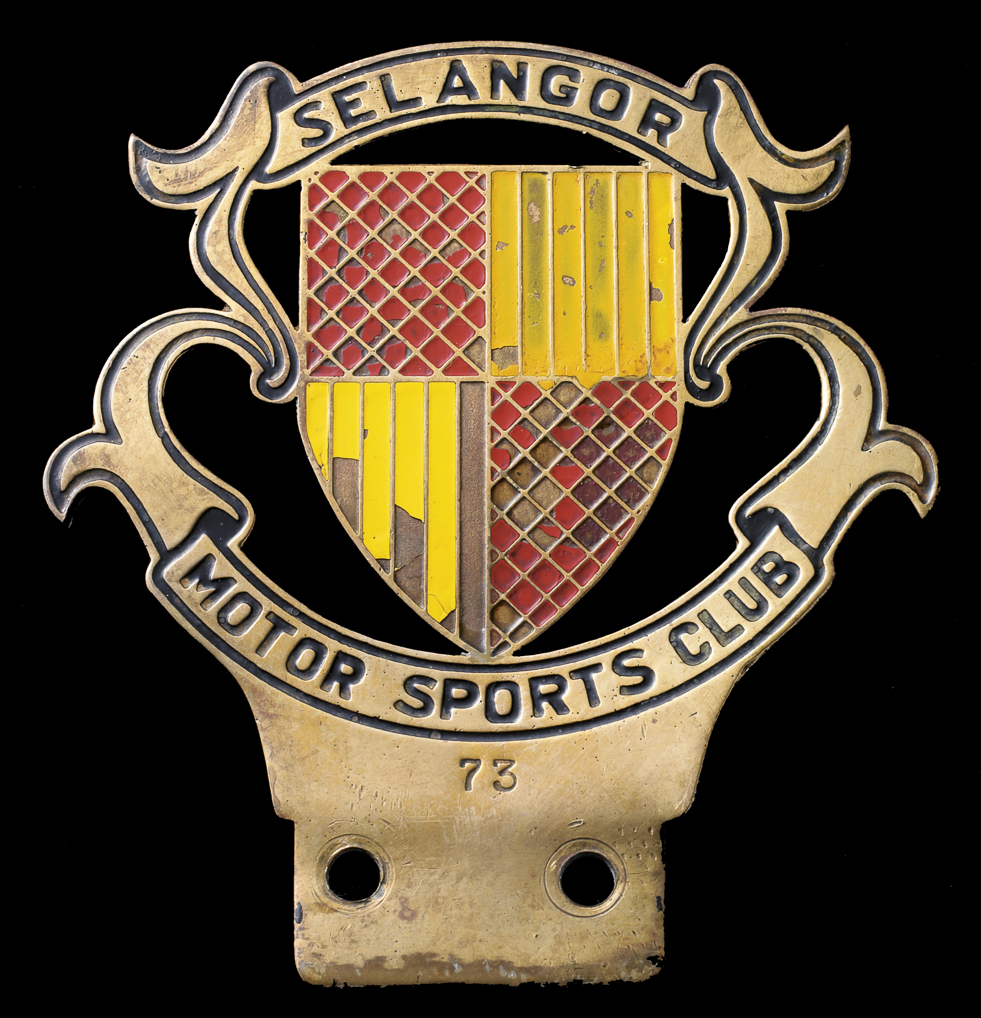
The Selangor Motor Sports Club badge was designed by C.O. ‘Mick’ Jennings in early 1950. The club remained in existence between March 1950 and March 1953.
Finally, around 11 March 1950, Mick Jennings’ brainchild came to fruition and the Selangor Motor Sports Club was born. Capt. Cyril Oswald ‘Mick’ Jennings of the Kuala Lumpur Municipal Office (he was Municipal Architect) officiated as the Club’s first President. He also designed the club’s badge [see MICKEY BOY’S BADGE].
His committee consisted of Mr. A. de Silva as Hon. Secretary, Mr. S. Mitchell as Treasurer with Kyle-Palmer’s James L. Ross, Kinta Electrical Distribution’s Peter Carey-Rees, A. Nixon, E.C. Asplen, H. Woods and H. Woodhouse making up the initial committee. J. Lavers was elected publicity secretary74
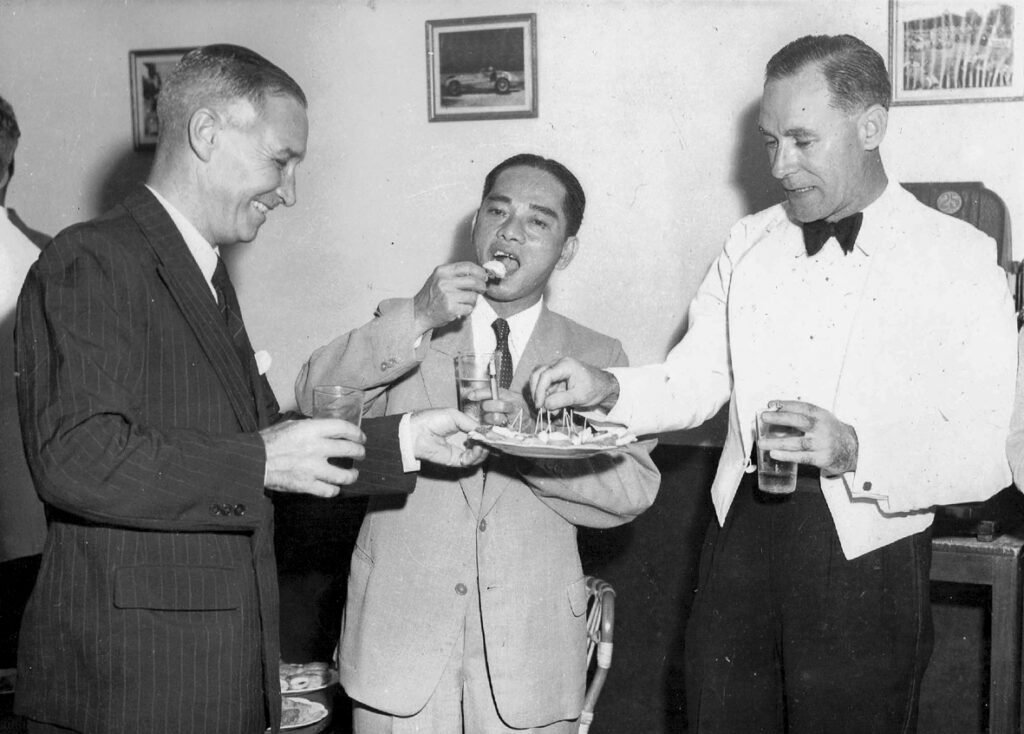
Launch of the little-known Gear Box Club in Kuala Lumpur in 1953. Mick Jennings (left) was behind the formation of the club.
He was also instrumental in the formation of the little-known Gear Box Club in Kuala Lumpur in 1953 and was keen to introduce a Gold Star competition, based on a points system similar to the British Gold Star award. The idea behind following the British had actually been mooted (and indeed simulated) before the war in Singapore by AAM committee member and avid racer, Lieut. Peter K. Braid.
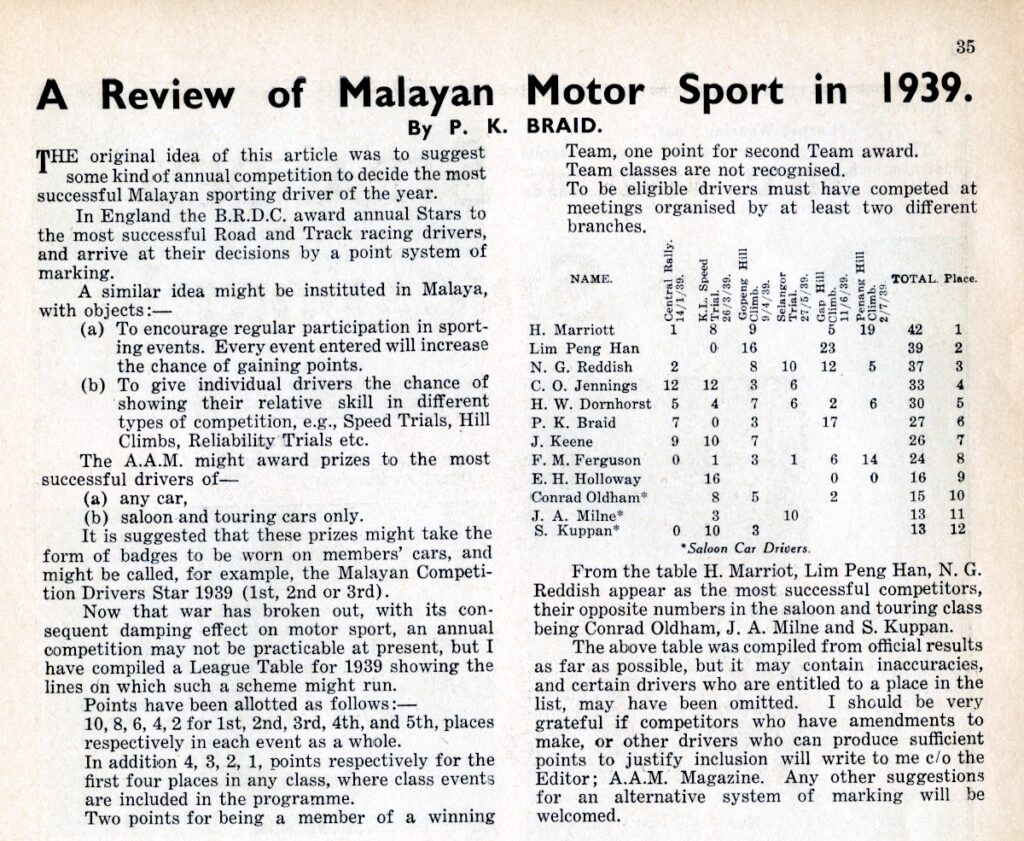
Lt. Peter Braid R.A. proposed a Drivers Star award for AAM events in Malaya and Singapore in 1939. Nothing came of it.
The Selangor Motor Sport Club’s first event was a Motor Gymkhana and Concours d’Elegance in 1950, although there seems to be no indication that this took place that year.
The first motor sport event in Selangor after the Japanese withdrawal in 1946 was the Lornie Mile held in Kuala Lumpur on 3rd July 1949. This was a Selangor and Pahang Branch of the AAM event and was graced by an overhead pass by Wing Commander Roderick ‘Babe’ Learoyd in a de Havilland DH.80 Puss Moth high-wing monoplane. There were an astonishing 125 entries!
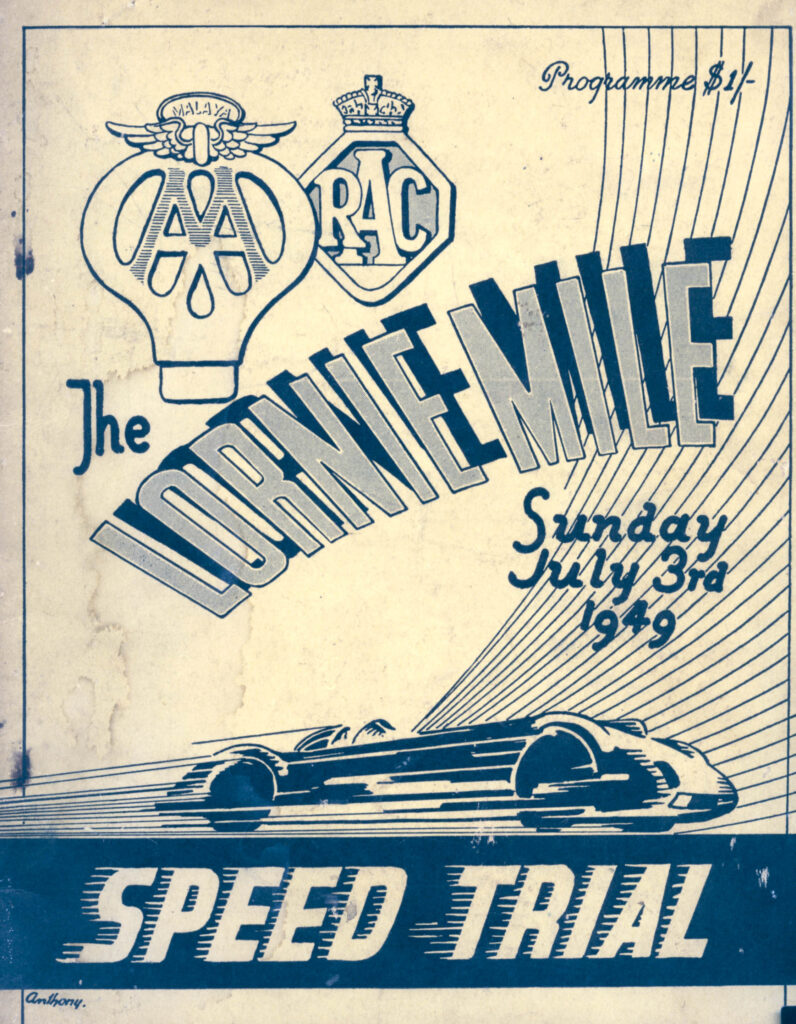
The first motor sport event in Selangor after the Japanese withdrawal in 1946 was the Lornie Mile held in Kuala Lumpur on 3rd July 1949.
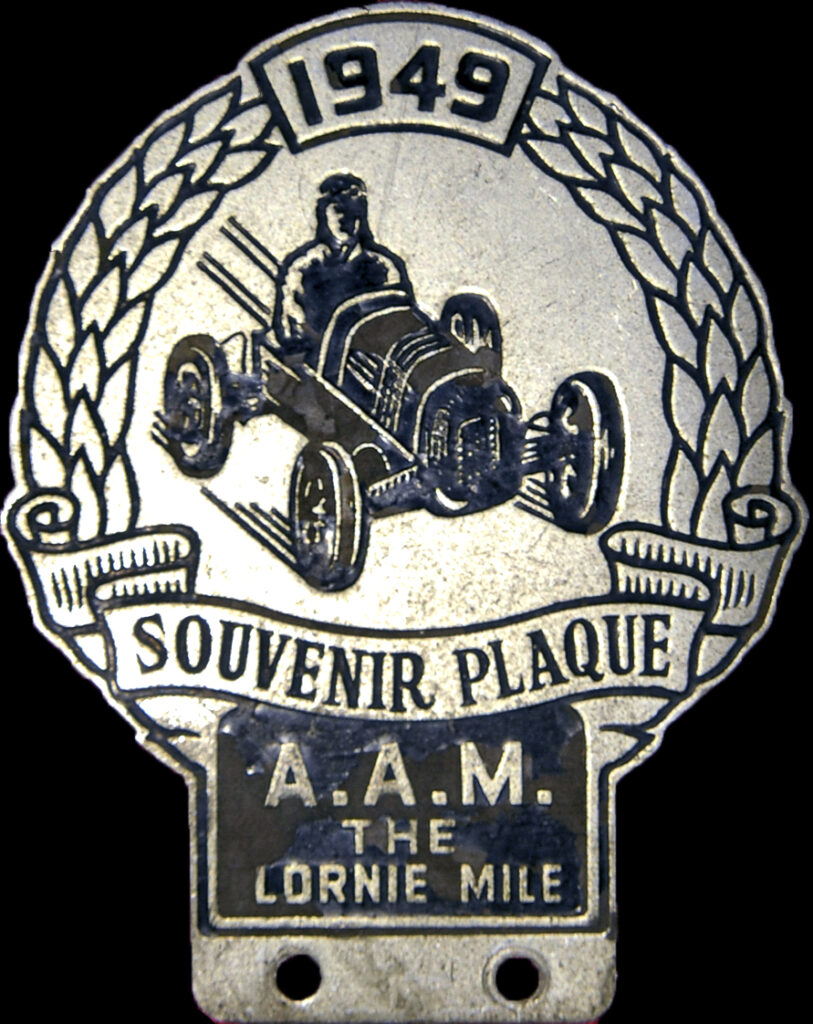
The Lornie Mile grille badge issued to competitor Saw Kim Thiat for the July 1949 sprint.
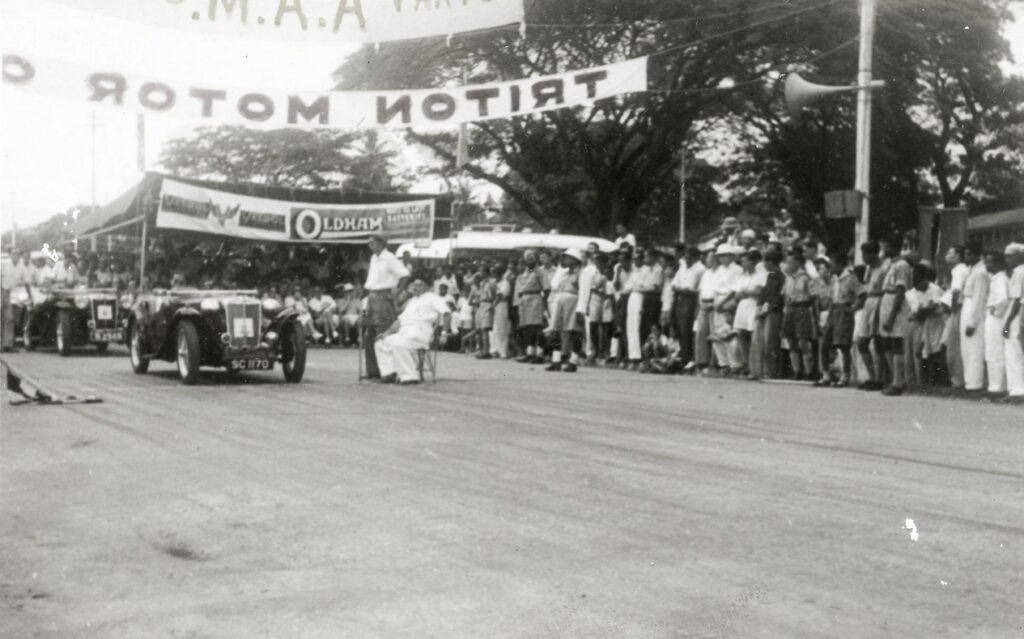
In the Federal Capital Kuala Lumpur, Lornie Road (now Jalan Syed Putra) provided a perfect venue for a mile-long sprint. Located along the Klang River between what is now Mid-Valley and Chinatown, the road was cordoned off for the state’s first post-war motor sport event in July 1949. See RACING IN THE FEDERAL CAPITAL.
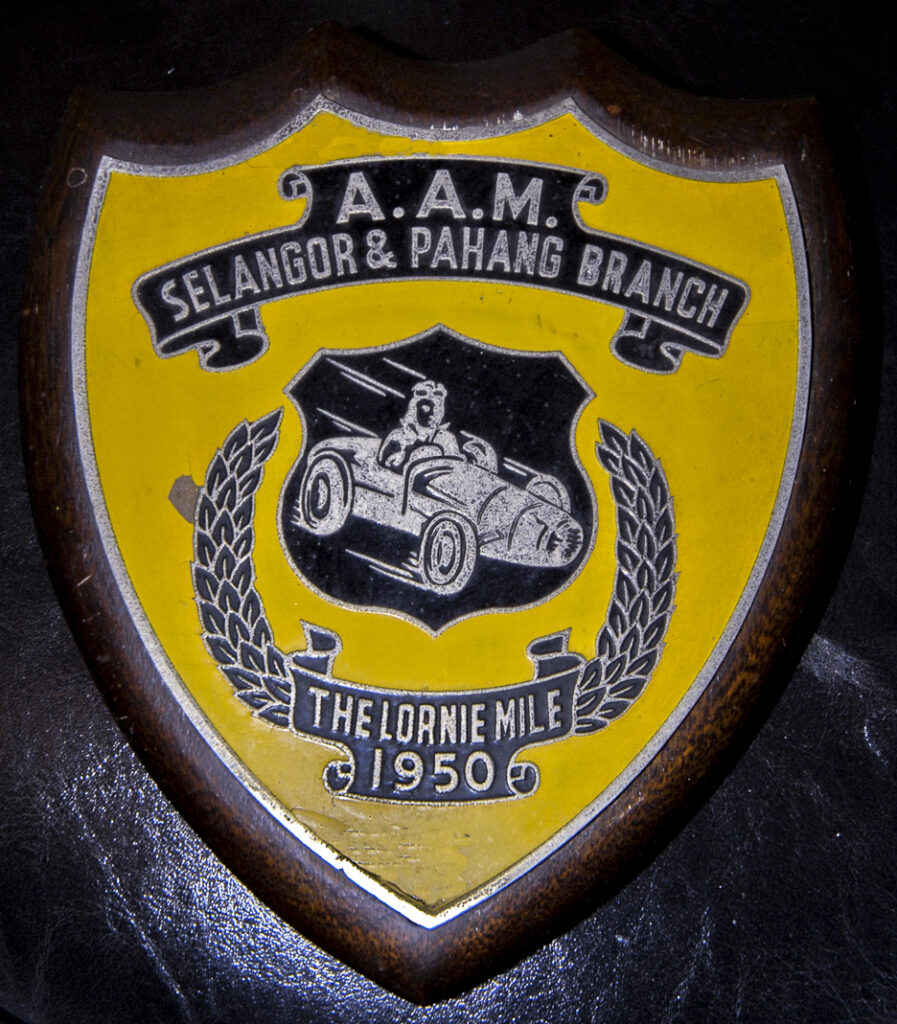
When it came to organising motor sports events, the AAM held the upper hand and the Selangor and Pahang Branch organised the Lornie Road Speed Trial on 16 July 1950, the second Lornie Mile held after the war.
The AAM’s role was evolving and organising a motor racing event was more than the organisation was prepared to take on. Similar to what had transpired in Singapore and later on in Hong Kong, the motoring enthusiasts leapt at the opportunity of establishing clubs to cater for their interests.
The AAM’s hold was broken on Boxing Day in December 1950 when Jennings’ Selangor Motor Sport Club pulled off the Kenny Rise Half-Mile Hill Climb in Kuala Lumpur, the last motor sports event for the year. There were 17 events run that weekend, 12 of which were for cars. FTD was set by a Selangor participant, Lim Wong Nyan, driving a Ford V8 L.A. Special (which was later sold to engineer Freddie Johns (and renamed the Black Ghost). Jennings won the 1500cc class in his Black Draught MG TC, which the Singapore press mislabelled “The Dread Nought”.
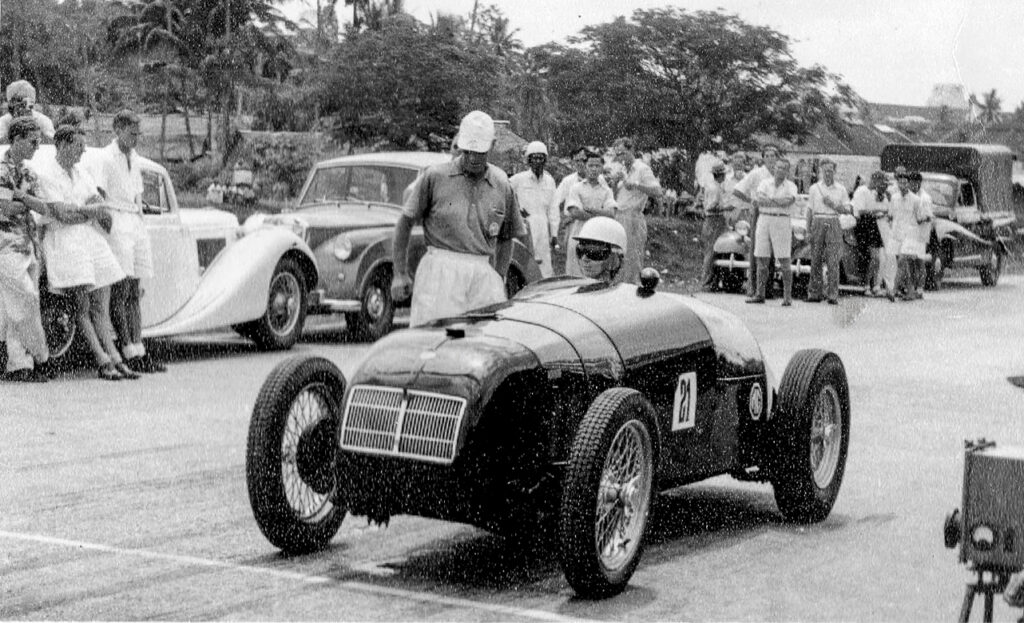
Ruth Jennings in the Black Draught Mk2 – Lornie Kilo, 22 June 1952. This Selangor Motor Sports Club event was recognised as the Second Kuala Lumpur Kilo. Ruth bagged the award for fastest woman driver at the meet.
Malayan Motor Sport Club – 1953-1965
On 18 March 1953, the Club changed its name to become the Malayan Motor Sport Club (MMSC), possibly, as one report put it, because the High Commissioner to Malaya, Sir Henry Gurney, declined to become patron of a club only associated with a single state. Consequently, MMSC became the de facto body representing motor sports in Malaysia.
The new Club had three key patrons: Yang di-Pertuan Agong Sultan Hisamuddin Shah (the second Yang di-Pertuan Agong of Malaya from 14 April to 1 September 1960, and the sixth Sultan of Selangor between 1938–1942 and again from 1945–1960. Sultan of Selangor); Tunku Abdul Rahman (later to become the father of Malaysian independence); and Dato’ Sardon bin Haji Jubir (Malaya’s Minister of Transport). Consequently, MMSC became the de facto body representing motor sports in Malaysia.
The newly formed Malayan Motor Sports Club ran its first event, the Lornie Mile speed trial, on 5th July 1953. Naturally, there was a new badge, the same outline but with a different crest and the word Malaya replacing Selangor on the top.
The newly renamed Club ran its first event, the Lornie Mile speed trial, on 5th July 1953.
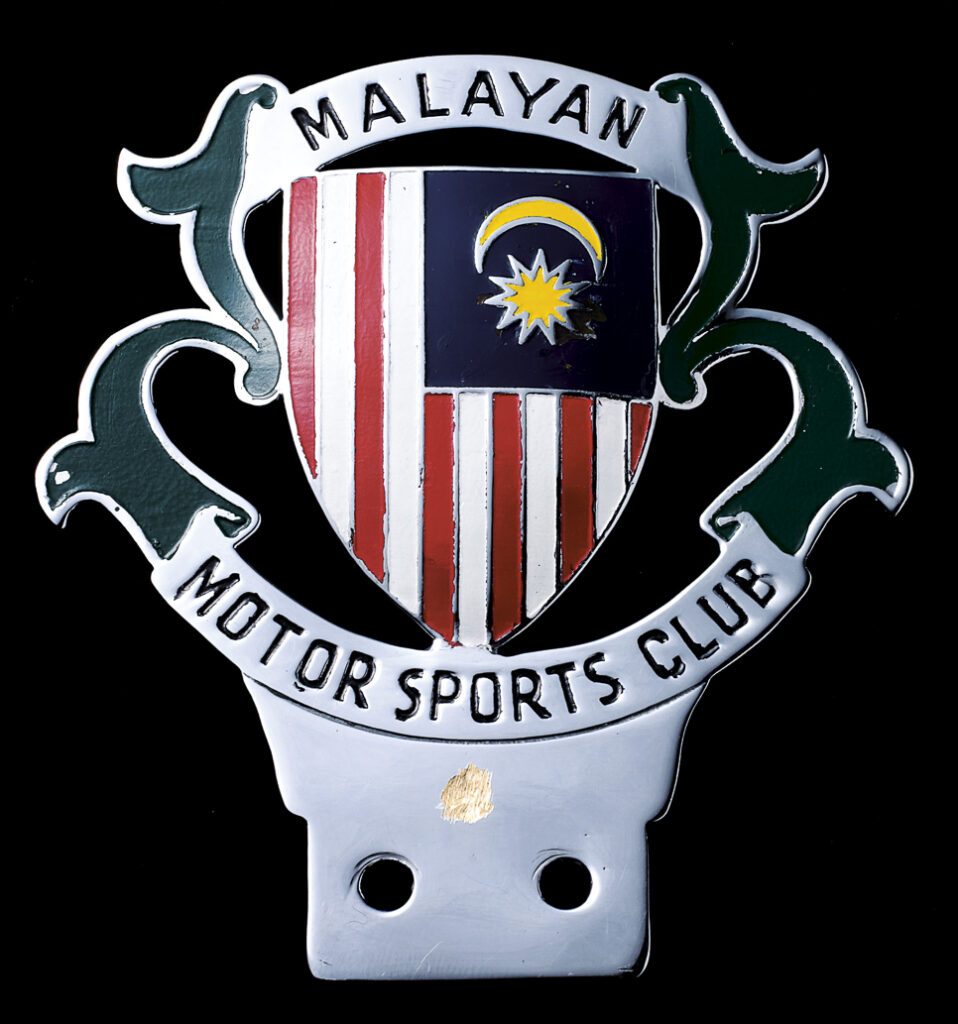
The Malayan Motor Sports Club grille badge of 1953 superseded the Selangor Motor Club badge that had first been issued in 1950.
Jennings relinquished his position as President of the club in 1954. The new president was Acting Commissioner for Malaya’s Civil Defence, Colonel J.D. Stewart. Stewart had assumed the post of Assistant Commissioner, Civil Defence in March 1952 and was later to become Assistant Commissioner for the Central Region of Malaya in 1955. His committee (1954) consisted of Club Captain and Vice President, Malayan Railways engineer R.W.H. Seymour; Borneo Motors’ Edgar L.G. Bailey, T.R.A. Hungerford, Chua Kim Seng, Mrs. R.W.H. Seymour, S.W. Coleman and A.G.C. Symonds.
That year, R.H.H. Davis was appointed president of the MMSC. Vice-President was Paul Gibbs Pancheri. Hon. Secretary was G.W. Gray; corporate man and later Chairman of Sime Darby, Dennis William Pinder, was Treasurer.
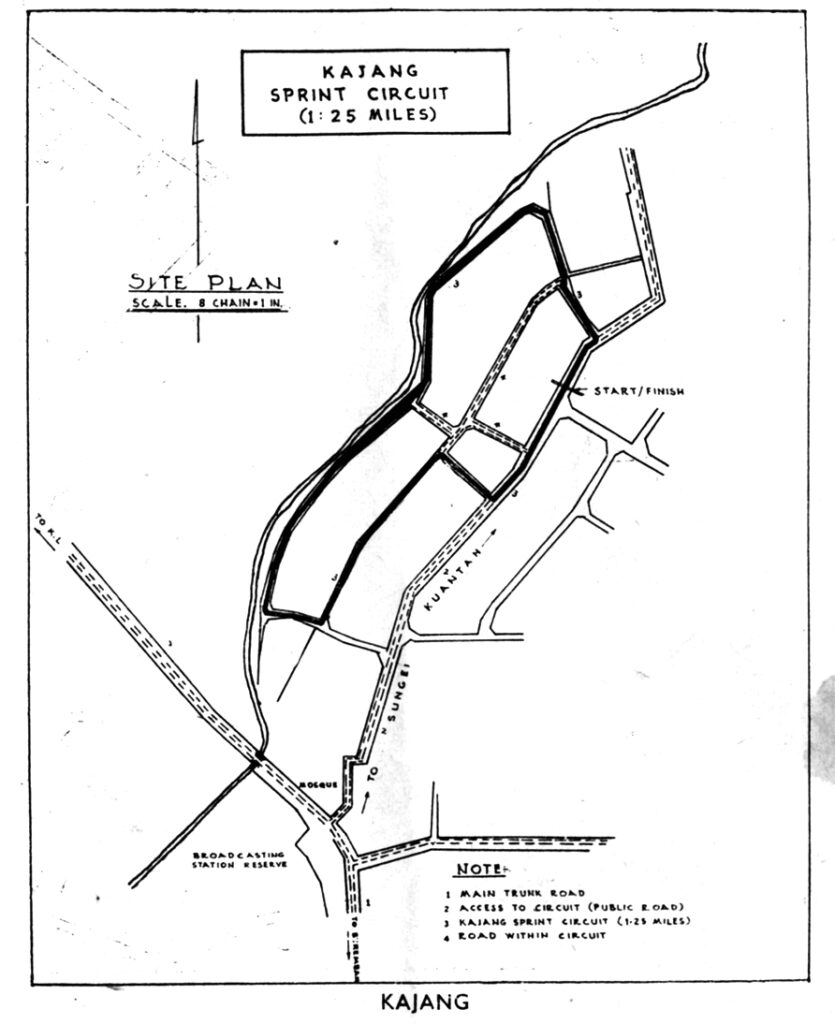
The MMSC were able to find a new venue to replace the Lornie Kilo. The event was the Kajang Sprint. The event was held on 27 July at Sungei Kantan Estate. Kajang Road was 15 feet wide and had a 5 foot grass verge either side of the undulating tarmac (laid over laterite). It was a clockwise course.
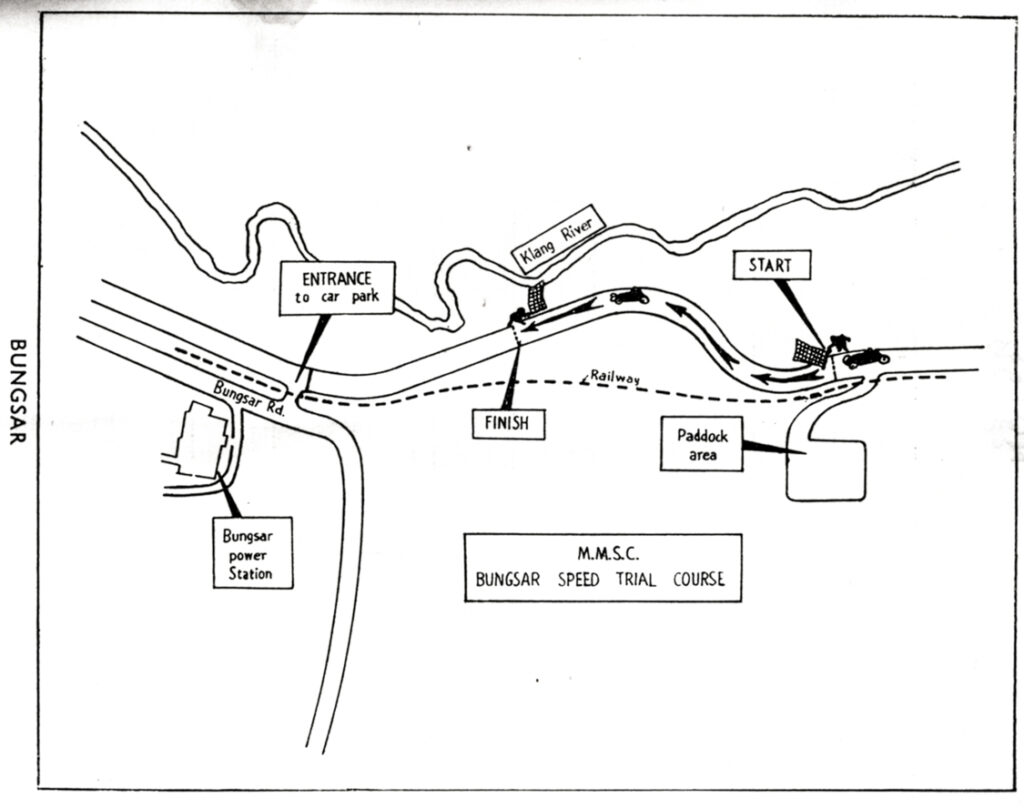
Another short-lived option that was tried out by the MMSC was the Bungsar Speed Trial, first held on 7 December 1958.
In the early 1960s and after much lobbying, the MMSC tried out a sprint in Kuala Lumpur’s Diplomatic Enclave. In March 1960, the newly developed Diplomatic Enclave of Kenny Hill and the Lake Gardens came alive with the vibrant, discordant sounds of production and race cars from the furthest reaches of the Peninsula. The fastest time of the day (FTD) award went to Singaporean racer and race car builder Lim Peng Han in his Lim Special.
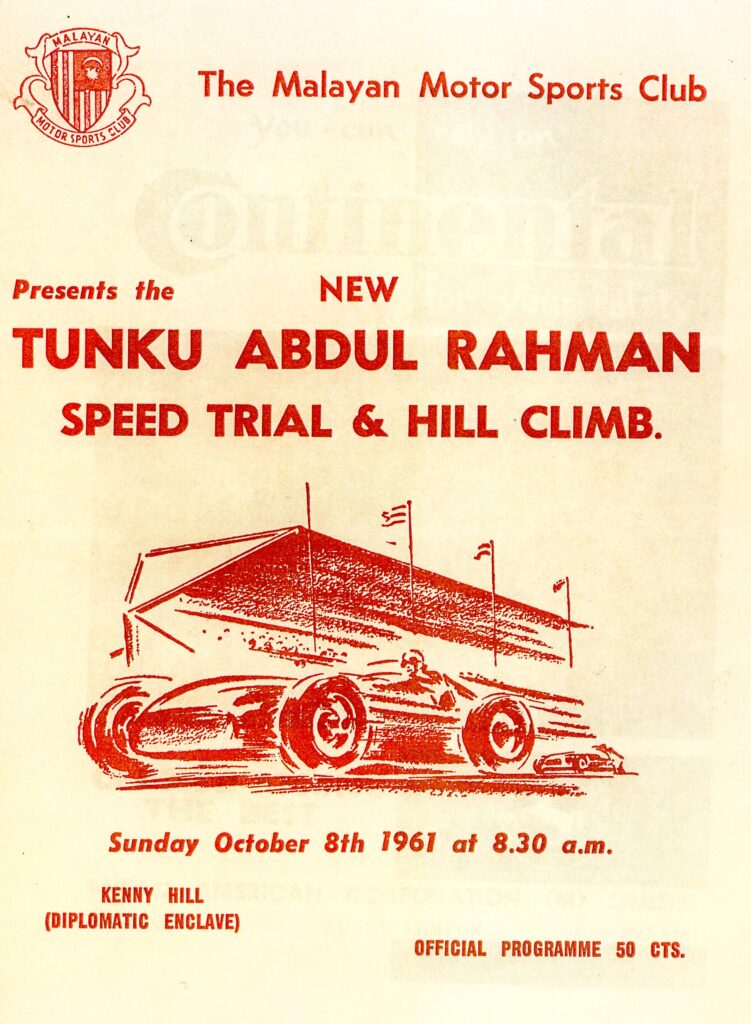
The MMSC took the bold step of hosting an even bigger event in October 1961, incorporating a 2,000-yard (1.83km) Hill Climb at the Diplomatic Enclave. They called it the New TAR Speed Trial and Hill Climb, to honour Malaysia’s first Prime Minister from independence in 1957, Tunku Abdul Rahman Putra.
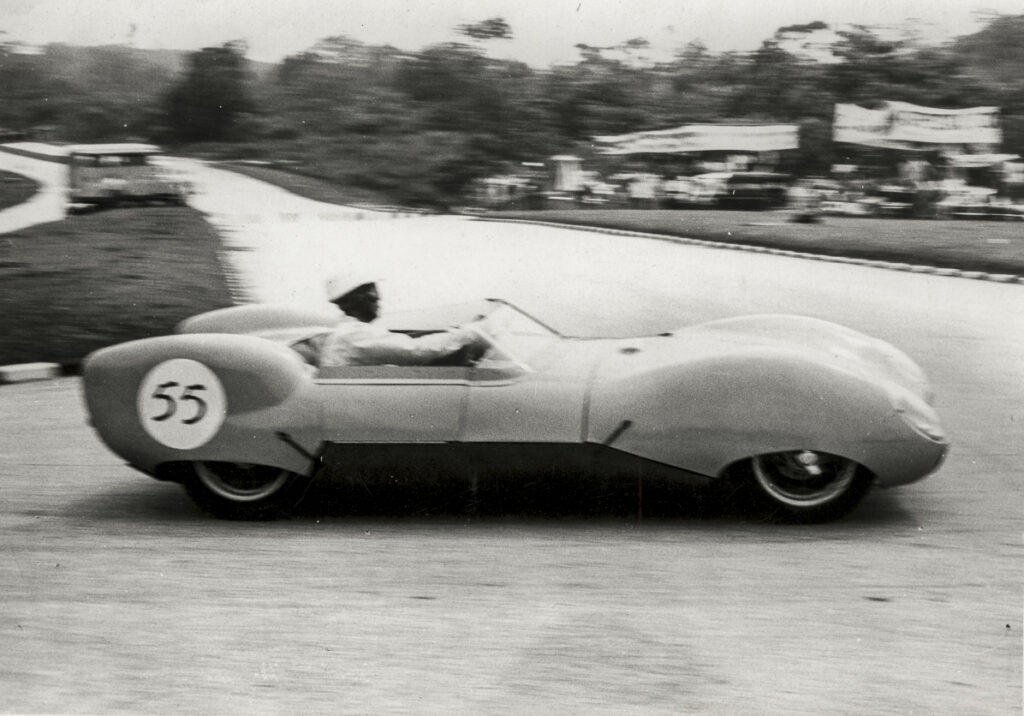
Racing in the Federal Capital in October 1961 with Saw Kim Thiat and his Lotus Eleven Climax.
The MMSC’s 1960/61 committee consisted of President Dr. William H. ‘Bill’ Dyson75; Leslie A. Worley as Vice-President; Mark G. Spragge as Club Captain; Mrs Worley as Secretary, Desmond Gustavus as Treasurer; Ismail bin Abdul Majeed as Social Member; Lam Im Kong in charge of motorcycling; PWD Engineer in KL Sabathipillai Theraviam, Michael Chee, Ian M. Barnwell and W. Carter on the general committee.
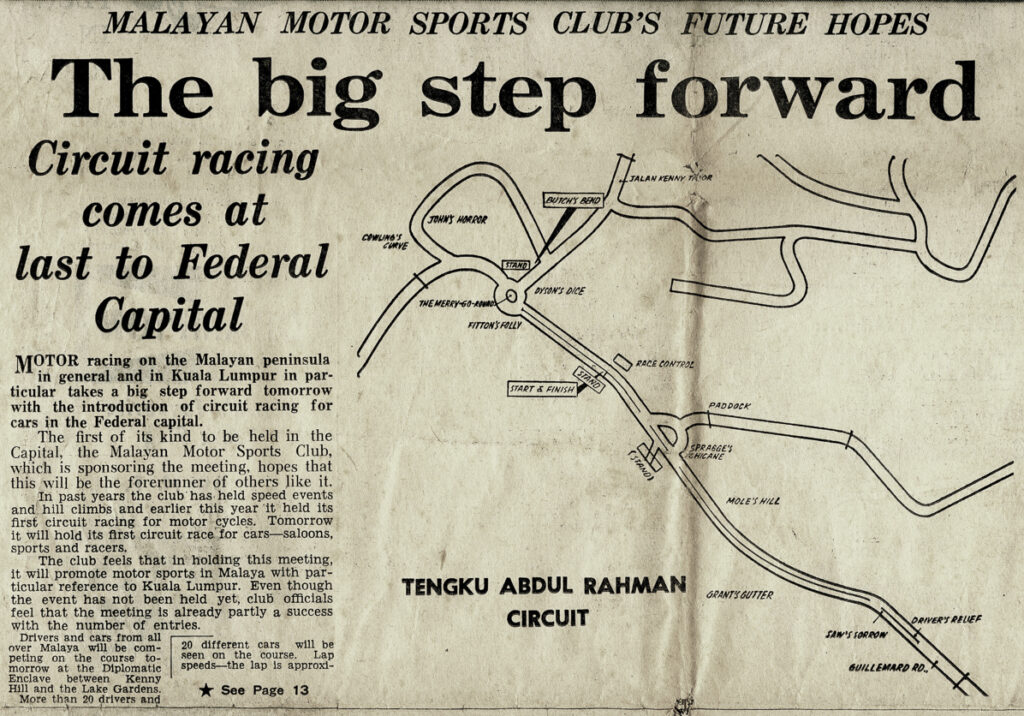
Malayan enthusiasts had it good in 1962. They could participate in no less than ten events in the region, starting from the Gap Hill Climb in Singapore in February and finishing off with the MMSC’s Tunku Abdul Rahman Circuit Races in November.
The Diplomatic Enclave races were run from 1961 till 1963, the latter two years as a mass-start circuit race (the 1962 event was now officially the First Tunku Abdul Rahman Circuit Race).
In 1964, the Federation International Automobile (FIA) sanctioned motorcycle racing for the MMSC’s third TAR Circuit Race which was set for 4-5 July 1964, but at new 2.7-mile venue in Petaling Jaya which had celebrated its tenth birthday in Feb 1963 as Malaysia’s first ‘new town’. The Start-Finish line was at S19-1, close to the Rothmans office. The course ran along Jalan University, into Jalan Kemajuan and Jalan Bersatu, and back again to the Rothmans building. Races for cars were included – a move that proved very popular amongst racing enthusiasts.
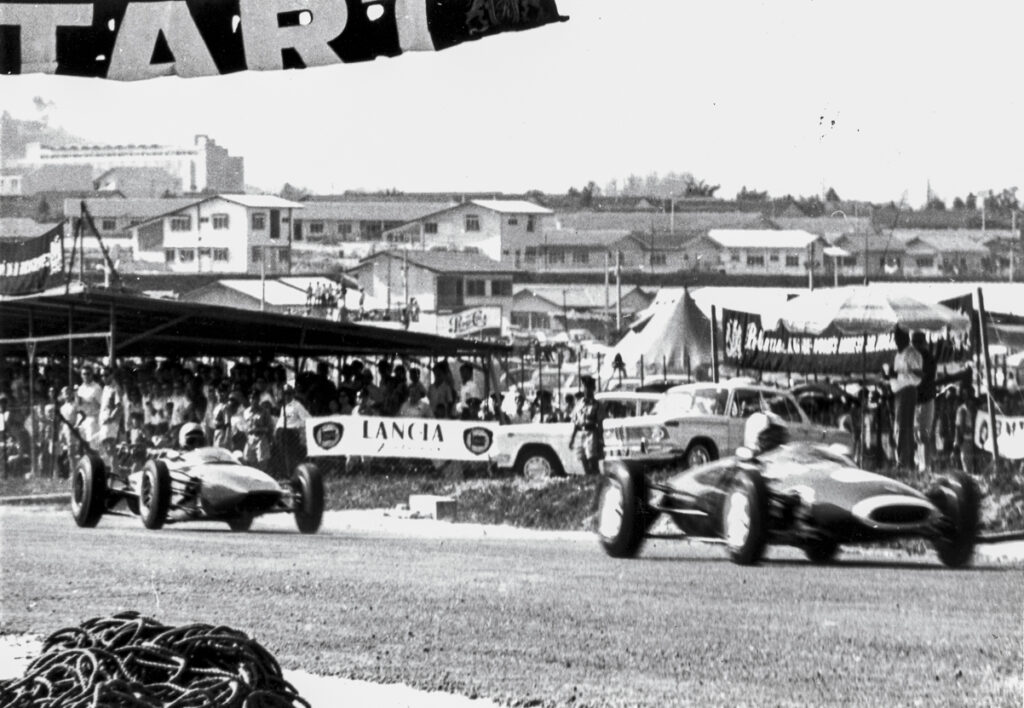
The Petaling Jaya street circuit was the venue for MMSC’s 1964 TAR Rothmans Challenge Trophy race in July.
The course was adjusted slightly for the 4th TAR Circuit Race in 1965, and the following year, the 5th TAR races were held at a site near Sungei Renggam, yet another temporary location, but one which the organisers hoped would accommodate 50,000 spectators.
A permanent course was planned for here, by extending the 2.075-mile temporary circuit to 2.3 miles, and was ready in 1967. A permanent circuit transformed the complexion of the sport in the region and firmly established Malaysia as a serious venue for motor racing in the modern era.
Malaysian Motor Sports Club – 1965-present
With Singapore’s separation from Malaysia in 1965 came yet another change of name for the MMSC where ‘Malayan’ was replaced by ‘Malaysian’ to reflect the new status. Pressure was mounting from Club members who wanted a permanent motor racing circuit to be constructed in the State.
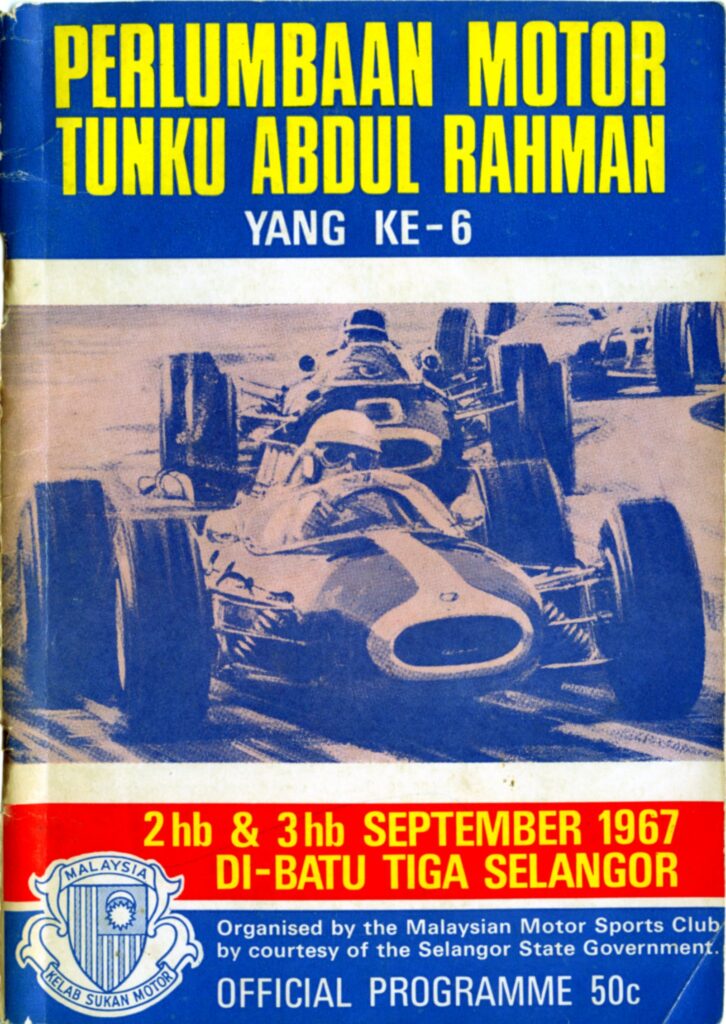
The program cover of the very first race on a permanent circuit in Asia – at Batu Tiga in September 1967. This was not the First Selangor Grand Prix but the sixth Tunku Abdul Rahman Circuit Race.
Construction of the Batu Tiga Circuit in 1967 sealed MMSC’s reputation as the leading motor sports club in the region. The Club’s focus was now to develop grassroots motor sports.
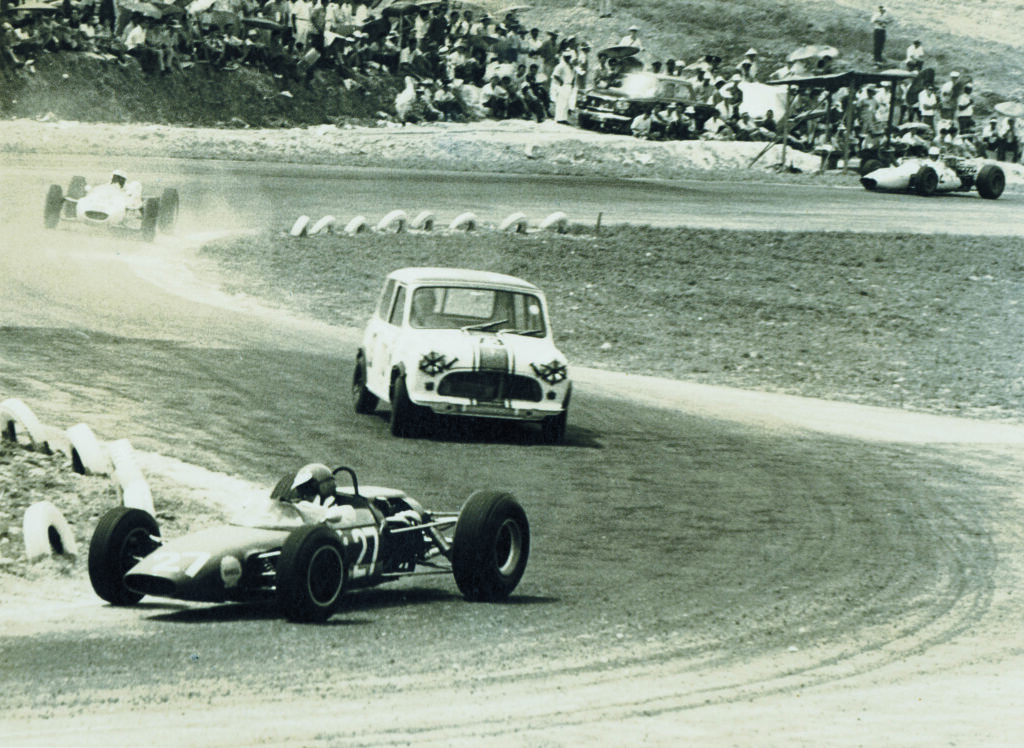
Rodney Seow and his Merlyn Mk10 Twin Cam, showing how it ought to be done at the brand new Batu Tiga Circuit in August 1967.
Construction of the Batu Tiga Circuit in 1967 [see RACING IN THE FEDERAL CAPITAL] sealed MMSC’s (Kelab Sukan Motor Malaysia) reputation as the leading motor sports club in the region. The Club’s President was Ismail bin Abdul Majeed and Vice President was G.K. Warren. Club Captain was Bob Usher76, Club Secretary was Desmond Gustavus with Competition Secretary Lt.-Col. Trevor W. Butcher.
The design of the track was by a committee of Malaysian Motor Sports Club members led by Chairman John M. Brown (who was also the Managing Director of Rothmans of Pall Mall Malaysia77). Substantial support came from corporates – Rothmans, Philips, Omega, Tiger Balm, Goodyear, Frazer & Neave, Cold Storage, Nestlé’s and Wearne Brothers.
The Club’s new role and focus was now to develop grassroots motor sports. There was still the issue of hosting the First Selangor Grand Prix – and this came about 6-7 April 1968. These were exciting times for the club. Trevor Butcher was now Vice President and new Club Captain was Tony Maw (Tony’s wife Linda was Social Secretary). Thomas Tjoa was Competition Secretary. There was now an opportunity to up the ante and hose two Grand Prix races annually. The second one, called the Malaysian Grand Prix, was held 7-8 September 1968, though it was referred to as the Seventh Tunku Abdul Rahman Circuit Race.
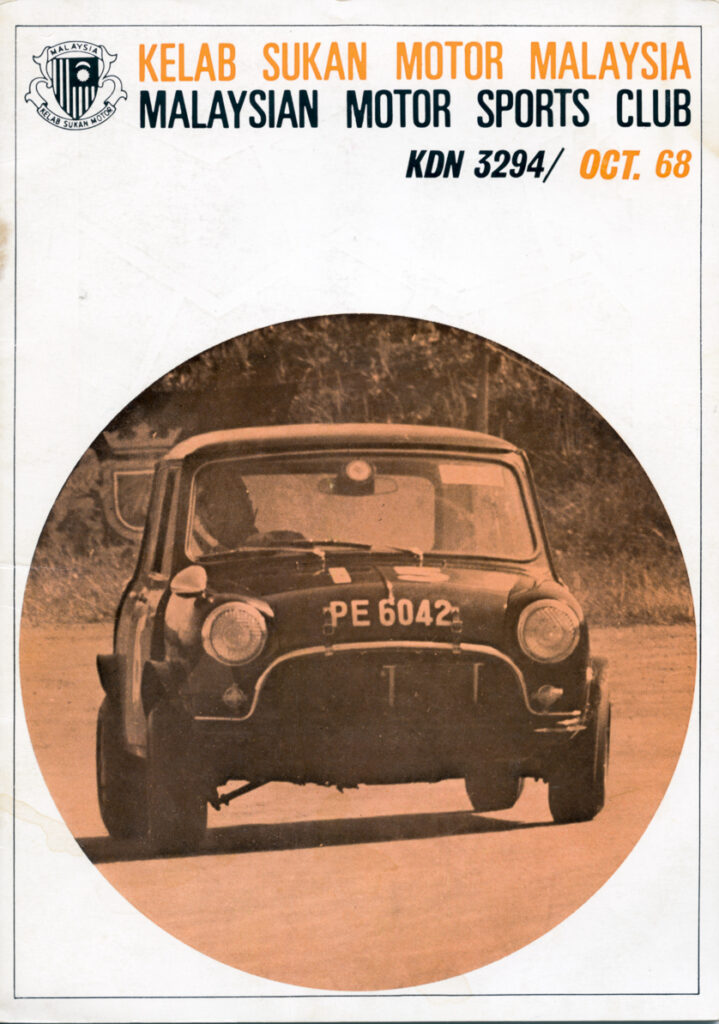
In October 1968, the new circuit was the venue for the first Clubman’s Meeting, which was very well attended and featured in the club’s October magazine. One the cover is Eddy Choong, winner of the Sultan Cup at the Kuala Kangsar grass track in September 1968 in his Mini.
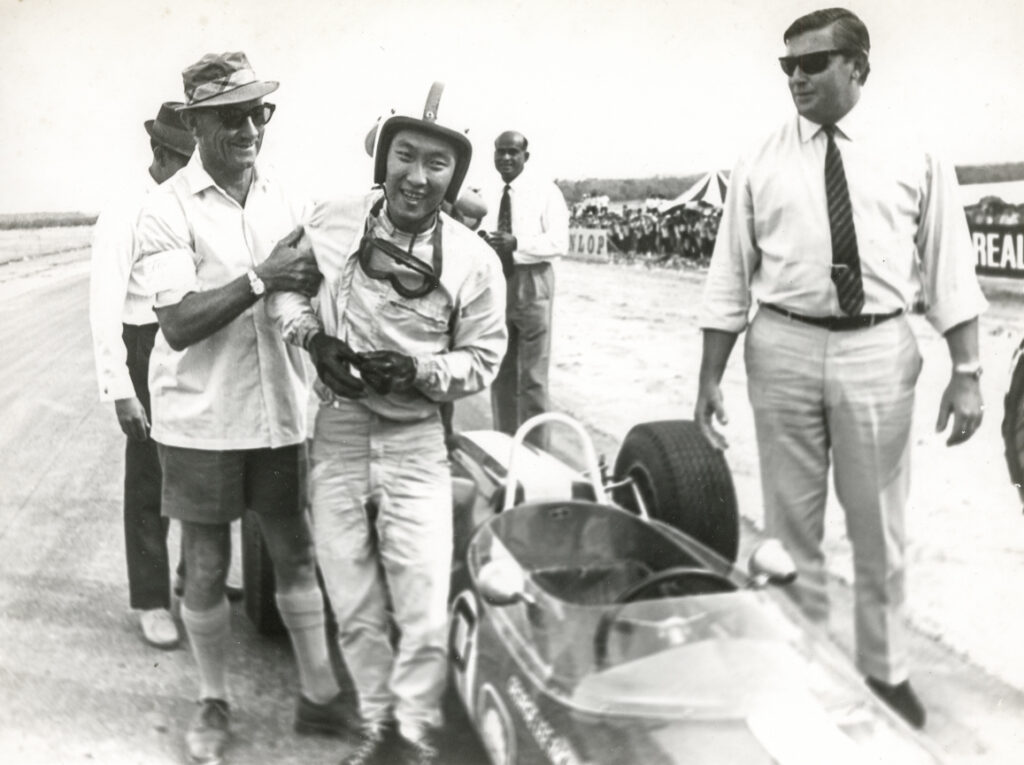
The two key men of the MMSC from the mid-1960s until the early 1970s its Vice President Trevor W. Butcher78 (left) and Hon. Secretary (and magazine editor and publisher) Desmond Gustavus (right).
Gerry W.A. Hunt, better known for racing his Ginetta G5 and later on, Ginetta G4, took over Tony Maw’s position as Club Captain for the 1969 season. He was appointed Vice President the following year and the role of Club Captain went to Francis Jan Bussell. Butcher took over the role of Public Relations Officer and Harvey Yap appeared on the committee for the first time. Desmond Gustavus retained his position as Hon. Secretary.
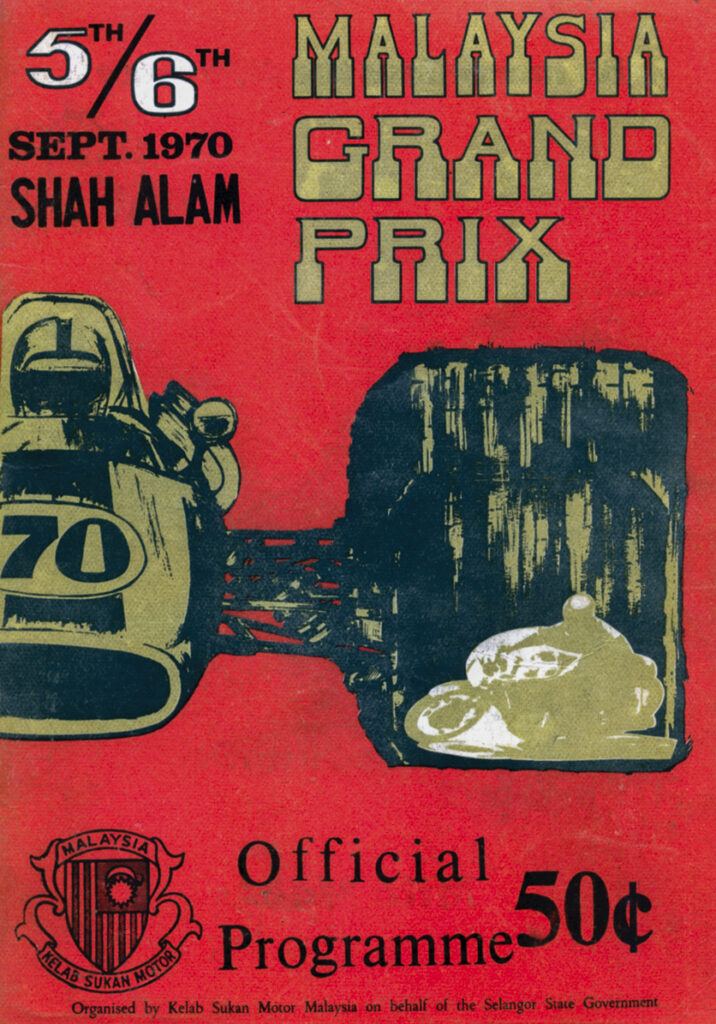
The MMSC were able to hold two major events annually from 1968, the Selangor and the Malaysia Grand Prix races over Easter and in September.
By 1971, there was a new President, Dato Lokman bin Yusof. The role of Vice President went to Gerald Vessey, Marketing Director of Rothmans of Pall Mall Malaysia79. This, as noted in SMOKE GETS IN YOUR EYES, reflected the tobacco company’s alignment with Malaysia motor sports. Harvey Yap, then working for Datsun importers Tan Chong & Sons was now Club Captain.
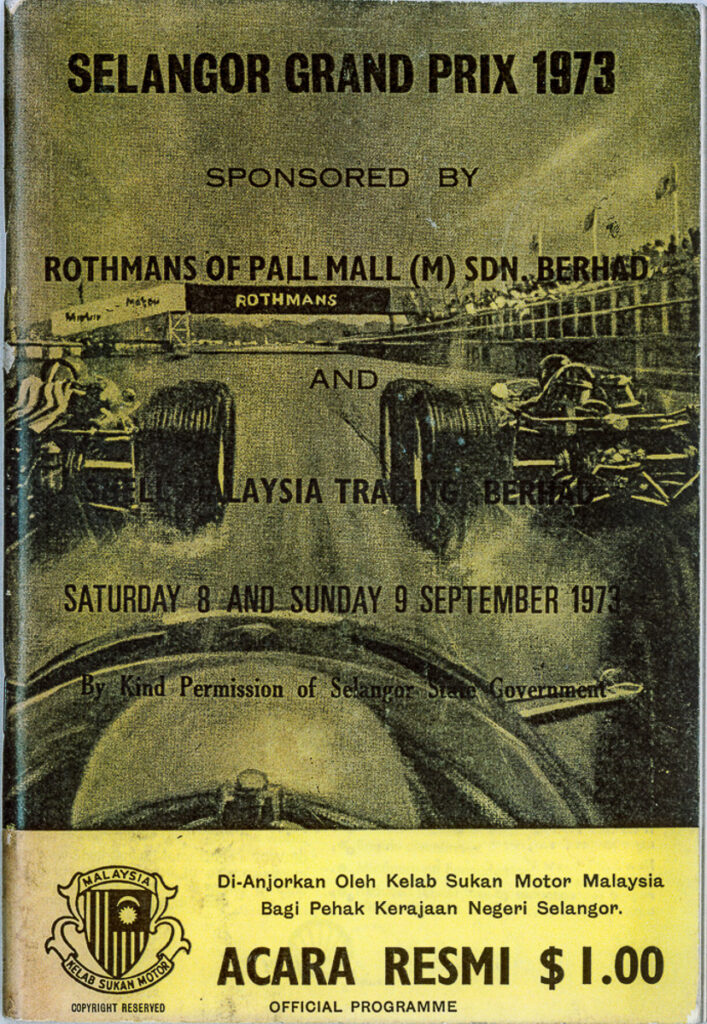
Rothmans (and Shell) were visibly supporting the sport and the MMSC’s Grand Prix program in Selangor in 1973. Rothmans would continue to support the MMSC for the next few years.
The impact of the 1973 oil crisis put a spanner in the works but the MMSC rode it out with the major events (the Malaysia and Selangor Grand Prix races) supported by key sponsors such as Rothmans of Pall Mall (Malaysia), Shell Malaysia Trading Bhd. and Nestlé (see THE FORD NESCAFÉ ESCORTS: Debunking The Myths for Nestlé’s involvement in the sport). The Club’s President for 1973 was Tahir bin Rahim. Vessey retained the role of Vice President and Club Captain was now Percy Chan (see RIDES OF MARCH – Part 1 and RIDES OF MARCH – Part 2).
The history of the MMSC from 1968 onwards will be for another article on the RMA website although much of this period has been reflected in THE FORD NESCAFÉ ESCORTS: Debunking the Myths and in Parts 1 & 2 of RIDES OF MARCH.
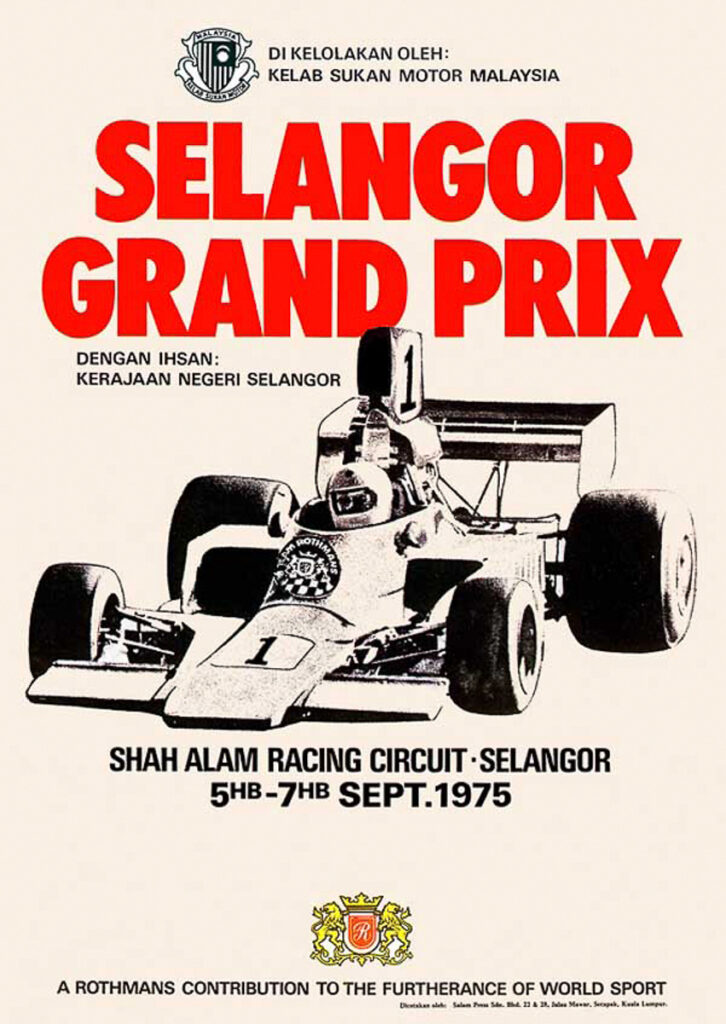
Poster from the 1975 Selangor Grand Prix, another MMSC event backed by Rothmans.
Shah Alam Motor Racing Association (SAMRA)
As the events at the Batu Tiga Circuit grew in stature and size, the need soon arose for further funding and a more professionally run body to oversee the circuit and its activities. And this is where the role of the club had been eclipsed by the corporatization of the sport in Malaysia.
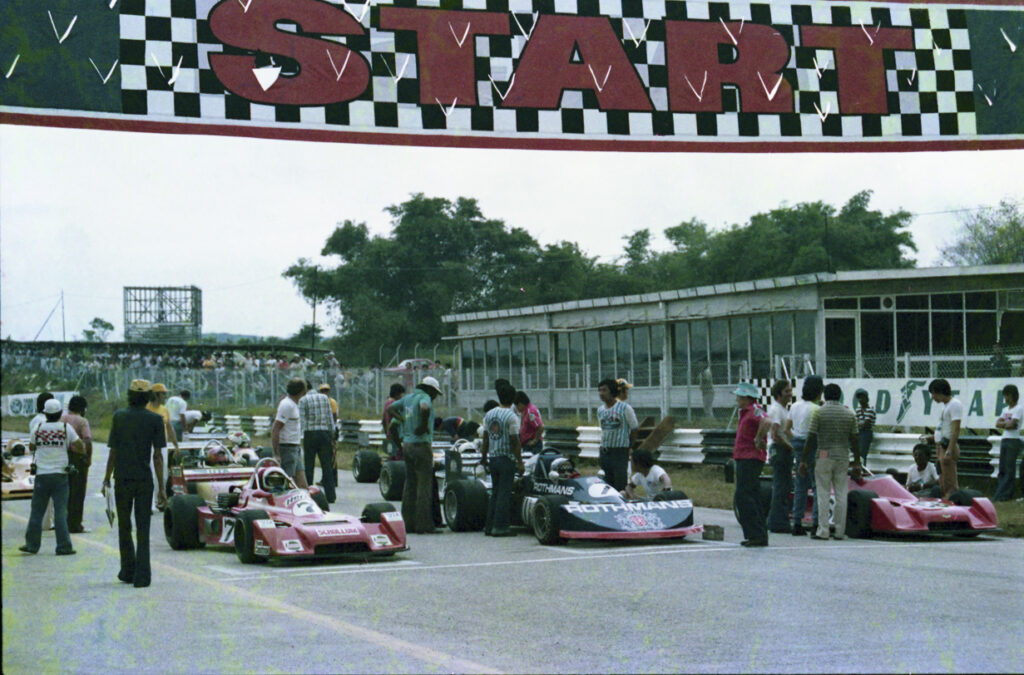
The May 1978 Malaysia Grand Prix saw SAMRA debut as the promoter of the event. No longer was the MMSC solely in charge of running the Grand Prix at Shah Alam.
A non-profit organisation, the Shah Alam Motor Racing Association (SAMRA), was thus established in 1978. It was unusual in one respect: its members comprised of Malaysian companies; namely, F&N, Goodyear, Rothmans, Shell, Wearne, Nippon Paint, Syarikat Guan Hoe Suzuki and Inchcape. Each invested RM$70,000 to upgrade the facilities around circuit. SAMRA had the desirous effect of lifting the burden of administrative and financial responsibility from the MMSC. Albert Anthony of Rothmans, an investor in the circuit since its creation, recalls how it all started. “Initially…we ran [the races] in the industrial estates. Eventually, we managed to get a few companies together to build the track. The track people made more money out of the night races – the Saturday Night Fever races. No rules and regulations.”
SAMRA’s debut as promoter of the Malaysian Grand Prix was in 1978. The organisation was given a 10-year lease on the Shah Alam Circuit with the objective of providing facilities at the circuit, managing and organising events at the circuit. The MMSC continued to run the events but without the burden of administration, publicity and financial duties which were borne by SAMRA.
Most of these sponsors had been behind Phase One of the creation of the Batu Tiga circuit at Shah Alam (the track was ready by August 1967). The original backers of the Batu Tiga circuit were Rothmans, Wearne Brothers Group, Goodyear, Fraser & Neave, Omega, Tiger Balm, Nestle’s, Sime Darby, Cold Storage and Philips.
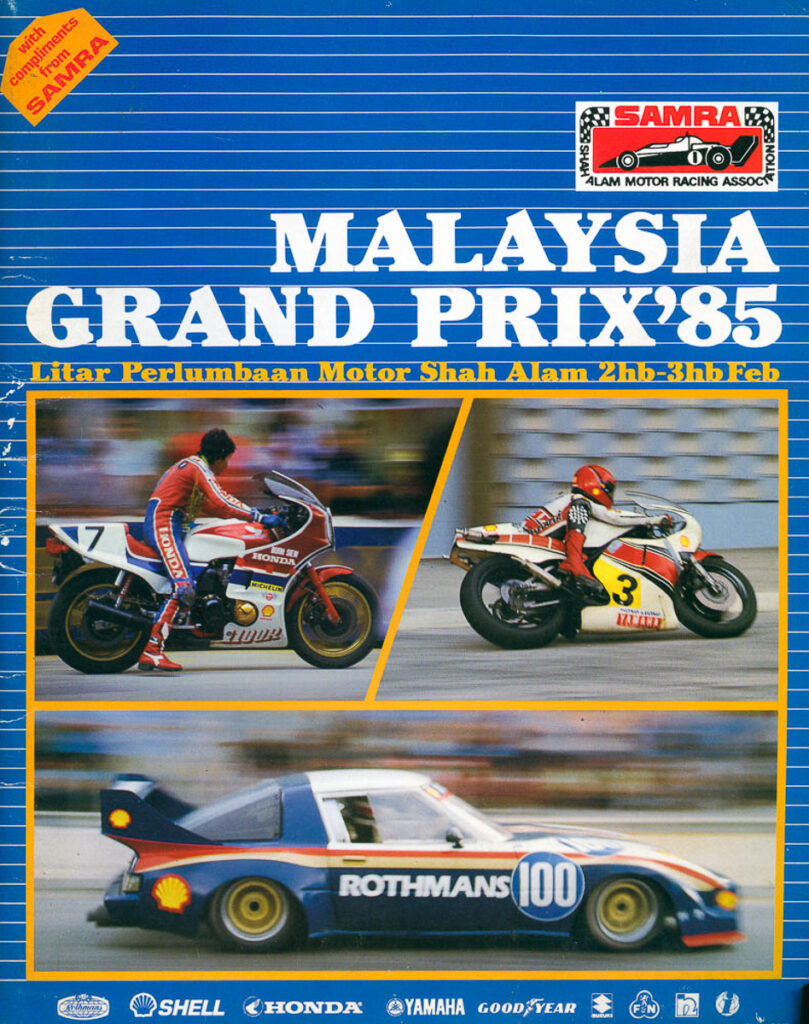
The 1985 Malaysia Grand Prix was a SAMRA event.
By 1986, talk of track closure was rife within motor sport circles as costs escalated and funding dried up but not before the 1 December 1985 World Endurance Championship (for story of the Selangor 800km see WARM RAIN & AN AUTO BOX) . The cost of organising, maintaining and owning a permanent racing circuit had become too much of a burden for SAMRA, and pressure came from within to privatise the facility in 1986.
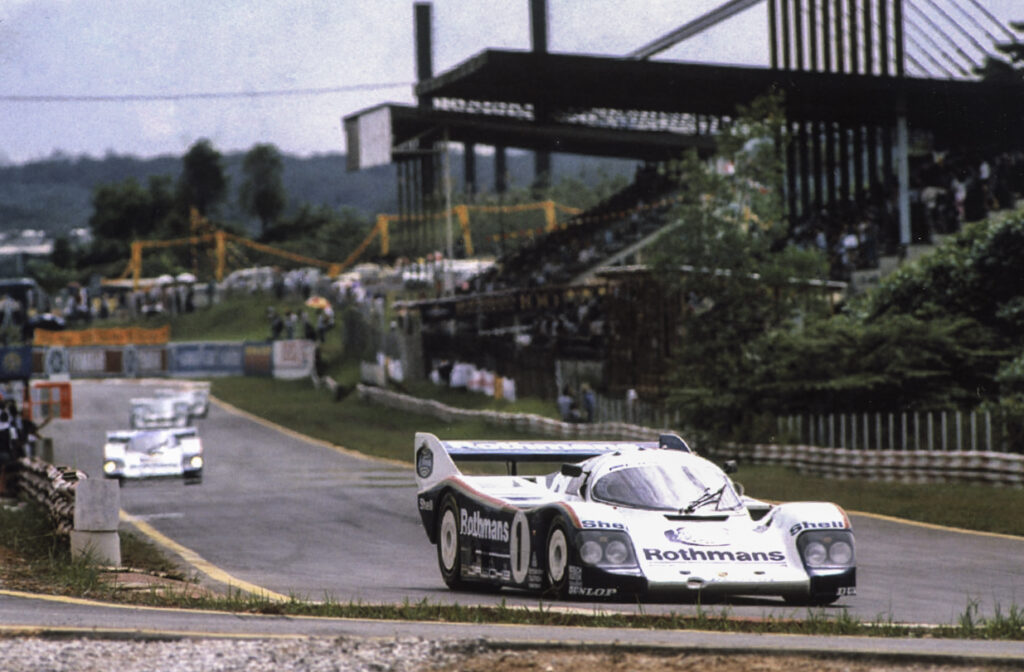
The Selangor 800km was held in December 1985.
Selangor’s Mentri Besar (Chief Minister) was adamant that the circuit would continue to operate and that the State Government would “see to it that Batu Tiga was not removed from the international motor racing map”. By then, SAMRA had debts of about RM$1 million and were contemplating selling off the spectator stands, guardrails, polyurethane blocks and office equipment.
With SAMRA’s lease on the circuit due to expire in March 1988, the Selangor State Government was keen to ensure that the track could be integrated into plans for a Sports and International Centre and continue to operate profitably. The Shah Alam Circuit was seen as a big tourist draw and the Selangor State government recognised its importance.
Things came to a head in May 1987 when the Federation Internationale de l’Automobile (FIA) suspended Shah Alam’s international licence following a surprise visit by their track inspector, John Corsmith. Corsmith evidently did not like what he saw. SAMRA was caught out as new safety standards meant further investment into the circuit. A new leaseholder emerged and took over the running of the 40-hectare facility. It was renamed the Shah Alam Motorsports Paradise (SAMP) and continued to host international events. But that’s the politics for the local experts to expound on.
Malayan Vintage Car Register – 1954-1967
The Malayan Vintage Car Register (MVCR) was unofficially formed in June 1954 by a small band of enthusiastic plantation managers and expatriates led by Anthony M. Gartshore80 and Kedah and Perlis State Engineer, George Settle Glaister. The club’s first magazine was issued as a quarterly review in the autumn (September) of 1958.
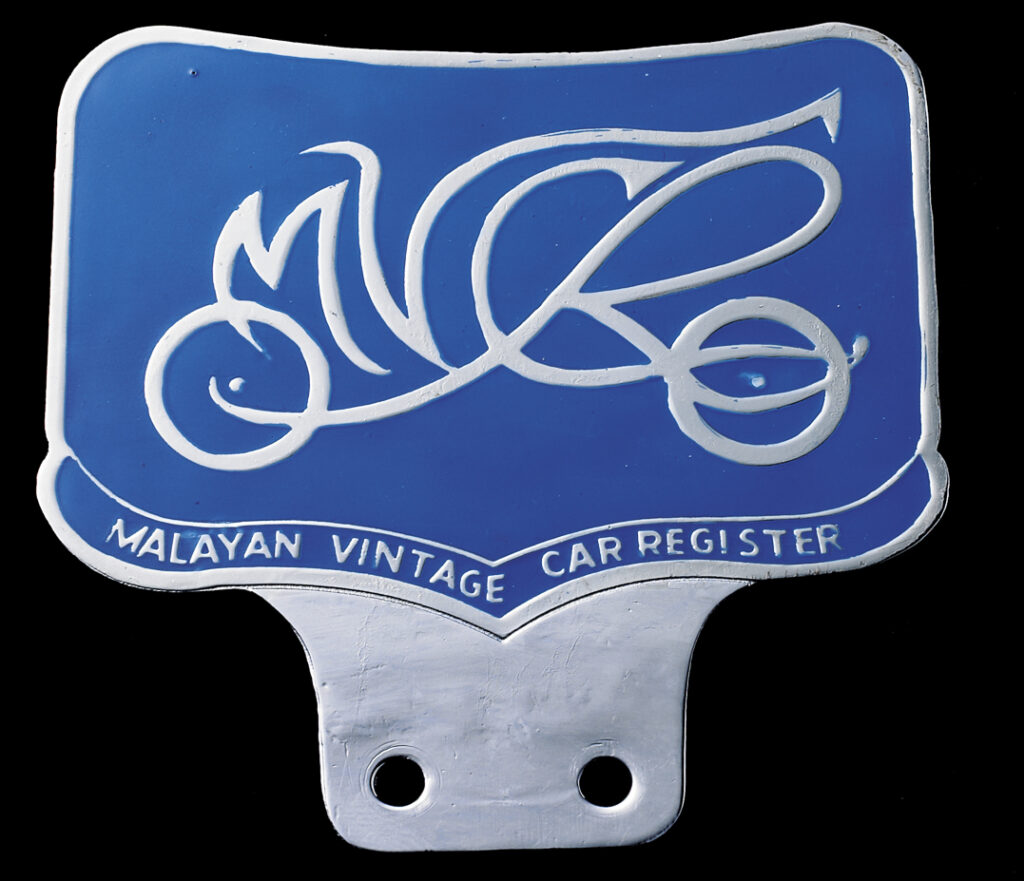
This was the original badge of the Malayan Vintage Car Register, prior to Singapore’s independence in August 1965.
In February 1955, having failed to gain the support of the Singapore Motor Club, they approached the Malaysian Motor Sports Club with the idea of forming a Vintage section within the Club. The MMSC acquiesced and on 8th June 1955, Gartshore was elected the first President of the Vintage section.
A rift soon developed that led to the departure of the vintagents on 1st September 1956. The MVCR was subsequently established as an independent Club with Bill Jupe81 as its President, Secretary, Treasurer and Editor!
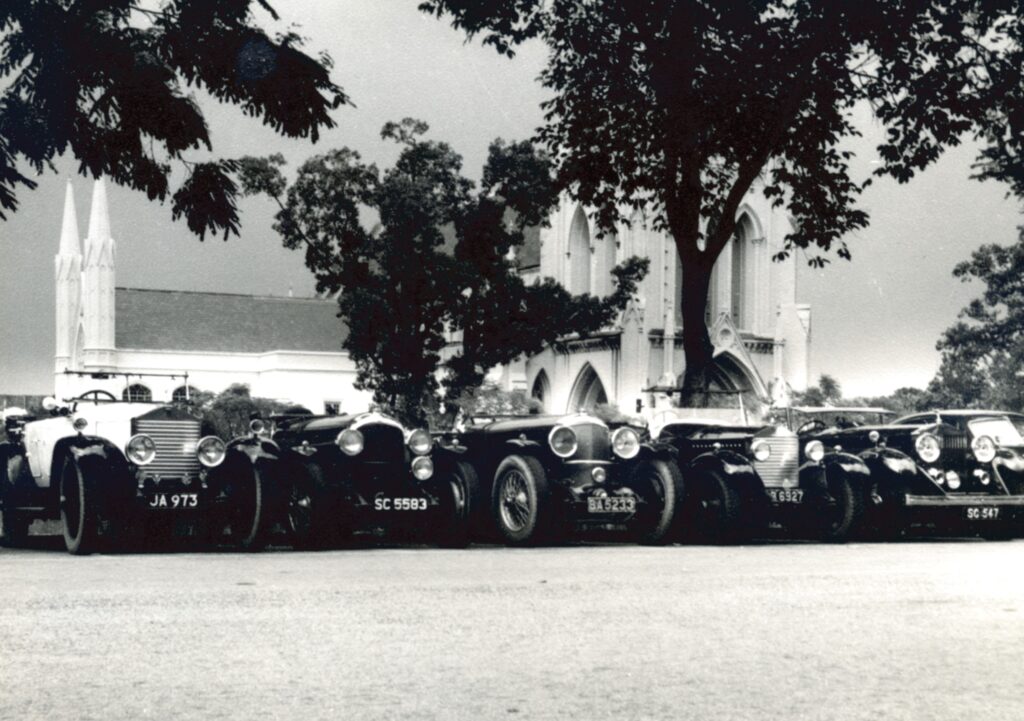
A gathering at the Adelphi Hotel in Singapore on 28 March 1953 to investigate possibility of forming a Vintate Motor Club. The cars include Rolls Royce sandwiching a pair of Bentleys – SC5583, Paul Gibbs Pancheri’s 1927 4 1/2-litre Bentley; BA5233 – Gordon ‘Jumbo’ Lang’s Bentley.
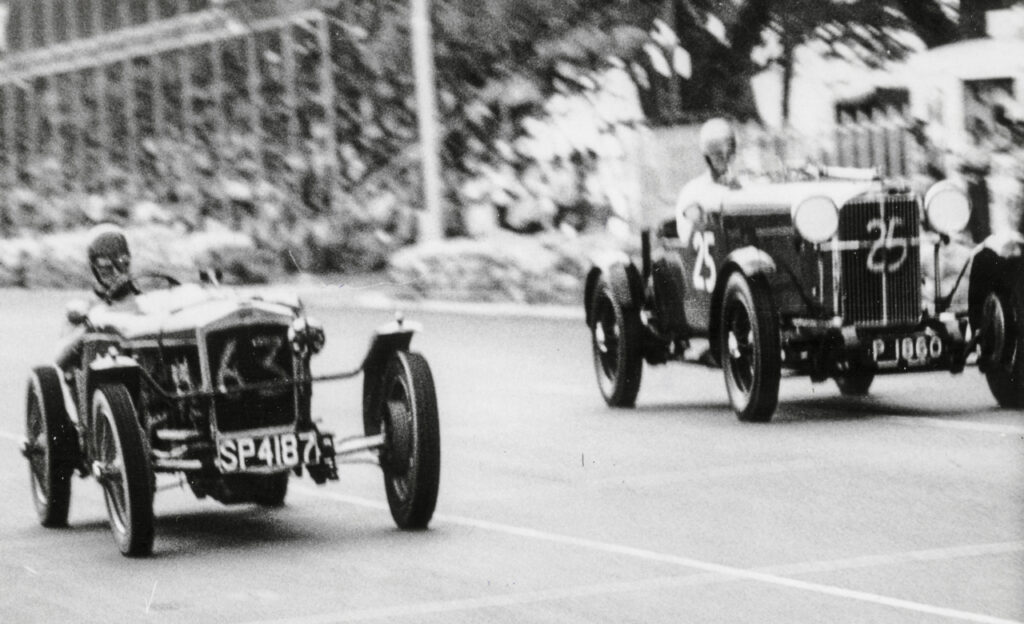
Vintage car club members were usually invited to race their cars at the regional Grand Prix races. This photo is from the 1963 Johore Grand Prix and shows David Morton’s “Yellow Peril” Sunbeam Speed 20 (right) dwarfing John Mobbs’ Frazer Nash (left).
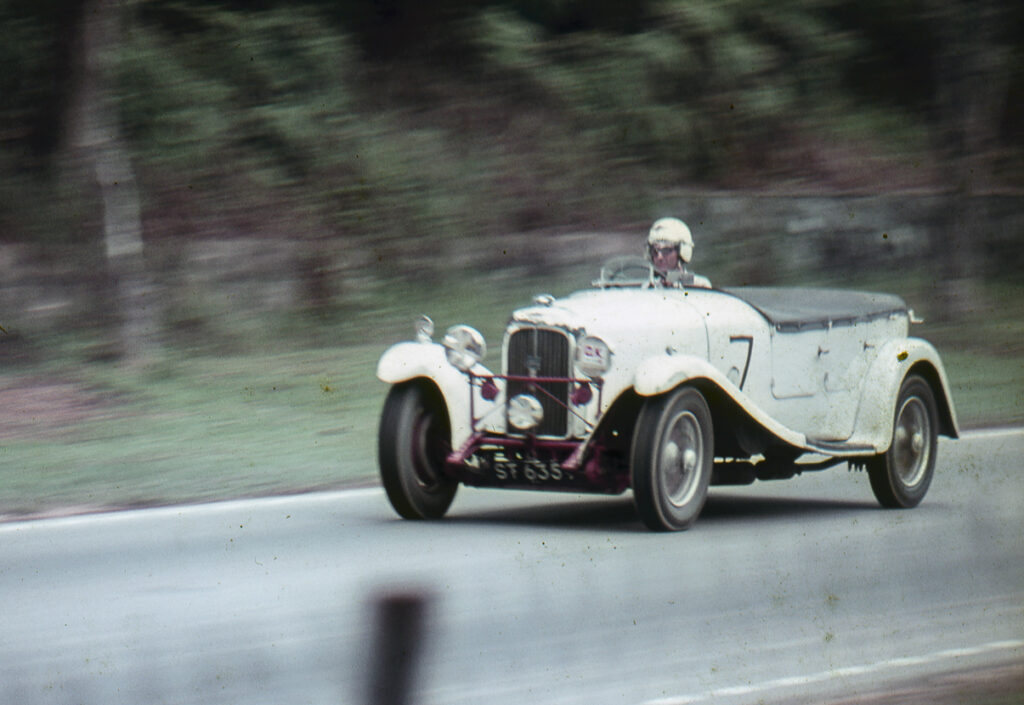
The MSVCR were offered a Handicap support event for the 1970 Singapore Grand Prix. The photo shows Mike Truter in his six-cylinder 2-litre Lagonda 16/80.
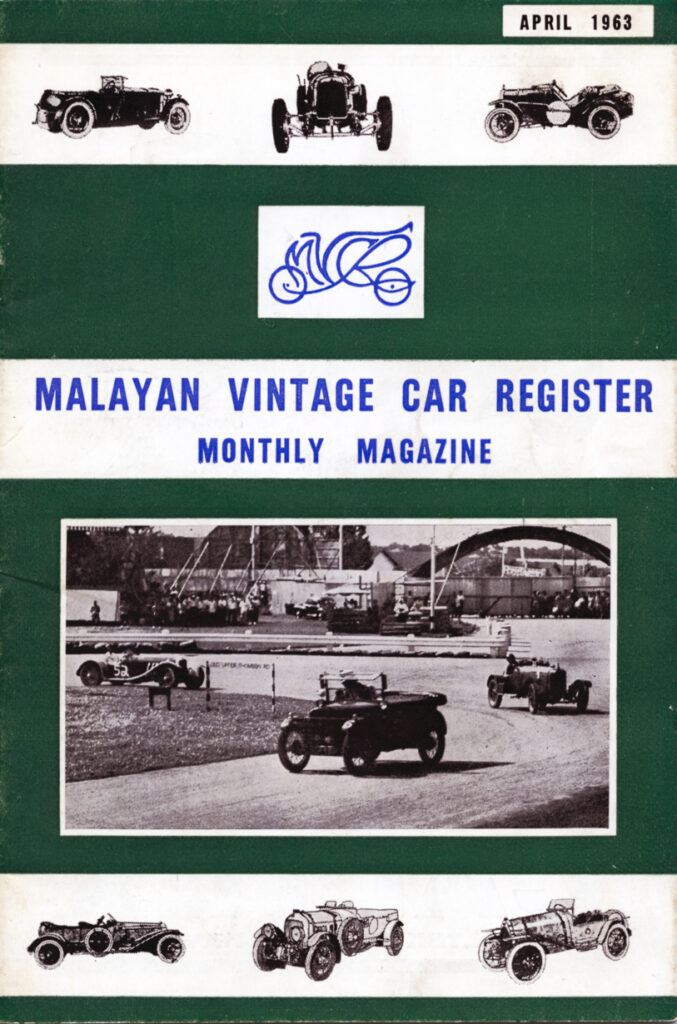
An early edition of the MVCR’s monthly magazine.
For the club’s badge, the MVCR had obtained approval from the Veteran Motor Club of America to copy their badge design. In 1967, the Club adopted a name change – it was now the Malaysia and Singapore Vintage Car Register. Its early history is documented in a book written by Henry Stonor and Brian Tyler titled Vintage Motoring in Malaya (privately published July 1977). The post separation history of this club is perhaps better left to the vintage car experts of Malaysia and Singapore.
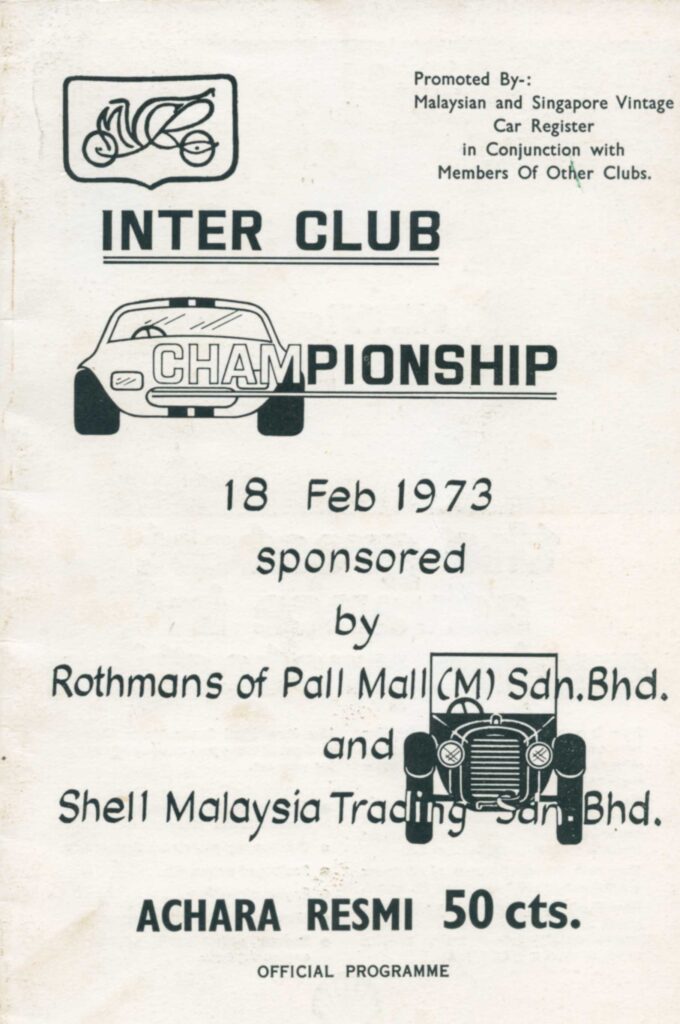
The first ever Inter Club Championship meeting in Malaysia was held on 18 February 1973. The idea for such an event came from the least likely of clubs. It had the hallmarks of Brian Tyler, vintagent and racer (he’s featured in the Rides of March series of articles on this website).
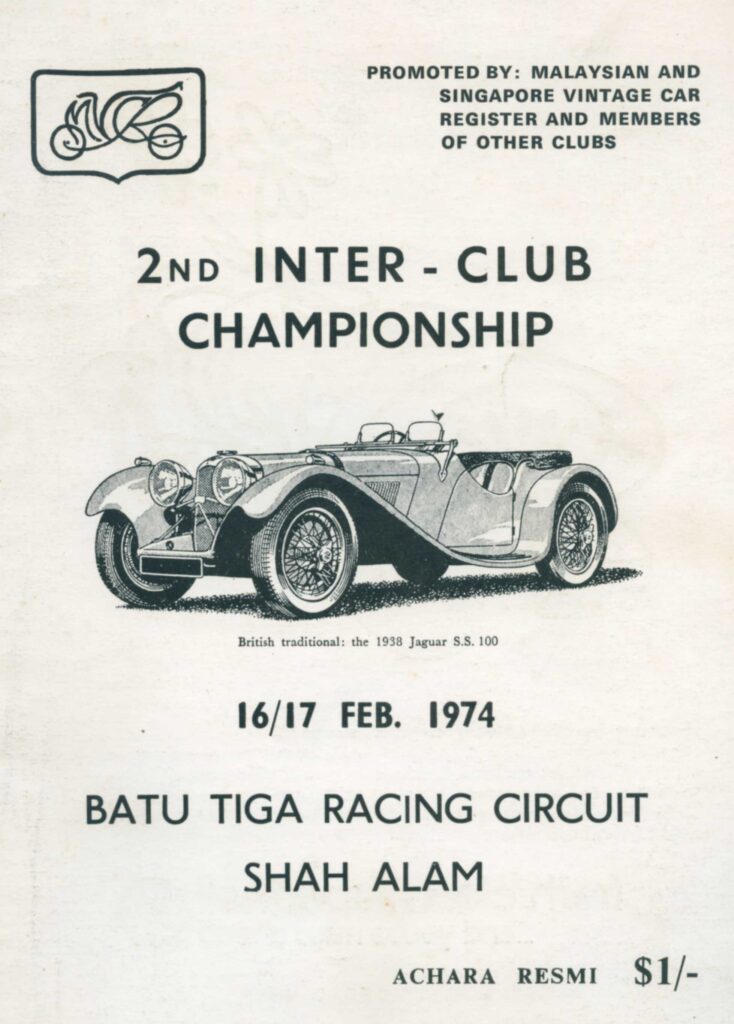
The second Inter-Club Championship was held on 16-17 February 1974.
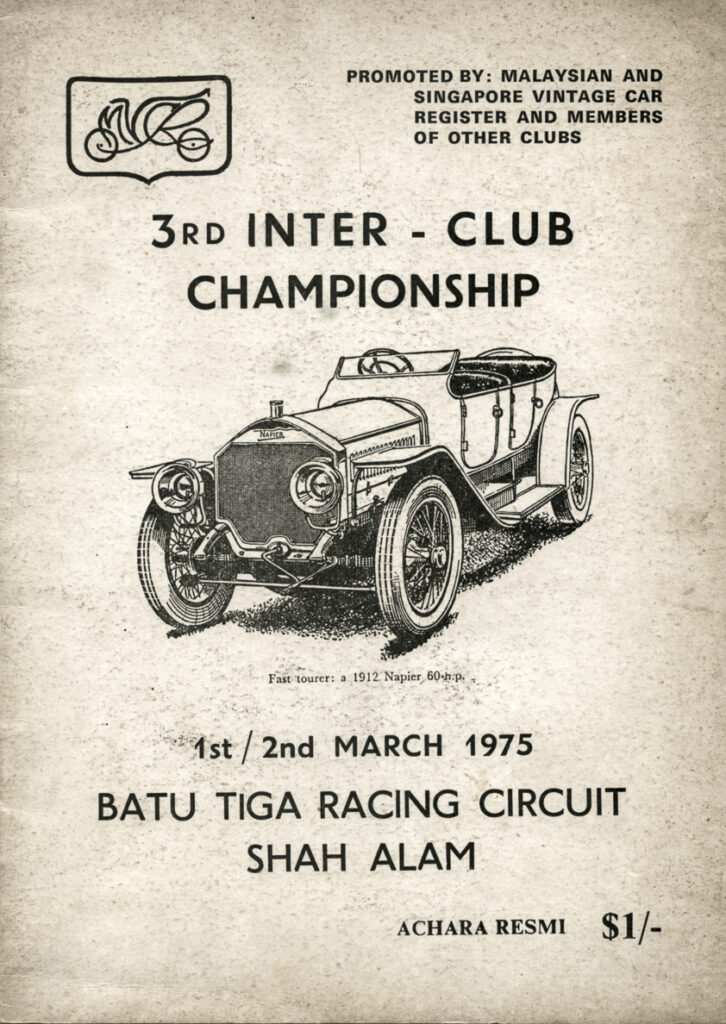
All the hallmarks of being a Brian Tyler-orchestrated event combining old and new at Batu Tiga. The MMSC provided all the equipment and personnel to run the event. Tyler, who was active with single-seaters as well as vintage cars, was MSVCR’s Vice President and Secretary and Secretary of this Meeting.
Perak Motor Club/Royal Perak Motor Club – 1953 to present
Representation from Perak at events in Malaysia proved that there was a strong following of enthusiasts sufficient to merit the formation of a club in the State. In March 1954, more than half the cars entered at Penang’s very popular Sungei Nibong Half Mile Sprint came from Perak. Strong Perak representation was replicated at the Sungei Nibong Kilo held at the end of May the same year. The need for a club in Perak was evident, suggestion for such a club having been made at the Perak Branch of the AAM’s meeting in April 1952, “on similar lines as those in Singapore and Selangor” and with the same objective, to leave the AAM to get on with improving its service and facilities. On Thursday 28th October 1954, the Perak Motor Club (PMC) was formed. The club held its first meeting at No.2 Osborne Street82, Ipoh.
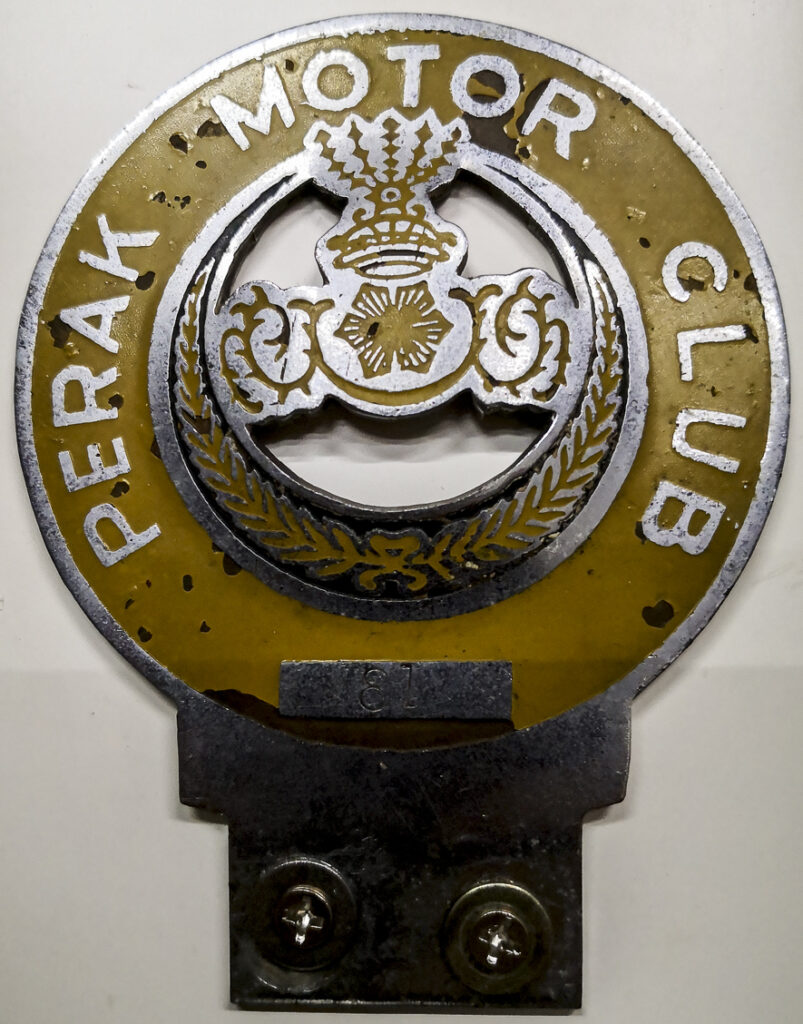
An early Perak Motor Club badge (1954-1959) after years of service on a badge bar of a car.
Its founding members in 1954 were Dr. Arnold Young, Chan Lai Hong, Lam Theng Pew, Geoffrey Emile ‘Jack’ Ashby83, Lawry, Yeoh Kean Hin, Peter Carey-Rees, William Giles Pillay, Rex G.G. Jansz and others. Ashby was already an active Perak Motor Club member from as early as 1936, often seen in his MG TA, road registered PK68. Dr Young and Chan Lai Hong were re-elected President and Vice-President for the 1955 season as well. The club had a pair of Club Captains – W.G.P. ‘Bill’ Davies and Charles Stratton-Brown.
Dr Young retained his position from 1954 until his retirement and departure from Malaya in June 1958, a period of five consecutive years. His position was taken over by Charles Stratton-Brown in April 1958.
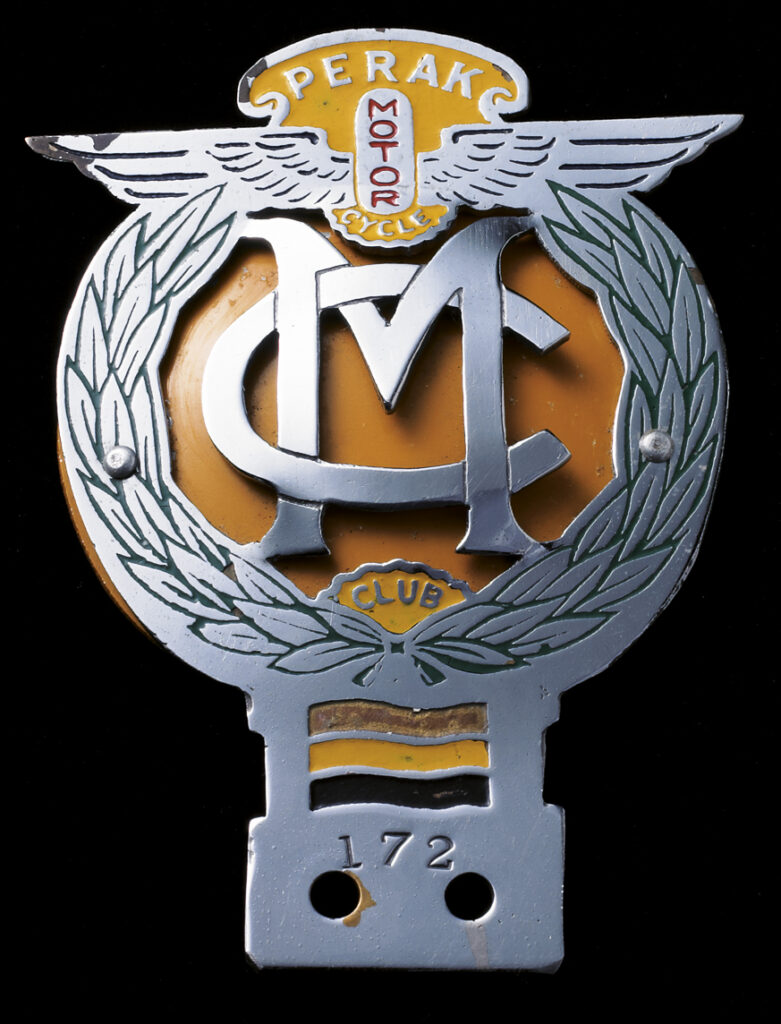
A rare badge from the Perak Motor Cycle Club, which was founded in 1947.
At the end of 1957, the Club had 306 paid members and the committee consisted of Dr Young as President; Dato Mohd. Ramly Abdullah – Vice-President; Hon. Secretary – Lam Theng Pew; Hon. Treasurer – Teoh Chye Hin; Club Captains – Bill Davies and Charles Stratton-Brown. The committee members were: E.J. Fowler; Yom Ahmad; William Giles Pillay and A.R. Bussens. The Ipoh Station Hotel provided Club-house facilities for members and meetings were held every Thursday night.
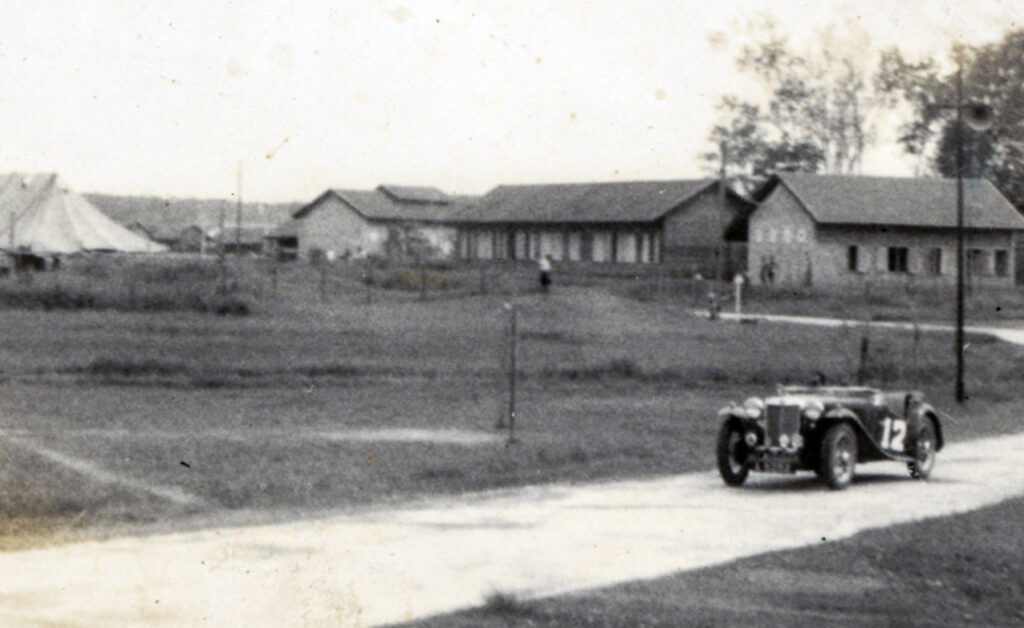
Ashby Road Speed Trial in the early 1950s. Events for cars were usually timed runs over a number of laps – five for racing cars, three for Sports Cars. The motorcycles were bunched in small groups for their races.
Prior the formation of this club, motor sports events were controlled by the AAM, as was the case with the 1950 Ashby Road Ipoh Speed Trial held on 12 March 1950. Secretary of the meeting was William Giles Pillay, also the Perak Motor Cycle Club’s Hon. Secretary (President was Taiping lawyer Ong Hock Thye). Chairman of the Organising Committee of the event was William Herbert Crampton ‘Bill’ Bailey84, who was Manager of Harper Gilfillan, Ipoh and later Chairman of the same.
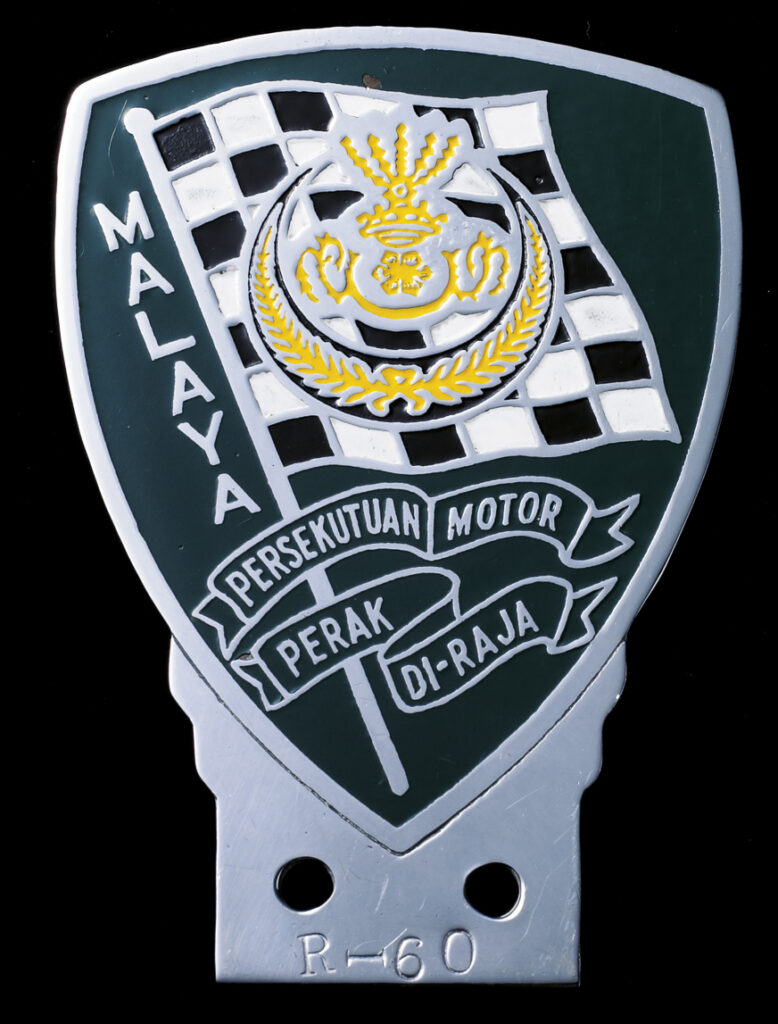
The Perak Motor Club was granted the Royal Charter by the Sultan of Perak on 17 October 1959 (an official presentation was made during the Sultan’s birthday celebrations on 15th January 1960), thus becoming the Royal Perak Motor Club.
By the end of 1957, the PMC had over 300 paid-up members and was one of the most active clubs with regular events held throughout the year. PMC was granted the Royal Charter by the Sultan of Perak on 17 October 1959 (an official presentation was made during the Sultan’s birthday celebrations on 15th January 1960), thus becoming the Royal Perak Motor Club. Its first President was David E. Atkins.
Penang & North Malaya Motor Club – 1953-1967
Formed in 1953, the Penang and North Malaya Motor Club, together with the Penang and Kedah branch of the Automobile Association of Malaysia, organised its first motor sport sprint at Sungei Nibong in May that year. A rally had been organised a month earlier.
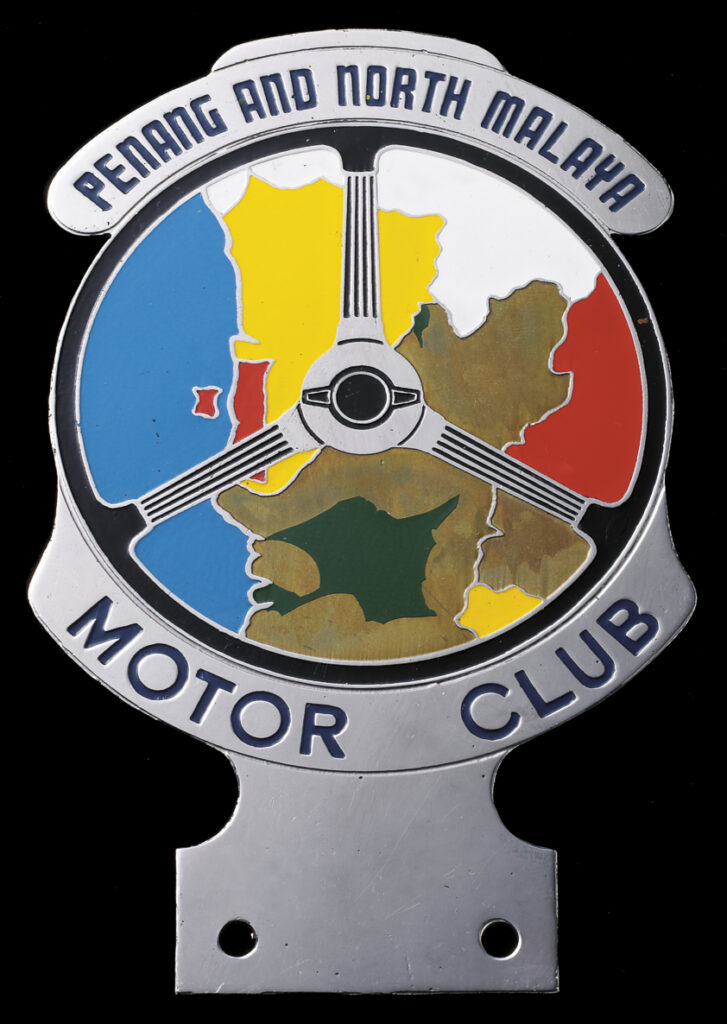
Grille badge of the Penang & North Malaya Motor Club.
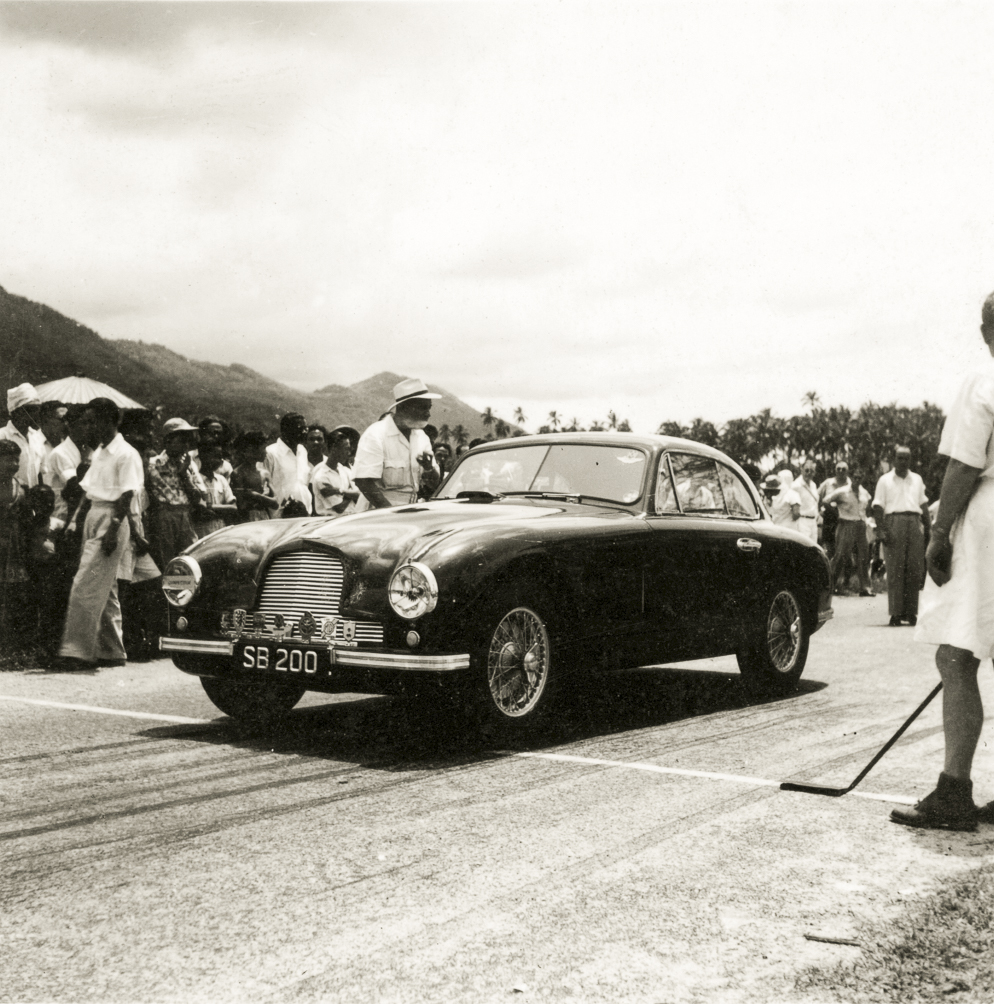
An Eastern Autos Singapore Aston Martin DB2-4 at the 24 May 1953 Sungei Nibong Kilo Sprint.
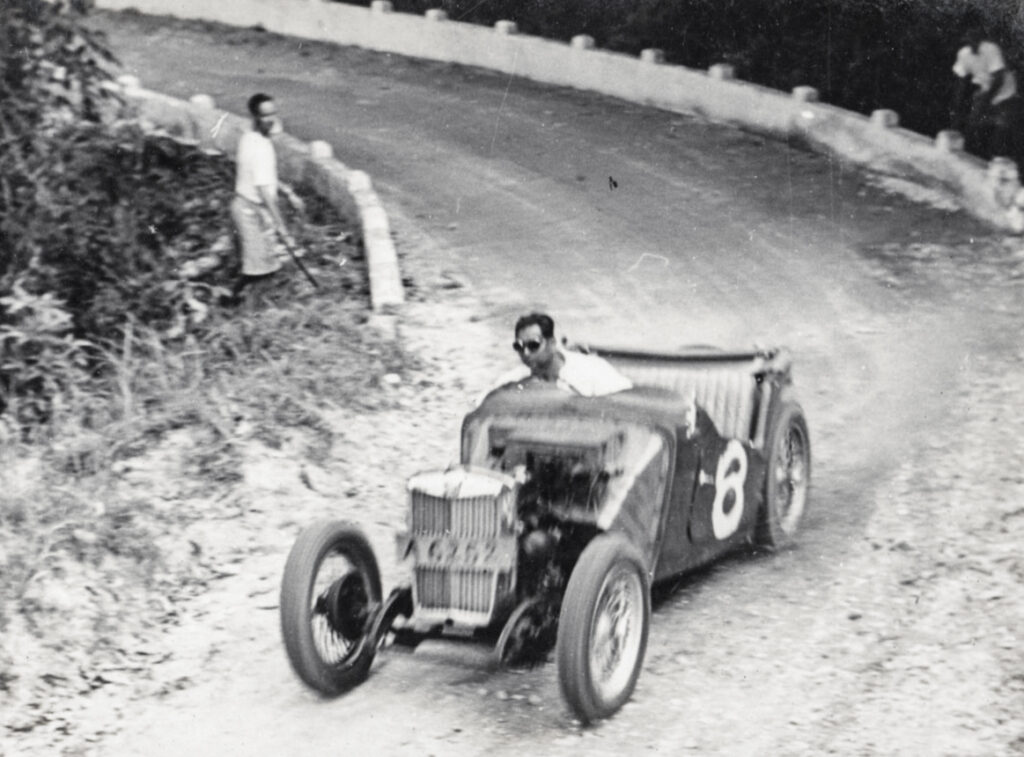
The Mount Pleasure Hill Climb was first run in October 1938 and organised by the Penang and Kedah Branch of the AAM as a 1/3 mile run. In April 1950 it was run as a hill climb and standing half-mile sprint. The photo shows Freddie Johns in his MG TC circa 1950.
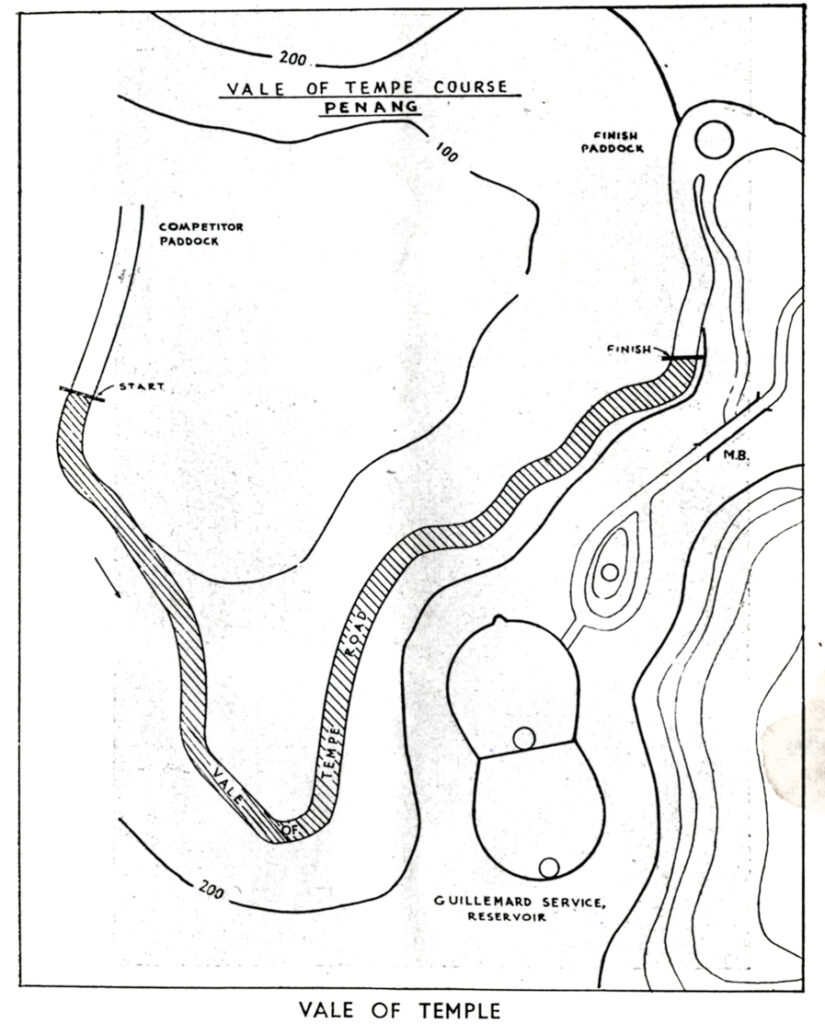
The Penang & North Malaya Motor Club’s Vale of Tempe hill climb was first held on 15 December 1957. The course was at Tanjong Bungah on Mount Erskine.
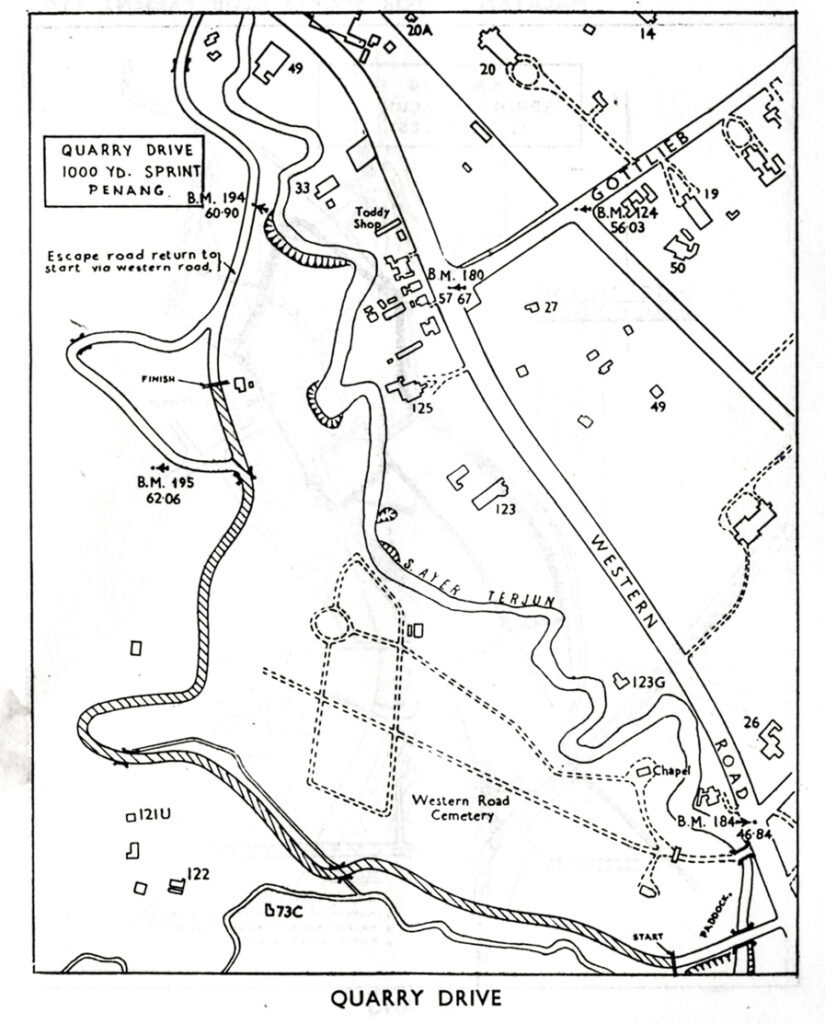
The Penang & North Malaya Motor Club’s Thousand Yards Quarry Drive Standing Start sprint was first run in 1949.
The Club would eventually go on to hold very popular sprints and hill climbs at Sungei Nibong, Mount Pleasure, the Vale of Temple, Quarry Drive and other locations in north Malaysia. The Club continued to exist until 1967 whereupon the Penang Motor Sports Club was established to spearhead several new motor sports initiatives.
Penang Motor Sports Club – 1967-present
In April 1968, the Penang Government initiated a plan to construct a permanent race circuit on Penang Island. Then Chief Minister Tan Sri Wong Pow Nee’s objective was to boost Penang as a tourist destination in Malaysia.
By early 1970, a location had apparently been found, but the idea of an expensive permanent circuit was dropped in favour of a street race around the historic city instead.
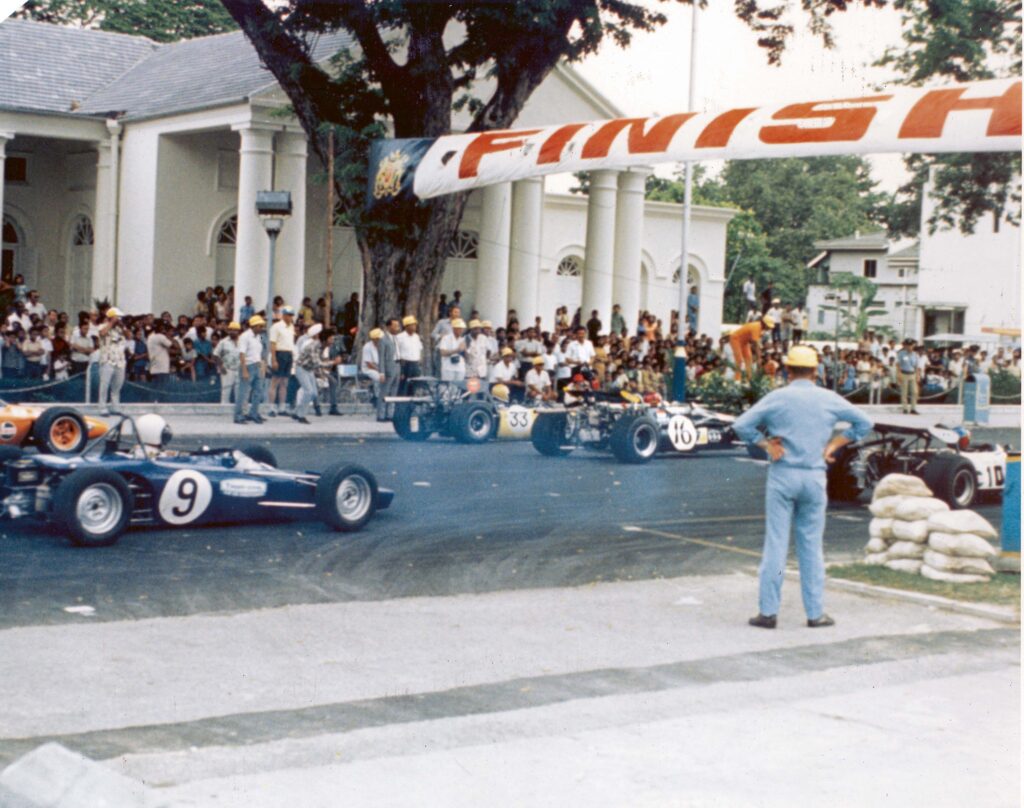
The Second Penang Circuit Races was held in May 1971 and featured Formula Ford entries in the main race for open wheelers.
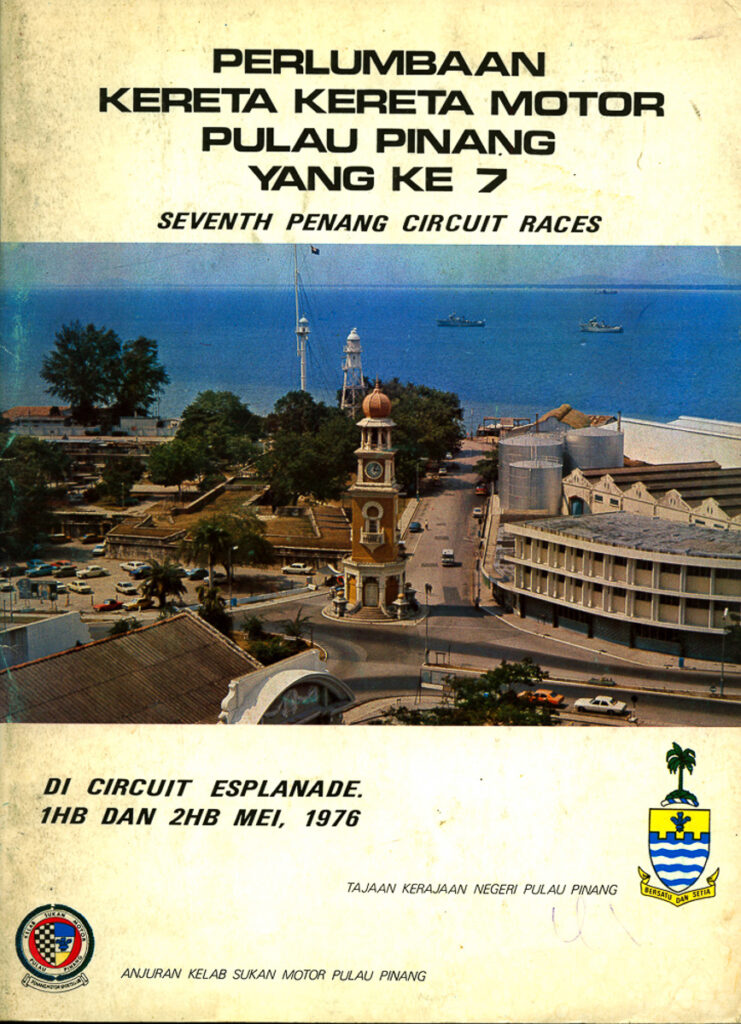
The Penang Circuit Races were organised by the Penang Motor Sports Club.
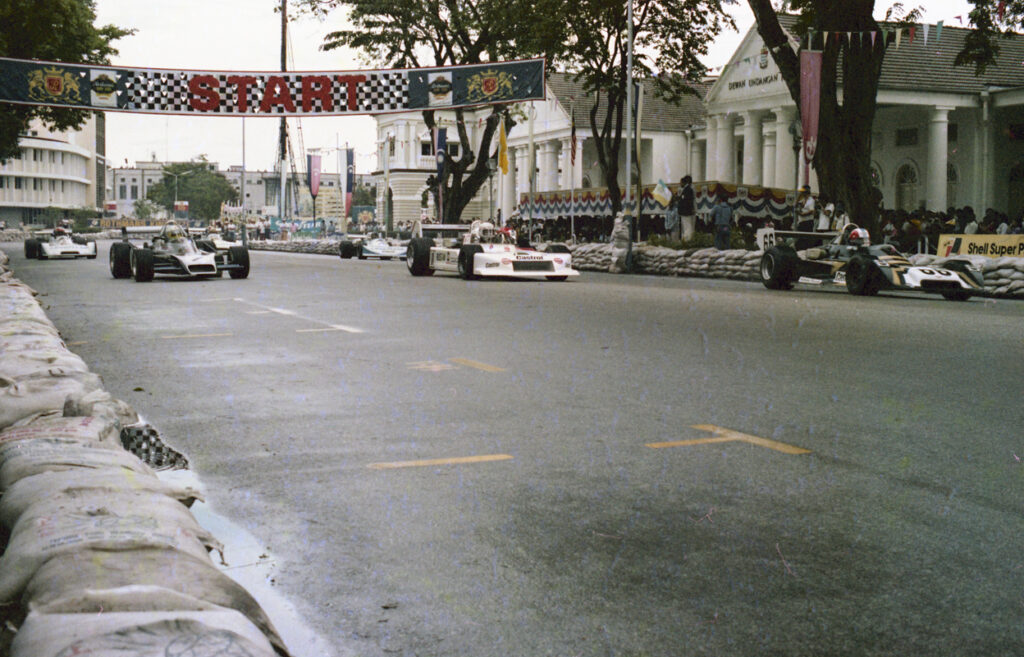
Racing on the Esplanade – the Penang Circuit Races and Grand Prix outlasted the Singapore Grand Prix and witnessed the revolutionary changes in motor racing – from single-seaters with no aero aids through to the era of ground effects.
The Penang Motor Sports Club, also known in Malaya as Kelab Sukan Motor Pulau Pinang, organised its first circuit race at the Esplanade Circuit in January 1970. After hosting the “Penang Circuit Races” for eight years, the Club obtained FIA approval in 1978 to have the event recognised as a Grand Prix (it was referred to earlier as the Penang Circuit Races). [see GRILLED SIRLOIN, KING PRAWNS &…SANDBAGS – History of the Penang Grand Prix]
The Incorporated Society of Planters Car Club
The ISPC was a pan-Malayan club with membership restricted to those already members of the Incorporate Society of Planters. In 1957 the club had about 100 members throughout Malaya. An annual dance and concours d’Elegance and rallies were what the club generally organised. The Society’s monthly magazine, The Planter, generally ran a motoring article in each of its edition.
Motor Sports Club of Hong Kong – 1952 onwards
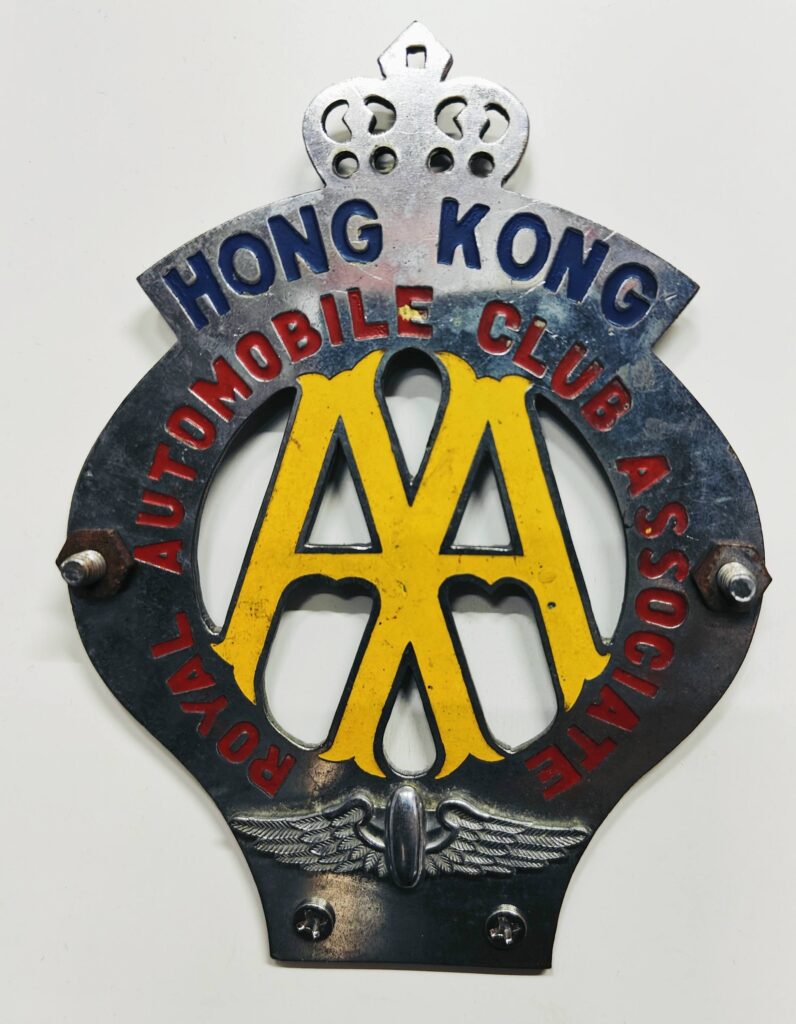
One can date Hong Kong’s sporting side of motoring to 1950 when Paul E. Du Toit was entrusted with the responsibility of catering for the more sporting-minded members of the Hongkong Automobile Association.
A rally was organised by Du Toit, the first of a series of events through to 1952. A proposal for a hill climb was rejected that year and Du Toit’s role diminished. The idea then sprang up for a Motor Sports Club, independent of the Hongkong Automobile Association.
On 29 May 1952 a meeting at the YMCA on Salisbury Road in Kowloon the Motor Sports Club of Hongkong was formed. Du Toit was its first Hon. Secretary. Membership at its second meeting in June that year stood at 25.
Hong Kong was now on its way to having its first Club-organised hill Climb and Golden Hill in the New Territories was chosen as the most appropriate location for the Club’s first Practice Meeting on 20 September 1952. The Club’s first official Hill Climb on 23 November 1952, Dr Hervey T.B. Oei set fastest time in his modified Jaguar XK120 which the ubiquitous Teddy Yip later acquired and raced in the Macau Grand Prix.
During that first year of MSCHK’s existence, the club organised three Hill Climbs, two rallies, three treasure hunts, one Regularity Run, one dinner dance and seven social evenings and film shows. New venues soon appeared for hill climbs, sprints and gymkhanas with sites at Sha Tin Airstrip, Sek Kong Airstrip, Jubilee Hill in the New Territories and Wong Nei Chong Gap on Hong Kong Island.
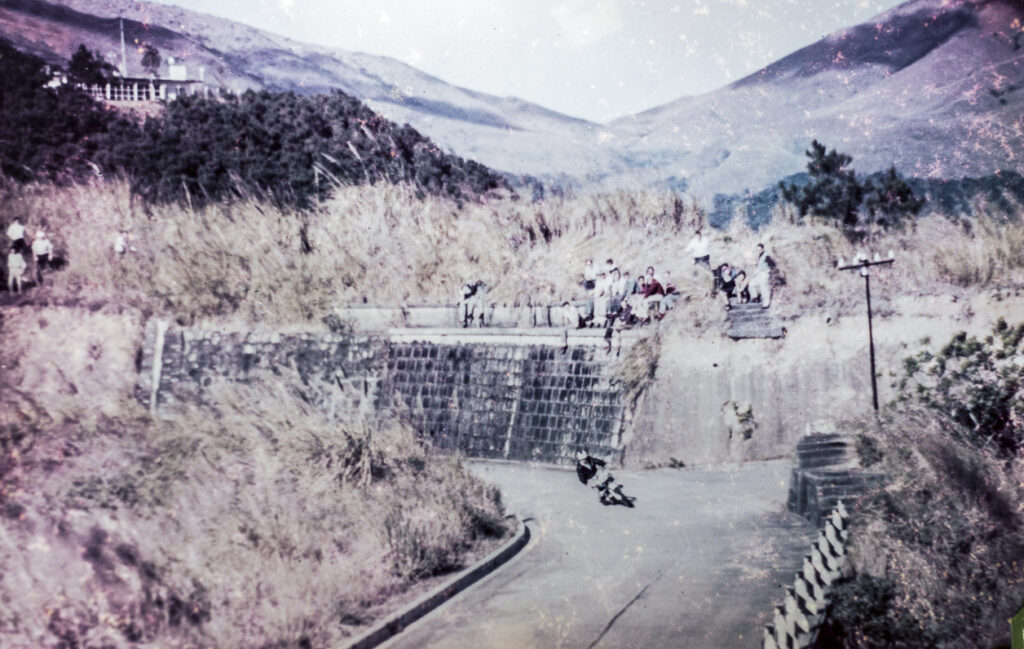
The Jubilee Reservoir Hill Climb in 1960. The event often attracted over 70 competitors. King of motorcycles in the late 1950s and early 1960s was usually Brian Eastman on his Triumph (pictured).
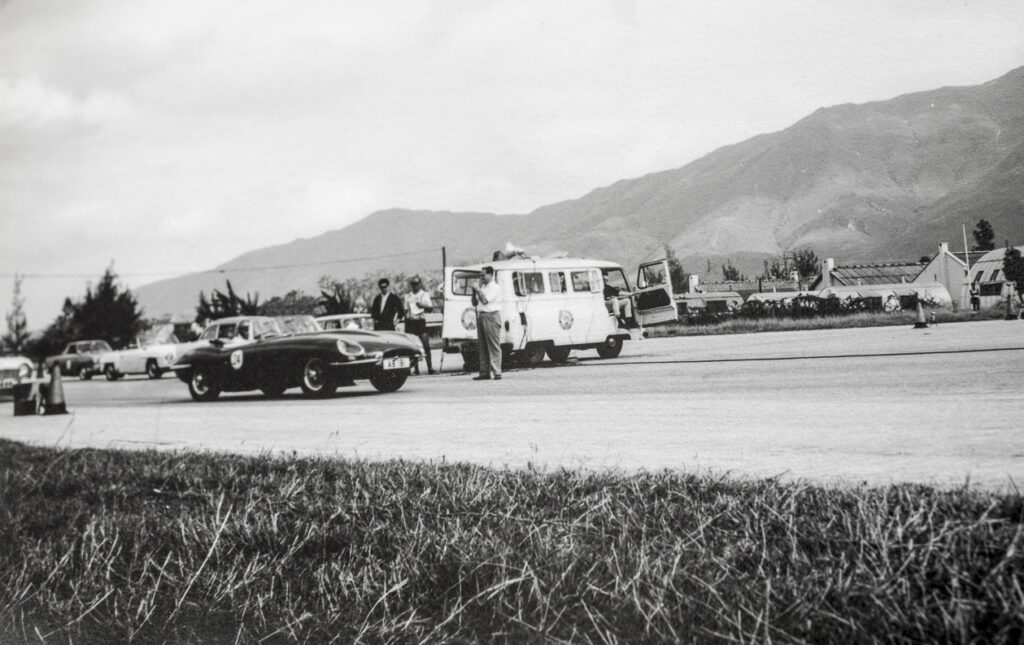
One of the more popular MSCHK events was the Sek Kong Airstrip Sprint of the late 1950s and early 1960s.
When Macau hosted the first Macau Grand Prix in late October 1954, it was entirely due to the efforts of the MSCHK and indeed to Du Toit, the motor sports enthusiast Hong Kong and Macau owes so much to. This gentleman had been quietly negotiating with the Macau authorities and revealed the good news to members of the MSCHK at one of the club’s get-togethers in July 1954.
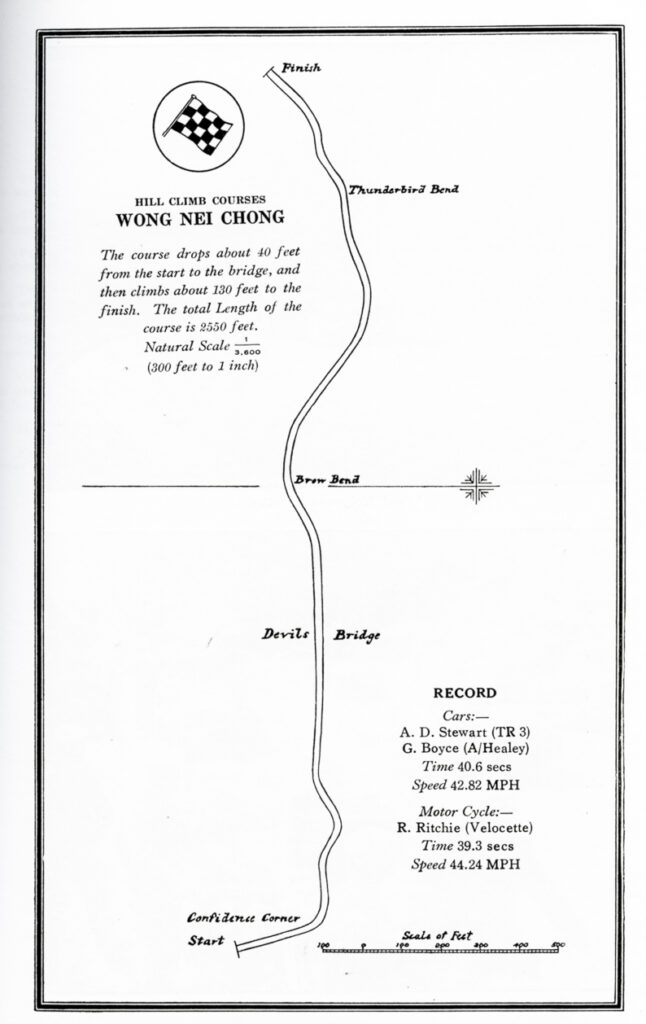
The popular Wong Nei Chong Hill Climb on Hong Kong Island was first run in 1953.
Du Toit himself participated in that first Grand Prix and finished second in a Triumph TR2. The winner was Far East Motors’ Eduard Carvalho, in a TR2 as well. In fact, the first three cars were Triumph TR2s!
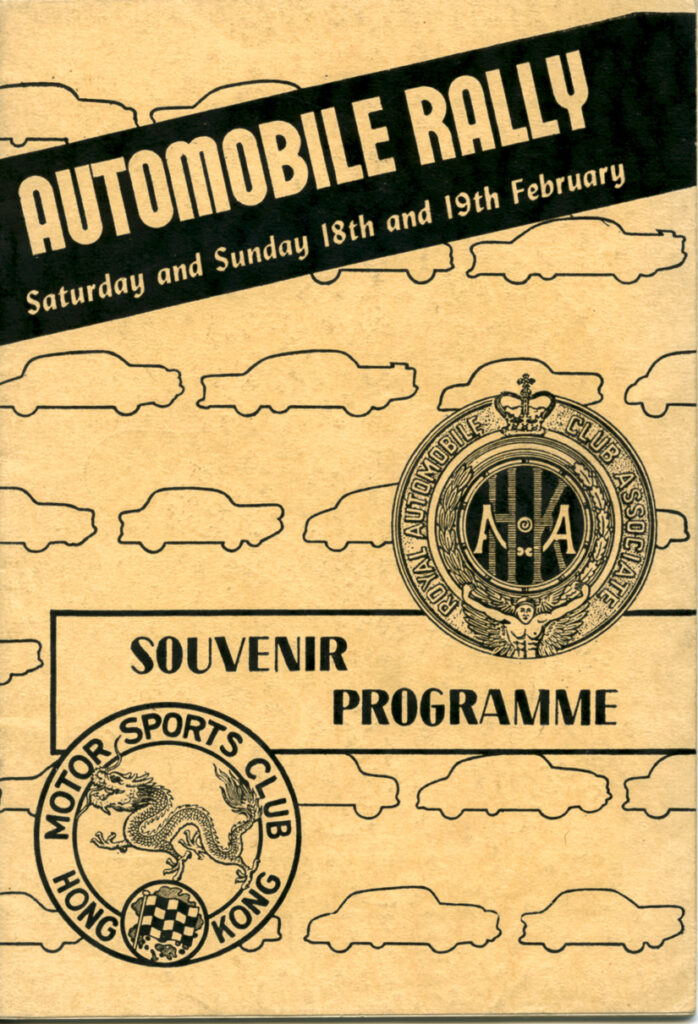
The 7th Annual Motor Rally was a Hong Kong Automobile Association event in conjunction with the Motor Sports Club of Hong Kong. Events over the two days in 1956 included a Reliability Trial in Kowloon; a driving and braking test at Salisbury Road; a motor show at Government Stadium (now Kong Kong Stadium) in Sookunpoo (So Kon Po); Elimination Tests at the Northern end of the Stadium; Concours d’Elegance at the West side of the Stadium.
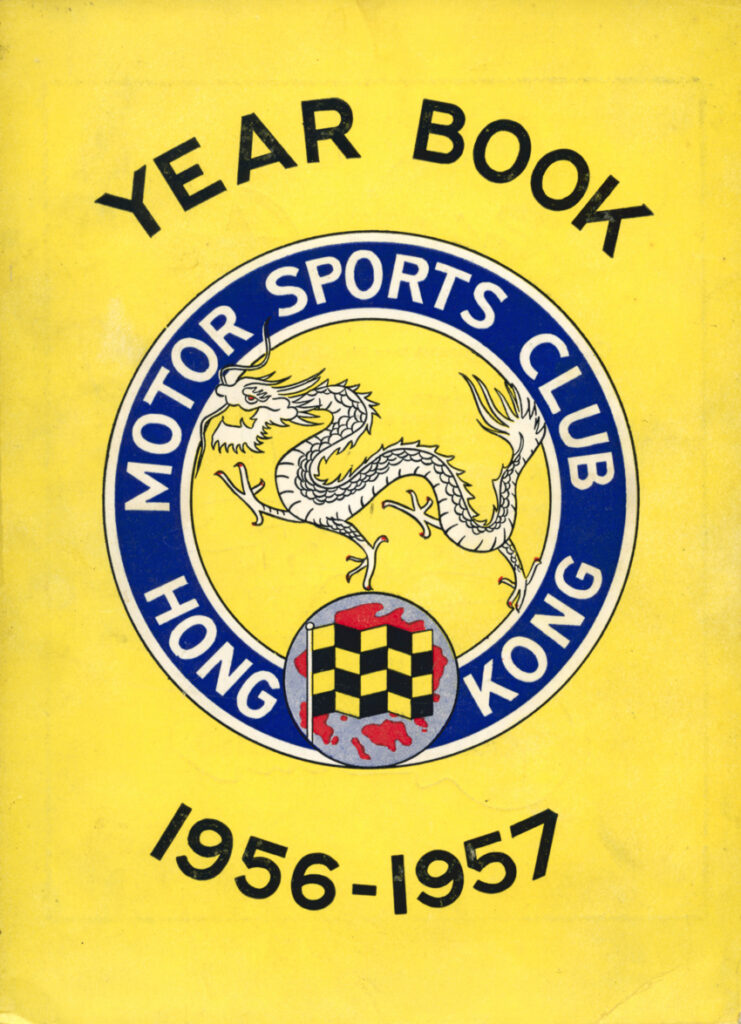
The Motor Sports Club of Hong Kong’s Year Books from 1956 set an unmatched standard for the Far East and South East Asia.
Other Car Clubs in Peninsular Malaysia formed in the 1950s and 1960s
Gear Box Club, Selangor (formed in 1953)
R.A.F. Seletar Auto Club (formed September 1960)
Brunei State Motor Club
Royal Brunei Motor Club
Triumph Owners’ Club, Perak
Triumph Herald Owners’ Club, Perak (formed 17 September 1961)
Perak Lambretta Club (formed 14 December 1959)
British Army Motoring Association (Malaya Area)
Miri District Motor Club (formed February 1962)
R.A.A.F. Butterworth Motor Club (formed January 1962)
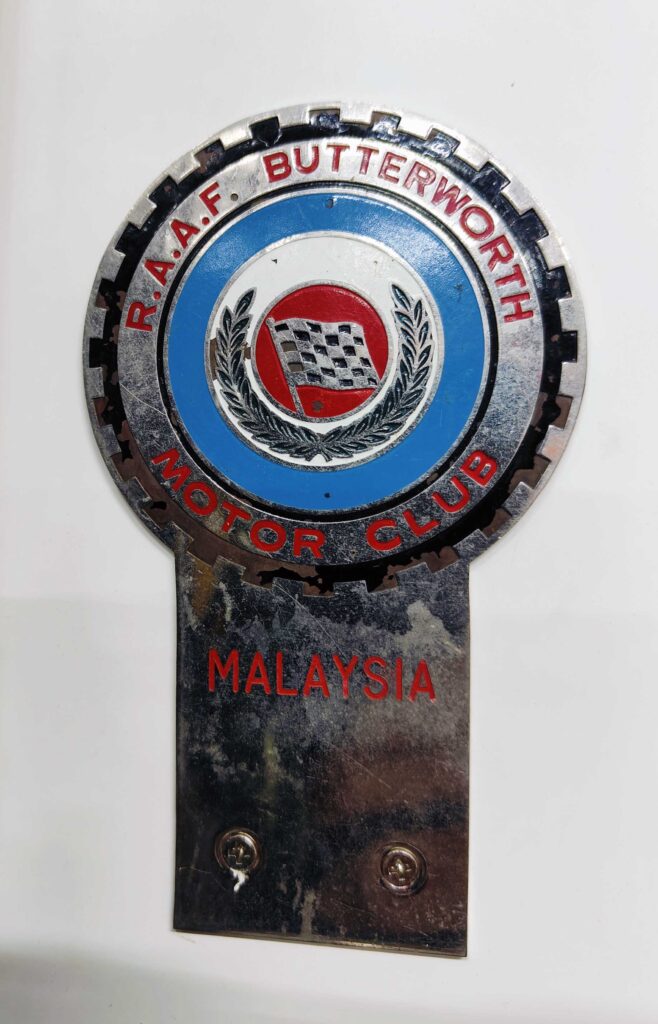
R.A.A.F. Butterworth Motor Club (formed January 1962)
Sabah Motor Club, North Borneo
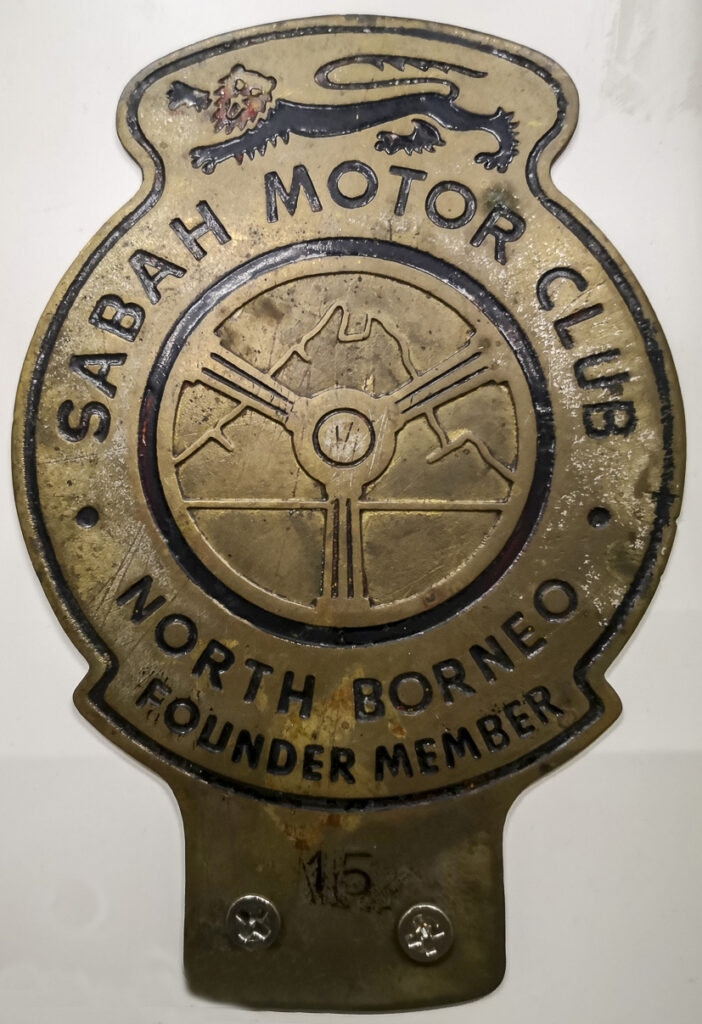
Sabah Motor Club, North Borneo
DECLINE OF THE CLUBS
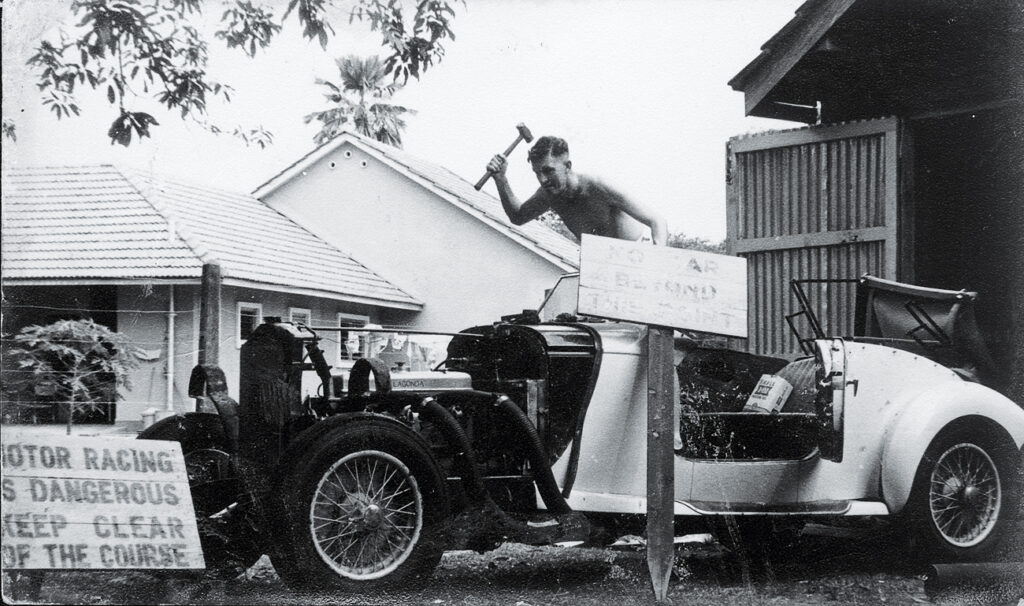
Dr Arnold Young, founder member of the Perak Motor Club, appears determined to destroy his Lagonda LG45 Rapide outside his garage and home in Gopeng, Perak. Young used this photograph for his annual Christmas card!
What contributed to the decline of these clubs over time? A simplistic view is that motor sports in Malaysia and Singapore was dominated by the expatriate until the 1970s. These expatriates usually consisted of plantation managers, British and Commonwealth army officers and long serving civil servants.
The British military pull out in the early 1970s removed one of the pillars of the local motor sports clubs. Another factor was the “Malayanization” and “Singaporeanization” in Malaysia and Singapore respectively throughout the 1960s and 1970s that effectively positioned locals in government, the civil service and local industry. Added to this, the acquisition of plantations and businesses by local consortiums, often backed by the local government agencies, reduced dependence on foreign talent.
During the period, it was certainly too expensive for most locals to participate or compete in motoring events against their expatriate counterparts in the region. The corollary of this however was that it enhanced the skillset of the local fabrication and engineering industry. The development of the locally built Specials before and after the war by local fabricators and engineers attests to this.
Motor sports was never considered part of local popular culture, hence its exclusion from mainstream museum and heritage exhibitions. In fact, it has always been viewed locally as an elitist sport.
As an almost British institution, most of the expatriates living here were familiar with motor club events such as sprints, trials, hill climbs and circuit racing in the UK and Europe. They wanted to bring some of their interests to the “colonies” which they perceived as a hardship posting. They provided the critical pool of able organisers and keen participants for the motoring events – people such as Freddie Pope, first President of the Singapore Motor Club, and his counterparts in Malaysia: Mike Evans, Tony Maw, Desmond Gustavus and Trevor Butcher; Municipal Architect, Mick Jennings; and die-hard enthusiasts such as Neil Moncrieff. Many built their own Specials and competed enthusiastically in them [see MONSTERS & MAVERICKS – Part2].
One could surmise that the turning point came after the formation of the Batu Tiga permanent circuit and the formalisation of matters pertaining to the organisation and running of races. No longer was it a haphazard process of stitching together a group of people from ministries and volunteers from the car clubs to run the show (as was the case in Singapore).
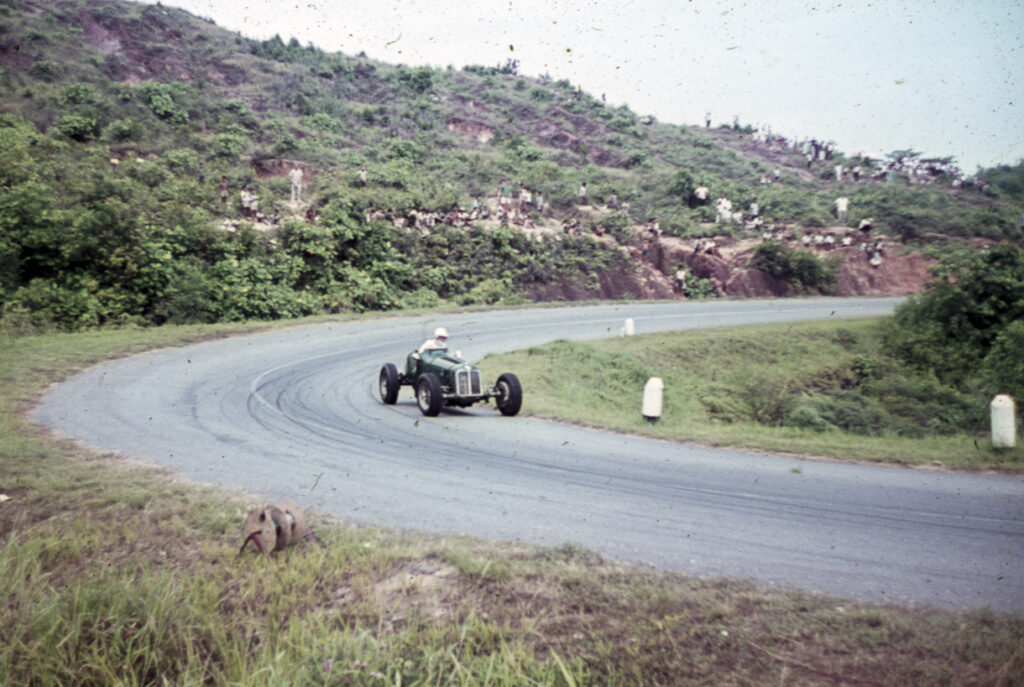
Barry Swann and his ERA R2A tackle the hairpin bend up the Gap in Singapore. The Gap Hill Climb was arguably the most popular motor club event in Singapore between 1927 and September 1973.
Urbanisation of towns and the countryside eventually meant that venues for road races and hill climbs soon disappeared, and organising events was no long a simple matter of calling the local Police Inspector and requesting road closure for a day.
CLUBBED TO DEATH
While a permanent race circuit served the needs of the sport, it reduced the role of car clubs as the sport now became confined to these new purpose-built venues [see RACING IN THE FEDERAL CAPITAL]. No longer was hosting a motor sport event on public roads and private plantations feasible, nor was it easy to obtain government approval to hold such events (this was certainly the case in Singapore).
Motoring clubs may have lost their prominence over time but they have clearly laid the foundation for a local motor sports culture in Malaysia. While dominated by expatriates in the early days, the club scene had the desirable effect of encouraging local participation as well. Dedicated local enthusiasts – drivers and officials – such as Singapore’s Lim Peng Han and Francis Baruch, and Malaysians such as Saw Kim Thiat, Harvey Yap, Bulldog Kwan and Jeff Amin, all continued racing and playing critical roles in local motor sports, long after the departure of Pope, Lockerbie, Jennings, Green85, Gustavus and Butcher.
Words By Eli Solomon
You can reach the writer @ [email protected]
BIBLIOGRAPHY
Tice, Mike. Swings and Roundabouts. Square One Publications, 1991.
Stonor, Henry & Tyler, Brian. Vintage Motoring in Malaya. Privately published July 1977.
Moffatt, Jonathan & Riches, Paul. In Oriente Primus – A History of the Volunteer Forces in Malaya & Singapore. Jonathan Moffatt & Paul Riches (2010).
Gibbs Pancheri, Paul. Volunteer! – The story of one Man’s War in the East. Paul Gibbs Pancheri (1995).
Särnesjö , Jan. The World of Car Badges – The Complete Reference Guide to the Royal and National Motoring Associations of the World. Darwin Books (2003).
Särnesjö , Jan. British Car Badges – The Complete Guide to the AA and RAC, their Affiliates and Competitors. Darwin Books (2009).
Yap, Jimmy. Motoring Beyond 100 – Celebrating 100 Years of The Automobile Association of Singapore. Automobile Association of Singapore (2007).
Setright, L.J.K. Drive On! A Social History of the Motor Car. Granta, 2003.
USEFUL LINKS REFERRED TO IN THE ARTICLE
JOHORE GRAND PRIX – PART 2: 1960-1963
JOHORE GRAND PRIX – Part 1: 1949-1953
GRILLED SIRLOIN, KING PRAWNS &…SANDBAGS – History of the Penang Grand Prix
THE GHOST OF MALCOLM ROAD – the L.A. Ghost
MICKEY BOY’S BADGE – The Selangor Motor Sports Club
JOY BY DESIGN – The Singapore Motor Club
THE REAL CAPTAIN MG – C.O. Jennings and his MG K3 in pre-war Malaya
THE FORD NESCAFÉ ESCORTS: Debunking The Myths for Nestlé’s involvement in the sport
SMOKE GETS IN YOUR EYES – Rothmans and motor sports in Malaysia
LANDING AT CHANGI – The 1957 R.A.F. Changi Circuit Race
SIXTY YEARS AGO – THE ORIENT YEAR GRAND PRIX
FROM A FEDERAL STORE – the story of Cycle & Carriage
Footnotes
- Setright, L.J.K. Drive On! A Social History of the Motor Car. Granta, 2003.
- Straits Times, 23 September 1903, pg.5. F.M.S. News noted that there were about 18 members of the F.M.S. Automobile Club [Source: Malay Mail]
- The Motor-Car In Singapore, A Chat with Mr. G. Kester, managing partner of the Federal Automobile Mail Service of the Federated Malay States. Straits Times, 2 May 1905, pg 8.
- The word “petrol” was first used in reference to the refined substance in 1892 and was registered as a trade name by British wholesaler Carless, Capel & Leonard. In America the term “Gasoline” is more commonly used.
- The Straits Dollar was pegged at two shillings four pence from 1906 until it was replaced (at par) by the Malayan dollar in 1939.
- The Straits Times, 27 August 1903, pg.4
- Formed on Friday 21 March 1907, the idea was for the club to represent the Federated Malay States with the head executive in Singapore. Proposed names for the club included the Malayan Automobile Club and Straits and F.M.S. Automobile Club.
- Sir John Anderson [b. 23 June 1858 – d. 24 March 1918] was Governor of the Straits Settlements (appointed in 1904). He served at the Governor of the Straits Settlements till 1911. He later served as Governor of Ceylon.
- The first official meet of the new Singapore Automobile Club took place on Sunday 16 June 1907. The event commenced in the morning outside the Singapore Club with a photo shoot, the cars facing Collyer Quay.
- Tampenis Road, now official recognised as Tampines Road, was named after the rare tĕmpinis hardwood tree (or Ikan tĕmpinis, a fish?) . The durable wood (which was often referred to as iron-wood) from the tree was used as timber in the early colonial history of Singapore. Tampenis Road (renamed Tampines Road circa early 1939), was once a mere path that had been widened to allow for bullock cart traffic by August 1865. See R.J. Wilkinson’s (1867-1941) A MALAY-ENGLISH Dictionary. Part 1 & 2, Daitoa Syuppan Kabusiki Kaisya, Tokyo (1943). tĕmpinis (Johore Malay): Riau ironwood, Sloetia sideroxylon; a lofty tree yielding a dark –red wood of proverbial durability. Also Ikan tĕmpinis: a fish (unid.) – see H. von Dewall (Malay-Dutch Dictionary), ed. H.N. ban der Tuuk, 1877.
- John Henry Matthews Robson (b. 8 May 1870 – d. 1945). He was the eldest son of the Rev. Dr. Robson of Guildford, Surrey. Robson first arrived in Kuala Lumpur in 1889 and for the next half century worked as a government official, a journalist (with the Selangor Journal – a paper started by John Russell and operated between 1892 and 1897) and a newspaper editor. A prominent figure in public affairs in Selangor. Robson was later on responsible for establishing The Malay Mail in 1896 (first issue of the Malay Mail appeared on 14th December 1896). Robson was also one of the first few people to own a car in Malaya in 1902, a de Dion Bouton. Note: There is a photo of Robson in his de Dion Bouton in https://eresources.nlb.gov.sg/newspapers/Digitised/Article/stannual19060101-1.2.93 ST=1&AT=search&k=Kester%20automobile&QT=kester,automobile&oref=article The SAA held its first annual meeting in May 1923 11 The Association started with 21 members and as of that first meeting had 166 members. Source: Straits Times Friday 25th May 1923
- Delegates of the various motoring associations in Malaya actually met in Kuala Lumpur on 26 January 1926 to consider the formation of a Malayan Motor Association (Straits Times 21 February 1929, pg.2).
- Rex Duncan was born in Edinburgh, Scotland. He arrived in Malaya as a planter in 1926. It was noted that he was engaged in the motor trade at an early age for about 10 years before coming to Malaya as a planter. It was also reported that he entered in the 1928 Junior TT Race Isle of Man though this author is unable to find an entry for R. Duncan. He was however, entered in the 1931 event in the Lightweight TT race in an Excelsior where he finished 13th with a time of 4.23.33.0 (Speed 59.02mph), the last of the finishers in that event. During his time in Malaya he was President of the Selangor Motor-Cycling Club, a club that had been in existence by November 1928 and already playing motorcycle football twice a week in Kuala Lumpur!
- Arnold Savage-Bailey [b. 28 February 1881 d. 1 April 1935, age 54]. He was head of the firm of Bannon and Bailey [founded by R. B. Bannon and Arnold Savage Bailey in 1920s and dissolved in 1963], Kuala Lumpur. His wife was Kate Edith Savage-Bailey, Librarian of Raffles Library, Singapore. She perished [28.2.42] when the SS Rooseboom was torpedoed by a Japanese submarine [I-159]
- Ibid.
- James Arthur McEvoy [d – 13.12 1964] came to Malaya circa 1920s. Was married by 1930. Wife was Gladys. They had a daughter in Penang on 3 August 1930. McEvoy was on the Committee of the Penang and Kedah Branch of the AAM at the AAM’s meeting held at the offices of the Secretaries of the Selangor AAM at the end of February 1932. He and Gladys had a son on 19 May 1932, in Penang. He became the Registrar of Vehicles 1 July 1932. Prior to that McEvoy was with the Straits Java Trading Company. He also became the Secretary of the Penang and Kedah Branch of the AAM. Penang. During the war, McEvoy was a Captain A [Depot] Company, 3SSVF and was a POW in Changi.
- Paul J. Dinsmore Regester [d. 1998] was Colonel and Chief Staff Officer to the D.C.C.A.O. (Deputy Chief Civil Affairs Officer) Brigadier P.A.B. McKerron during the British Military Administration of Singapore in 1945-46. When McKerron took over as Colonial Secretary and Officer Administering the Singapore Government in April 1946, Regester was Acting Colonial Secretary. In October 1931 he was already practicing as a lawyer in Penang and was elected a non-resident Fellow of the Royal Empire Society. 1932 – was Assistant to the Attorney-General, Penang and Secretary to the Penang Bar Committee (temporary). He was on the committee of the Penang and Kedah Branch of the AAM in 1934 while James Arthur McEvoy was Chairman. In May 1938 Regester was granted a Commission in the SS Volunteer Force, rank Second-Lieutenant. Following his role as Acting Colonial Secretary, he entered the corporate world in Malaya. He continued to practice as a lawyer, working for Drew and Napier in Kuala Lumpur. He was on the boards of several corporations, and was Chairman of Malayan Cables Ltd. In 1959.
- Malaya Tribune, 19 January 1933, pg.4
- The first Annual Report of the AAM stated 1,920 members, an increase of 670 over the preceding year (1932).
- A detailed history of the AAM from 1932 through to 1938 had been withheld from this online version although there were numerous events in Malaya – from reliability events (Kepala Batas to Sungai Patani in March 1936, for example) to hill climbs (Kuala Kubu-Fraser’s Hill in March 1936, for example)
- Lawrence van der Straaten [b.1902, Kuala Lumpur d. 29 September 1978, Mount Lawley, WA]. Wearne Motors, Robertson Road, Kuala Lumpur. Sgt 6920 45 Reserve MT Company FMSVF POW Singapore to Thailand with F Force 28.4.43, returning to Singapore December 1943. Lawrence was repatriated to the UK aboard Monowai. Returned to Malaya from the UK 1946. Later to Peth WA.
- The Singapore Branch of the AAM organised the Farrer Road Speed Trial The Farrer Road Sprint was a standing-start Half-Mile sprint that took place on Sunday 25 September 1938. The start line was a short distance beyond the bridge at the Bukit Timah end of Farrer Road. This was Singapore’s first speed trial and naturally attracted a great deal of interest. C.O. Jennings (in his supercharged MG PB – See THE REAL CAPTAIN MG) and Lim Peng Han were back in action but now the selection of cars included Singapore contractor Wong Chek Quee’s 2½-litre SS100 and another Special, E.H. ‘Ted’ Holloway’s Holloway Special, based on a Riley with Fiat chassis, Fiat front and rear axles, Ford V8 motor, four carburettors, Chevrolet brake cables, Bugatti wings, SS Jaguar steering wheel, and a home-made body. Even by Specials standards, this one was just too complicated to understand but it did take the fight to Lim’s #119, though it appears that Lim’s bored-out and reputedly supercharged (Graham) Mercury V8 L.A. Number 1 set FTD at 29.6 sec. The Singapore Trophy, presented by Mr and Mrs Eric Williams, was Lim’s to keep. Lim might have been newlywed but his 20-year old wife Irene (Lim Peng Han’s first wife was Tan Biow Luan (or Biau Lan), born 2 August 1918.) attracted all the wrong attention when she crashed a Ford V-8 saloon lent to her by Eastern Autos’ Chan Lye Choon (it was a customer car) and had to clamber out of the roof of her car and walk to the ambulance unaided after it landed in a ditch. Her co-driver was Lye Choon’s elder brother Lye Huat. Lim Peng Han had to make good on the damages sustained in the crash. It was a close call and a stark reminder of the perils of the sport and the fragility of life.
- Sir Ewen MacGregor Field Fergusson [b. 16 October 1897 d. 24 October 1974, age 77] Straits Trading Co., was also Legislative Council member before the war. In 1946 he was Chairman of the Singapore Chamber of Commerce. He became Chairman and Managing Director of Straits Trading Company and was awarded a K.B. in 1953.
- Percival Walter Frederick Mills [b. 30 December 1899 d. 11 May 1975 in Dore, Sheffield] WW1 Service with RN Air Service 1917-18. Royal Insurance Company 1918-23 then to China 1923-6. Ocean Accident and Guarantee Corporation, Amber Buildings, Malacca St. Singapore 1926 till he left Singapore. Mills was Hon. Secretary of the Singapore Automobile Club in 1927 and later a committee member of the Singapore Branch of the AAM (until 1939/1940). He was author of Angles on Practical Flying (1932) and Elements of Practical Flying – A Detailed Survey For Students And Air Pilots (1935).
- Cecil Prosper Liston, fourth son of Dr Liston of Penang. Cecil first came to Penang in 1919, for Sandilands Buttery & Co. In 1925 he went to Sumatra as the firm’s branch manager in Medan. In 1928 he joined Anglo-Bendixsen & Co. and became inspector of branches of the amalgamated firm of Anglo-French & Bendixens. In 1939 he opened the rubber department of G.H. Slot & Co. in Singapore. During the war he was in India as Rubber Purchase Officer to the Government of India. He returned to Malaya post war as a member of the Rubber Buying Unit. Bought over the tyre (reconditioning) business The House of Tyresoles at 91, Patani Road, Penang in June 1950. Prosper Liston listed as Secretary to Penang AAM post-war.
- John Samuel Radford – Air Ministry Directorate of Works, Singapore. Died in the Wearne’sAir Services plane Governor Raffles crash. In May 1940.
- Arthur Henry Stoneham, a mechanical engineer (aircraft and motor vehicles), M.I.MI., A.M.I., E.J., M.I.Ex., F.R.Econ.S. Served Air Ministry Aeronautical Inspection Directorate and RAF 1939-1946. Fl.Lt. RAF, was British Trade Commissioner in Malaya from 1947 to 1952. Later Penang Economic Officer, then in 1957, Senior Industrial Development Officer in the Federation of Malaya’s Ministry of Commerce and Industry.
- Ronald William Watson-Hyatt OBE [b. 1905, Essex d. August 1955] He was Headmaster of Outram School in 1939. Inspector of Straits Settlements Schools. POW as Major 2SSVF, Thailand. Returned post-war, Commanding Officer, Singapore Volunteer Corps 1947, rank of Lt.-Col. (from its formation in 1946 to June 1952). He was later Chief Inspector of Singapore Chinese Schools (1946-1952). In March 1954 he was appointed Superintendent of Education, Johore. He retired in May 1955 while the Federation’s Assistant Director of Education.
- Gilbert McCallum ‘Tiger’ Coltart was born in Oswestry, on 14 May 1906. He subsequently worked in the Colonies and was a Solicitor, Partner for Rodyk & Davidson, of 4 Raffles Place, Singapore. Arriving in Singapore in 1929, he was granted a commission in the Singapore Royal Artillery Volunteers, (S.S.V.F.) on 8 May 1929. He was also a keen yachtsman. When the British surrendered Singapore on 15 February 1942, Lieutenant Coltart, like his friend Conrad Oldham, attempted an escape on the 16th February – on his 24-ft racing yacht ‘Mowgli’. It didn’t work out but he did survive the war (d. October 2004). The nicknamed ‘Tiger’ came about not for his fearlessness but for a particular pair of striped swimming trunks that he wore!
- Bryan Noel Bintley [b. circa 1902 – d. 2.11.1961] was Assistant at McAlister & Co, Singapore in 1926. He later moved to Ipoh in 1931 (to 1941), staying at 5 Golf Course Road, Ipoh. Before the war he joined 1FMSVF MG Section to MVAF, then RAFVR India/Burma. Bintley returned to McAlister & Co in Ipoh after the war, staying with them till 1951. In 1952 he joined Supplies Department Ministry of Commerce and Industry, Malayan Federal Government. Married November 1928 to Barbara Greenwood in Penang.
- James Arthur McEvoy [b. ? d – 13.12 1964] came to Malaya circa 1920s. Was married by 1930 to Gladys. Daughter born in Penang on 3 August 1930. McEvoy was on the Committee of the Penang and Kedah Branch of the AAM at the AAM’s meeting held at the offices of the Secretaries of the Selangor AAM at the end of February 1932. He and Gladys had a son on 19 May 1932, in Penang. He became the Registrar of Vehicles 1 July 1932. Prior to that McEvoy was with the Straits Java Trading Company. He also became the Secretary of the Penang and Kedah Branch of the AAM. During the war, McEvoy was a Captain A [Depot] Company, 3SSVF and was a POW in Changi.
- John Wishart [b. 22.2 1896] was Chief Health Inspector, Kinta Sanitary Board in September 1939. He became Chief Sanitary Inspector and Registrar of Vehicles, Seremban in March 1937. He was still Chief Sanitary Inspector and Registrar of Motor Vehicles and President of the Negri Sembilan Branch of the AAM in January 1938. He was also chieftain of the N.S. Branch, St. Andrew’s Society. He was back in Malaya post-war, and was Chairman of the N.S. and Malacca Branch of the AAM when it held its first post-war road speed trial in June 1949. He had been re-elected Chairman of the branch. His Vice Chairman was fellow racing enthusiast Harry Gordon Hinds.
- John Gouldin Clemetson [b. 1898 d. 1976] Manager, Radio Branch, GEC, Ipoh and Kuala Lumpur. He married E. Ward on 26 February 1930 at Sittingbourne, UK. Captain FMSVF HQ Company then attached to Royal Army Ordnance Corps (RAOC) POW Singapore. With Captain Oliver Bellingham-Smith mass-produced rubber shoes and dentures in Changi. Returned to Malaya post repatriation, Kinta Electrical Distribution Ltd (a GEC subsidiary). Clemetson was elected Vice-President at the first post-war AGM of the AAM, held on 2 October 1946 in Singapore. He was also President of the Perak Branch of the AAM, elected on 4 October 1946. Clemetson’s name will always be associated with the creation of a workshop in the Changi POW camp for volunteer POWs. He and Oliver Bellingham-Smith, Borneo Motors’ Kuala Lumpur manager and another of the motor racing enthusiasts from that company, quickly set to work upon arrival at Changi as POWs. They repaired beds, kitchen utensils, pipes etc. and mass-produced rubber shoes and dentures for fellow internees and POWs.
- See Särnesjö, Jan. The World of Car Badges. Darwin Books, 2003.
- Lady Margaret McElwaine was the second wife of Sir Percy Alexander McElwaine KC (21 September 1884 – 24 October 1969), a lawyer and judge who served, inter alia, as Attorney General of Fiji and Chief Justice of the Straits Settlements up to the surrender of Singapore to the Japanese in February 1942.
- Gilbert McCallum ‘Tiger’ Coltart was born in Oswestry, on 14 May 1906. He subsequently worked in the Colonies and was a Solicitor, Partner for Rodyk & Davidson, of 4 Raffles Place, Singapore. Arriving in Singapore in 1929, he was granted a commission in the Singapore Royal Artillery Volunteers, (S.S.V.F.) on 8 May 1929. He was also a keen yachtsman. When the British surrendered Singapore on 15 February 1942, Lieutenant Coltart, like his friend Conrad Oldham, attempted an escape on the 16th February – on his 24-ft racing yacht ‘Mowgli’. It didn’t work out but he did survive the war (d. October 2004). The nicknamed ‘Tiger’ came about not for his fearlessness but for a particular pair of striped swimming trunks that he wore! See also THE GHOST OF MALCOLM ROAD
- Charles Patrick Towers Burke [b. 1905 Penang d. 17.2 1971]. Grey’s Inn for education. Returned to Singapore 1927, J.G. Campbell & Co, 8 Raffles Place. SVC – Volunteer Aide-de-camp to the Governor Sir Shenton Thomas. Demobbed 1946 as Lt.-Col.
- Lim Peng Han [b. 7 October 1912] Born at the International settlement of Kulangsu Island in southern China, Lim Peng Han was sent to the Anglo Chinese School in Singapore in 1926 at a time of great uncertainty in Southern China.
- Howell Dawson Mundell [b. 30 May 1883 d. 20 September 1970, age 87]. First came to Singapore in 1908, was in Singapore post-war, first as Chairman of the 1946 Bar Committee. Retired to South Africa in the middle of 1949. Married well-known Polish opera singer Jadwiga ‘Aga’ Lahowska de Romanska on 12 August 1925 in London.
- Capt. Noor Mohamed Hashim bin Mohamed Dally (or Dali) [b. 1 August 1881 d. 22 July 1944, age 62]. Capt. Hashim was the son of Mohammed Dally.
- Arthur Elsworth [b. 1902 d. 12.2. 1945, Palembang]. Elsworth was from Manchester and was an Assistant in the Import Department of Henry Waugh & Co, Ltd. He was CSM 12532 1SSVF Armoured Cars POW Singapore. Went to Borneo, E Force. Died in Captivity, Labuan.
- Singapore Free Press, 30 April 1940, pg.2
- Leofric Egerton Thorpe (b.1 June 1914, d. 2004) was educated at Bigshtotte School and Wrekin College. He enlisted in the Royal Corps of Signals in February 1934. In September 1936 he was posted to Karachi and to Singapore in September 1939, under Singapore Fortress Signals. Soon after his arrival, he became involved with a local community theatre called The Island Committee (as had Conrad Oldham), comprised of rubber brokers, tin miners, solicitors, and other British colonials as well as military personnel from the units stationed in and around Singapore. Besides functioning as the theatre’s honorary secretary and treasurer, Thorpe also stage-managed several productions. He was captured with the fall of Singapore and was a POW in Changi before being sent off to Siam. He survived the war and rose to the rank of Lieutenant-Colonel in 1954, commandeering 3 GHQ Signal Regiment in Egypt and Cyprus. Following retirement from the military, he joined De Haviland.
- Walter Levingston Burton (b.1896) was a Chartered Accountant and a director with rubber dealer Anglo French & Bendixsens Limited in Singapore.
- William Wedgwood Jenkins (b. 1896) was a manager at Mansfield & Co. and the General Manager of Ho Hong Shipping Co. Ltd
- Kwa Siew Tee was born in 1888 in Semarang, Java. He died on 20 March 1977. Kwa came to Singapore at the age of ten. He co-founded the accounting firm Chan Sze Onn and Co. In 1932, he joined the Overseas Chinese Banking Corporation as an exchange manager, eventually rising to General Manager (1935-1945). He also served on Singapore’s Municipal Commission and Public Service Commission. He was appointed the Municipal Commissioner in 1947, and Public Service Commissioner in 1953. He was also a Member of the Hospital Board and received an honorary Doctor of Laws from the University of Malaya in 1951.
- The funds went towards a Spitfire fighter by the name of Gerda of the Royal Eagle Squadron. Gerda was sent to the Eagle Squadron in December 1941. Later the fighter was attached to No.74 Squadron (also known as the Tiger Squadron) before it saw war action. There is no news on how it ceased operations two months after it had started operating in the war.
- Robert Heussler, British Rule in Malaya – 1942-1957 pg.104.
- Singapore Free Press, 15 September 1947, pg 5
- John Wishert returned to Malaya in June 1946, arriving by the Empress of Australia from the United Kingdom, on the same vessel as C.O. Jennings.
- John Frederick Brislin [b. 1904 d. 1.9.83, age 79] Manager Wearne Brothers, Leman Street, Seremban from July 1937 – from Singapore office, taking over from Lawrence van der Straaten (who was transferred to KL Branch). AAM Negri Sembilan-Malacca Committee 1940. POW D Battalion Singapore to Thailand. Returned post-war.
- Y.M. Raja Zainal Azman Shah bin Raja Sir Chulan, Raja Kechil Bongsu. b. 1903 (s/o Raja Kalsum), educated in England. Joined MSC, Second Magistrate & ADO Parit until 1924, Salama 1933-1934, ADO Grik 1934-1936, Deputy ADO Raub 1936-1939, Deputy Chairman & Secretary Seremban Sanitary Brd 1939, Coronor Province Wellesley 1953. Appointed as Raja Kechil Bongsu 12th July 1948. Committee member of the Persidangan Belia Club (Seremban) 1940, and Automobile Association of Negri Sembilan and Malacca 1946.
- Chin See Yin, Seremban resident, active in sports circa. 1933. Soccer committee member of the Negri Sembilan Chinese Recreation Club, February 1937. Appears on the Negri Sembilan and Malacca Branch committee of the AAM in October 1946. Office bearer of the Negri Sembilan Chinese Recreation Club for 1947 and 1948. In charge of publicity for the Malayan Chinese Association, Negri Sembilan, in 1949. In the Negri Sembilan State Council committee to raise money for the University of Malaya project. Active in the M.C.A. and politics thereafter.
- Ibid.
- More anon on both Kendall and Moncrieff in a future article on the Kudensay Specials and the Cooper JAPs
- Patrick James O’Neil ‘Paddy’ Darnell [d. September 1970], President of the SMC in 1949 following the shock departure of Freddie Pope, had experience of having raced the Rob Roy Hill Climbs and Cowes Island Races in Australia as well as on Pendine Sands in England and Phoenix Park in Dublin. He was in Singapore as early as May 1946 as Factory Representative for United Engineers (Singapore), selling C.P. compressors and pumps. He was elected as a committee member of the Singapore Motor Club at its EGM in September 1948 (the club was formed in February 1948). He was later Assistant Commandant of the Singapore Volunteer Special Constabulary in 1951. Darnell was Chairman of the Automobile Association of Singapore in August 1953. P.J. Darnell passed away in September 1970. In April 1951 he was elected Chairman of the Automobile Association of Malaya. In November 1951 he was the first Chairman of the AAS, an office he held till March 1954 when he retired and returned to the UK. Darnell was a mechanical engineer by profession. He was also Editor of the AAM’s official Journal, called the A.A. News Bulletin.
- Dennys Grantham Jackson [b. 1904, Singapore] Manufacturer’s Representative Firestone Tyres. POW to Japan 1943. Post war sales manager Firestone Tyre & Rubber Co (SS). Was with Firestone for more than 22 years [dated October 1949].
- Martin Ogle was a Senior Master, Penang Free School before the War. Escaped to Padang then Colombo on HMS Dragon, then HMAS Hobart. Remarried Dulcoe Helena ‘Judy’ Tholen of Singapore in April 1946 when he was listed as Education Dept. Singapore. 16 September 1938 granted a Commission as Hon. Cadet Lieutenant in the Penang Free School Cadet Corps. Appears as Principal of Anderson Secondary School, Ipoh, in 1965.
- Cuthbert Alexander Bernard Starling [1905-d. 23 February 1967] was an insurance company manager at Great Eastern Life and had been appointed as Chairman of the AAM for the first time in April 1948. Prior to the war he had been Ceylon manage for the company, based in Colombo.
- Theodore Handley Stone BA, JP. b.1891 Ramapatam, S.India. Educated Taunton School and Sidney Sussex College, Cambridge. To Malaya 1913 to work in the Shipping Dept, Adamson, Gilfillan & Co.Ltd. Joined Fraser & Co. Singapore 1927. Played rugby for Penang and Singapore. President Singapore Rotary Club 1937-8. Married Elsa Marie Alexandra Rohrbach 1933 Singapore. MAS Senior Superintendent, Chinese Protecorate, Singapore. Changi and Sime Rd internee. Retired to Melbourne from Singapore in 1948.
- The other members of his committee consisted of Vice-President Wearne Brothers Seremban Manager Harry Gordon Hinds; Secretary and Treasurer F. Hilton; E.P. Cheston; Fred Milne Ferguson; Dr. Skingley; R. Judson; Major F.A.W. Lockyer; A. Emmanuel; Daiman bin Jamanudin; Yong Sze Lin; Lim Hup Eng; and J.W. Snelling.
- The T.B. Fund
- Tong Kee Motors, 78/80 Birch Road, Seremban, were sales and service agents for Hudson, Plymouth, Jeep, Jeep Station Waggon, Renault, Fargo and B.S.A. motorcycles.
- Freddie Pope’s successor during the turbulent year of its formation was Senior Police Officer Patrick J. Paddy’ Darnell. Darnell came with considerable motor sport experience having competed in the Rob Roy Hill Climb and Cowes Island Races in Australia as well as races on Pendine Sands in England and at Phoenix Park in Dublin. A mechanical engineer by profession, he was also editor of the AAM’s official publication, Bulletin. Darnell was President of the SMC in 1949 and 1950. In April 1951, he was elected Chairman of the AAM and in November 1951, he became the first Chairman of the Automobile Association of Singapore, an office he held until March 1954 when he retired and returned to the UK. Paul Gibbs Pancheri took over as President of the SMC in 1951 (and should be credited for reviving the Gap Hill Climb after a lapse of 11 years) and held the post for two years before he was posted to Selangor by his employers.
- Jupe first arrived in Singapore in 1952 and sat on the committee of the Perak Motor Club when it was formed in 1954. He was the first Captain of the Singapore Motor Club – a post created in 1956.
- George Dennis ‘Danny’ Needham was a well-known Singapore sportsman and was already in Singapore as early as April 1949. He married Alice Joyce Freenman in Singapore in April 1949 when he was working for the Disposals Board. On 10 April 1952 at the KK Hospital in Singapore, they had a daughter “a lady for the under 1500cc, Sharon Elizabeth.”
- Swings and Roundabouts, by Major Mike Tice. Square One Publications, 1991.
- Alan Gilbert worked for the Singapore Public Utilities Board Electricity Department. He first appeared on the committee of the SMC in 1956 when Neil Moncrieff was President. He was elected President in 1958 and continued to hold positions in the club and play an active role in the sport until the late 1960s.
- The merger was announced following a meeting of both clubs in January 1969.
- Colonel Edward Southwell Russell, 26th Baron de Clifford, OBE, T.D. [b. 31 January 1907 d. 3 January 1982]. His hobby before WWII was racing cars. During the Second World War he transferred to the Royal Army Ordnance Corps in 1942 and the Royal Electrical and Mechanical Engineers in 1943. In 1946, having reached the rank of lieutenant colonel, he joined the regular army. He was appointed Officer of the Order of the British Empire (OBE) in the 1955 New Year Honours.
- Tice’s red Austin Healey 2,639cc 100-6 (road registered S7018), which he claimed was the first 100-6 imported to Malaya, was also used in some of the club events, including at least one go at the Gap Hill Climb on 6 October 1957, shared with family friend Freddie Pope.
- UK company records No: 531313 (The Forces Motoring Club Ltd) shows incorporation in 1954 and dissolution in 1964.
- Straits Times, 11 March 1950, pg. 12. Selangor Forms A Motor Club.
- Dr. William H. ‘Bill’ Dyson. Bill Dyson arrived in Singapore in August 1950 and later moved to Malaysia. He was President of the Malayan Motor Sports Club in 1959-1962. He relinquished his position as President of the MMSC in late 1962 (a position he held for four years). The position of President was then taken over by Mark Spragge.
- Ronald Arthur Robert ‘Bob’ Usher [b. 19 July 1929, Sussex] – In 1956, rank Lt. MRNVR. Better known for owning a Peerless and a Plymouth Fury, which he often raced in the region.
- John M. Brown left Rothmans of Pall Mall Malaysia to take up the position of Managing Director of tobacco giant Carreras Ltd in London in January 1969. In November 1958 Carreras merged with Rothmans of Pall Mall. A manufacturing agreement was entered into and by 1961 the business had expanded to the point where Carreras had acquired the Rothmans cigarette and tobacco business in Britain and some of its overseas markets. As a result of this deal, the biggest shareholder in the operation became Rothmans Tobacco (Holdings). Carreras Rothmans Ltd was formed in 1972 when Carreras Limited was used as the vehicle for the merger of various European tobacco interests to form Rothmans International
- Trevor Butcher was with the British Expeditionary Force in France, returning to England with the evacuation of the BEF from Dunkirk in 1940. Commissioned as Lieutenant in the Royal Army Service Corps; Captain 1941, Major 1944, Lieutenant Colonel 1962 until his retirement. During his second army career he served in India, Burma, Malaya, Singapore and was Mentioned in Despatches.
- Gerald Vessey, Rothmans’ Malaysian Marketing Director, sat on the committee of the Malaysian Motor Sports Club as its Vice-President (from 1971 till circa 1974) he succeeded John E.D. Clinton as CEO of Rothmans Malaysia in May 1974. Vessey’s position as Vice-President of the MMSC was taken over another Rothmans man, Chin Kui Yin (K.Y. Chin) who held the position of Team Manager for the Rothmans racing team in Malaysia.
- Andrew Moir ‘Tony’ Gartshore was Registrar and Inspector of Motor Vehicles, Malacca in 1955.
- P.R.W. ‘Bill’ Jupe [b. circa 1920] was President of the Malayan Vintage Car Register in 1956-1957 and the Brunei State Motor Club in 1960. He first arrived in Singapore in 1952 and was on the committee of the Perak Motor Club when it was formed in 1954. He was the first Captain of the Singapore Motor Club – a post created in 1956.
- Now Jalan Dato’ Tahwil Azhar.
- Geoffrey Emile ‘Jack’ Ashby was the fourth son of William John Bernard Ashby (b. June 1871 – d. May 1939) , a leader of the Eurasian community in Perak.
- William Herbert Crampton ‘Bill’ Bailey, CBE 1963. [b. 1917]. Staff, Harper Gilfillan & Co. Lt 1SSVF POW Singapore. Post-war Manager of Harper Gilfillan, Ipoh. Later became Chairman. He left Singapore 1962.
- Charles Ernest Green [b. circa 1916 d. 1 June 1999, age 83]. Became a Singapore citizen in 1959, retiring to mid-Wales in 1977. Charles Green was the first and long-serving General Manager of Singapore’s Central Provident Fund Board. He also held the position of President of the Singapore Motor Club when Sir Jimmy Lockerbie retired. Together with his wife Joan (d. 1992), they played an important part in the organization of the Singapore Grand Prix and SMC events. Charles Green arrived in Singapore in August 1954, posted from the Ministry of Pensions and National Insurance in Britain to assist as Account at the newly-established Central Provident Fund Board (which was set up at the beginning of 1954).

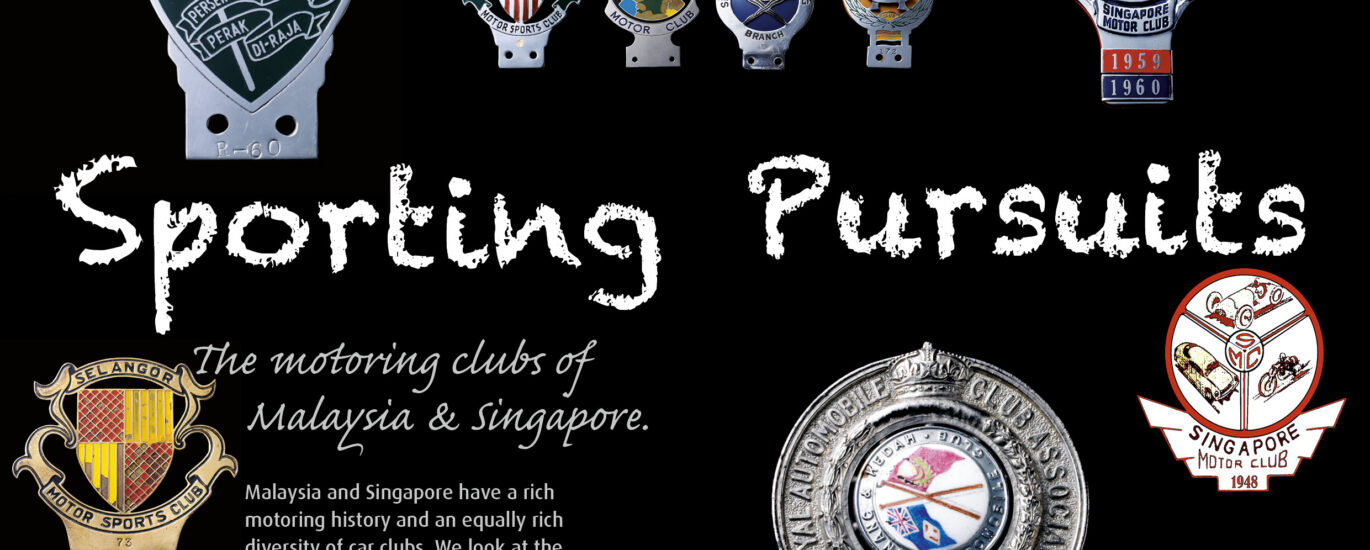
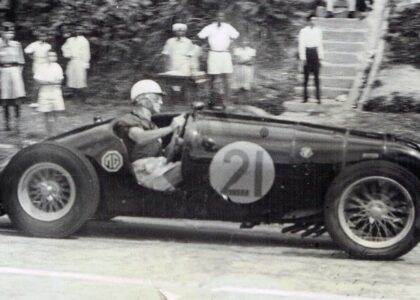
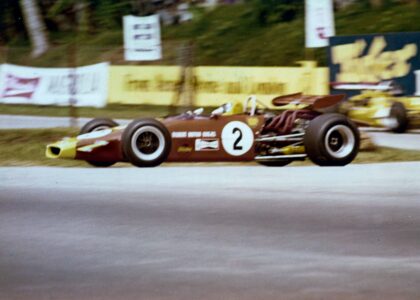
One thought on “CLUBBING IN SOUTH EAST ASIA”